MATERIAL THINKING AND MAKING
I LIKE OBJECTS
I have a little cabinet, I call my wunder-cabinet, in my studio. I like to fill it with found objects, it changes over time and is always a place of inspiration for my making and ideas, see photographic images below which was taken at different times over this project. I enjoy walking and collecting objects during a walk in nature, some photographic, but also bringing the physical object into my studio.
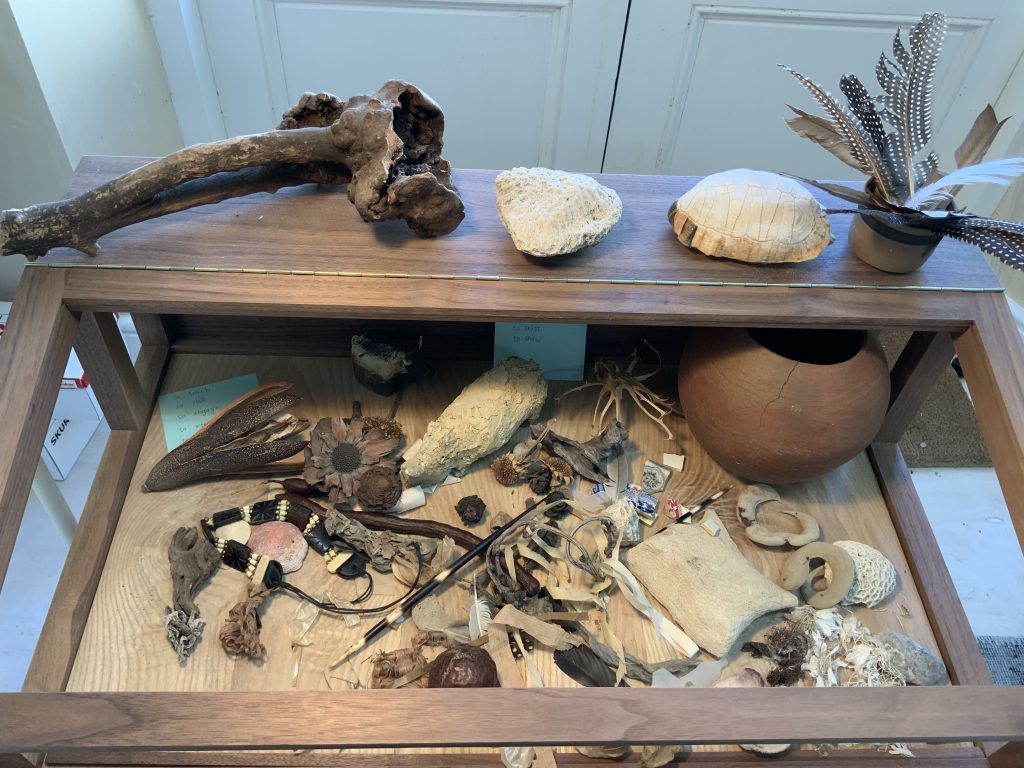
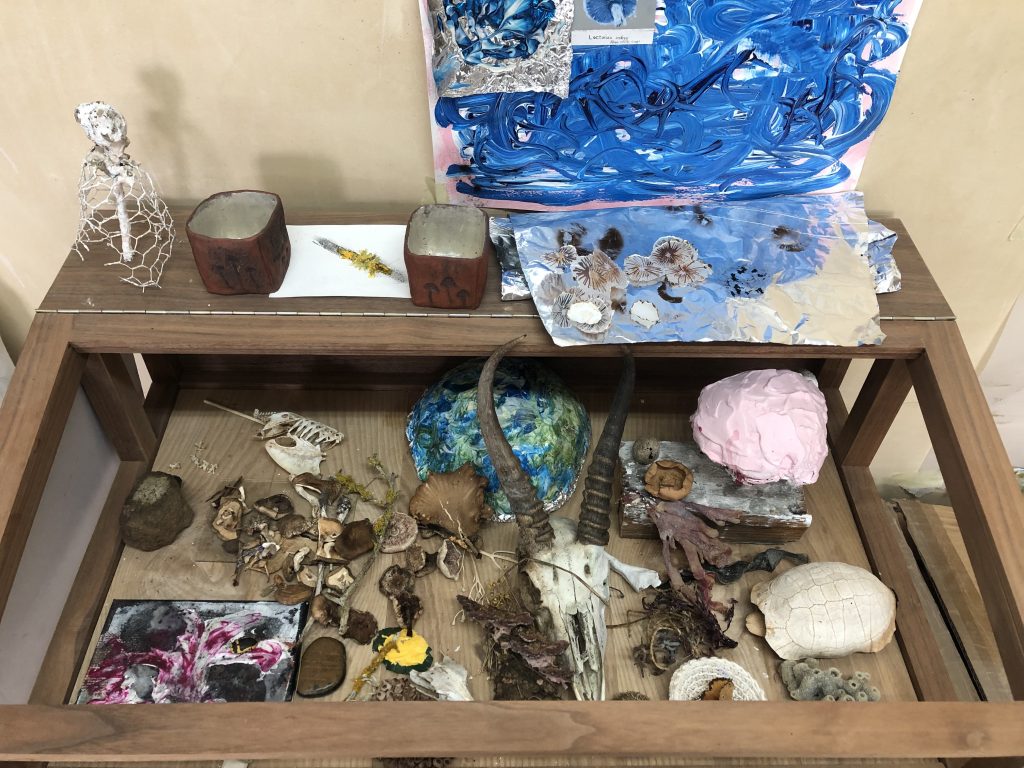
From the start of the Studio Practice course, I was using Japanese paper and later considered making my own paper with mushrooms during this project. On a local Mycological FB group, I belong to, a mushroom paper-making tutorial was shared. (posted by a member, Vanessa Hansen, 21 Oct 2021, Fungal Materials &Biofrabrication )I need to wait until I can forage mushrooms, as only mushrooms that have cellulose (growing on dying trees/plants) will be able to work as material. The form of the 3D objects I was making became sculptural and led to the exploration of new materials such as expandable foam, bongo clay and polystyrene. I needed to understand these intuitive links I was making between different objects, and it became clear that this would take some time to get to a visual coherence in my making. I do know that it has to do with my intentions to explore gestural marks and shapes and how they relate to objects, but later I could see how I could link them to Fungal forms. I have always preferred to work with found objects, or re-purpose them, and see possibilities of creating them in this process.
When I consider the projects I am working on, I want to start at Part Two of the course material for Studio Practice which is mostly about how a painting deals with pictorial space and how we experience or express that space (viewer and artist). It is also important to mention that by this time I was working on a project with a student group called the Wander Wide Web, with the intention of collaborating and making work which would eventually be exhibited – we came to see this project as an online residency and the exhibition was also planned to be online. I committed to working with (responding to) a textile student, who was making 3d objects. I was battling between the literal and the making. My interest grew to know more about the Fungal Kingdom as well as to make work which finds kinship with the work Annette (textile student from OCA EU group) was making. This was an uncomfortable space to push through. Later when in a tutorial we discuss the work of Ian Kiaer I felt that I was getting to a place of understanding how I could use different things to find relationships. I am open to many ideas and new learning at this point and value how my tutor was pushing me to explore these relationships and how it could all come together.
I looked at the cultural history of fungi and Fig. 3 and Fig. 4 below captured my attention, when I read Sheldrake (2020) and he shows an image with a collection of mushroom stones from Guatemala which was photographed in the early 1970s. It seems that around two hundred of these stones survived and they are linked to the ceremonial consumption of psilocybin mushrooms which dates back at least until the second millennium BCE. My drawing called Fig 5 is clearly influenced by my work on the little Infanta (see Studio Practice course work) I can imagine developing this as a 3d work.
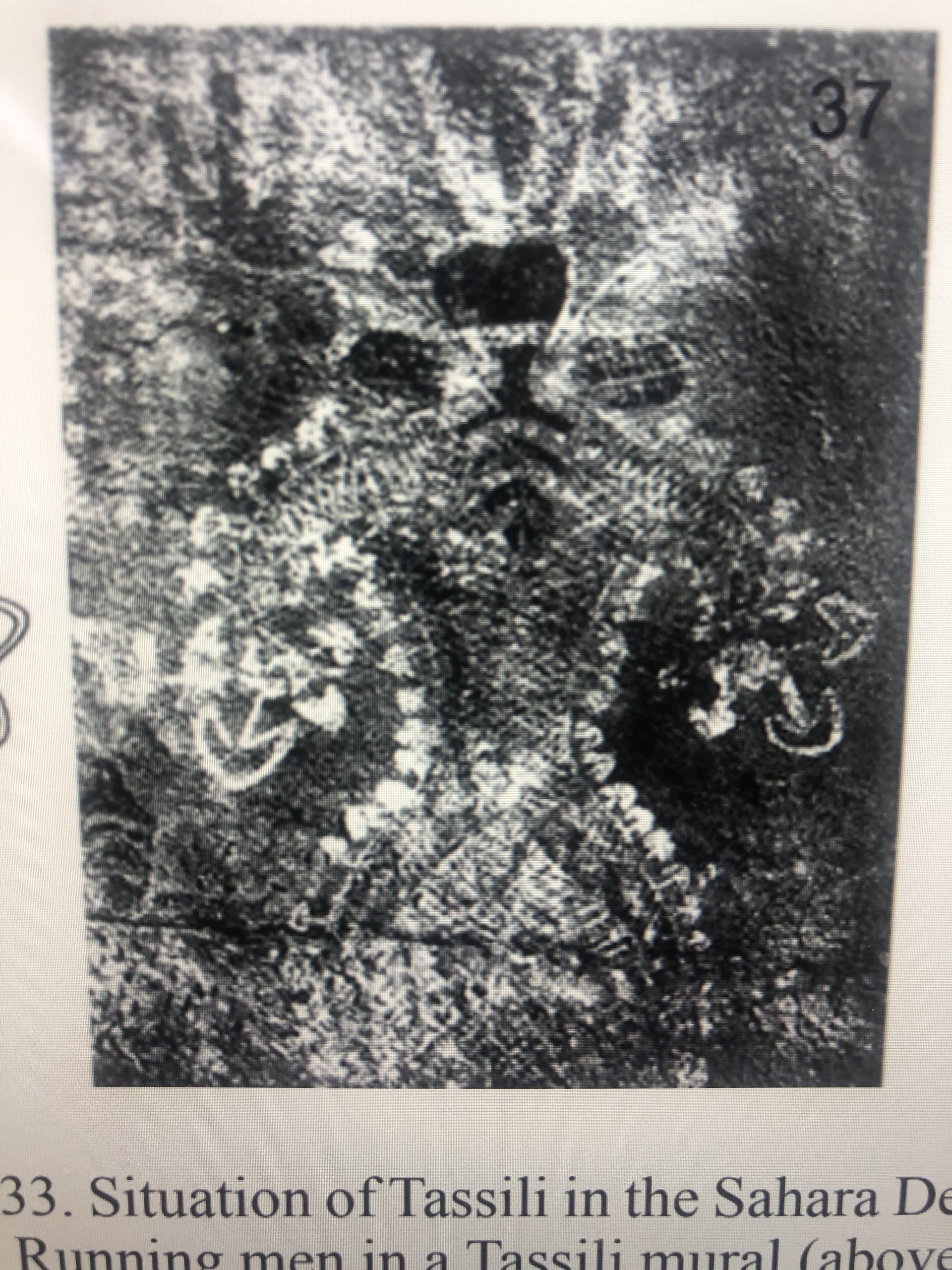

( Denver Museum)
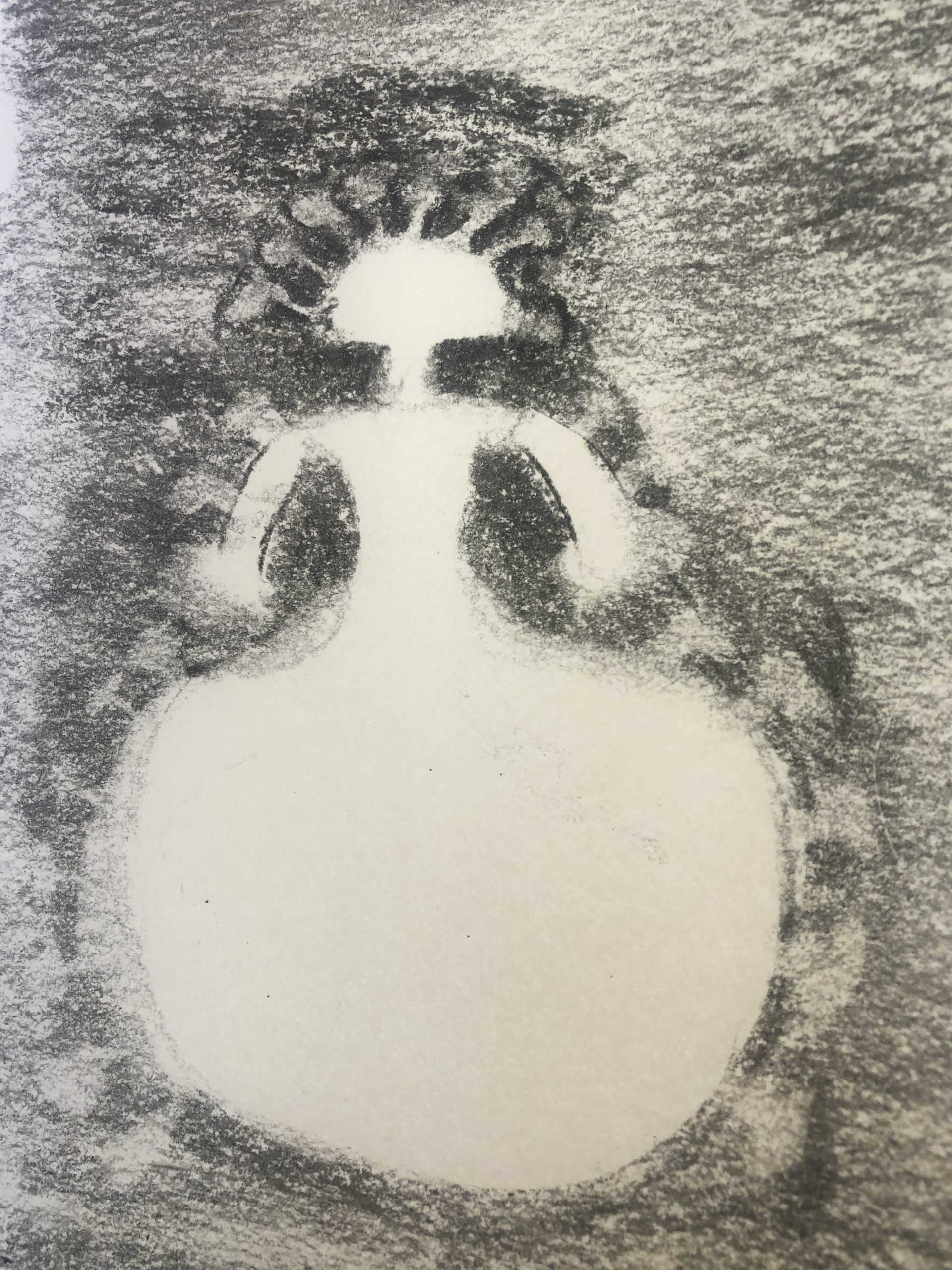
The canvas behind the object in Fig. 6, below, is made of linen. Why have I hesitated to use the canvas? Juxtaposing it with my made object, which I covered with cloth (a rag used to clean brushes, see image below) brings some tension to ideas around my own ambiguity around painting. Will it be a painting or sculpture? Can it be part of an installation/performance?
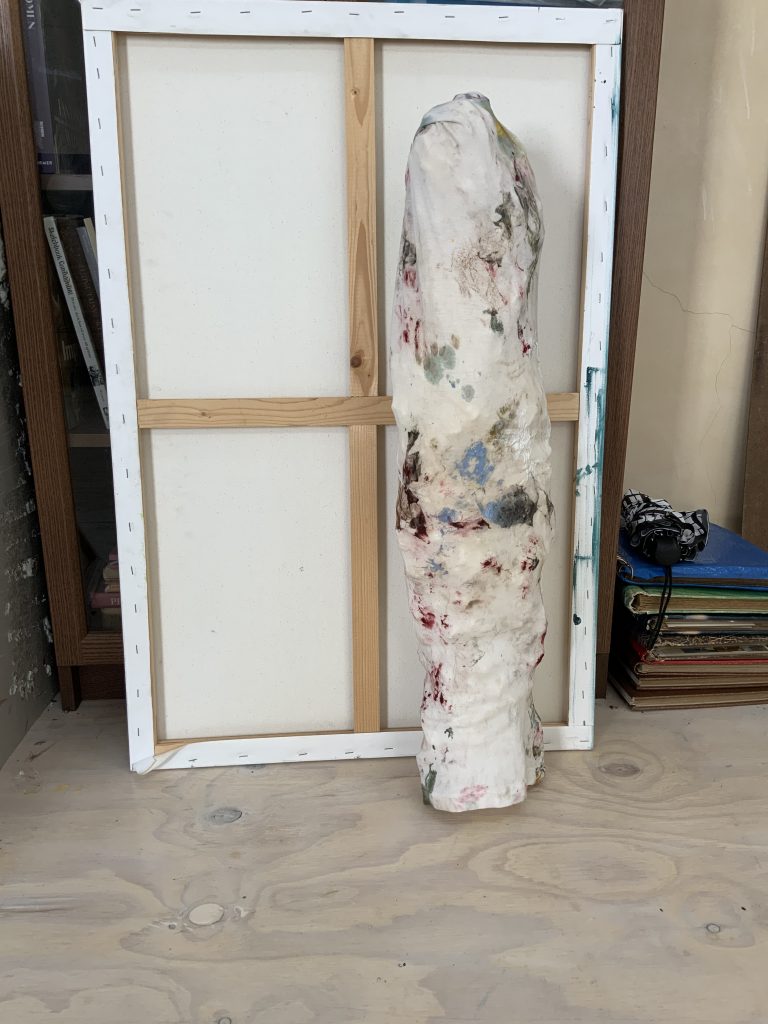
I do like that the cloth ( Fig. 7) is a part of my recycling efforts. It used to be clothing and then became an item I used in the studio to smear access paint. The possibilities of it as an object was explored with this work when in Part Three of the study material we looked at Prop, Performance and Stage and had to select one or more items of clothing which would be used as a reference point.
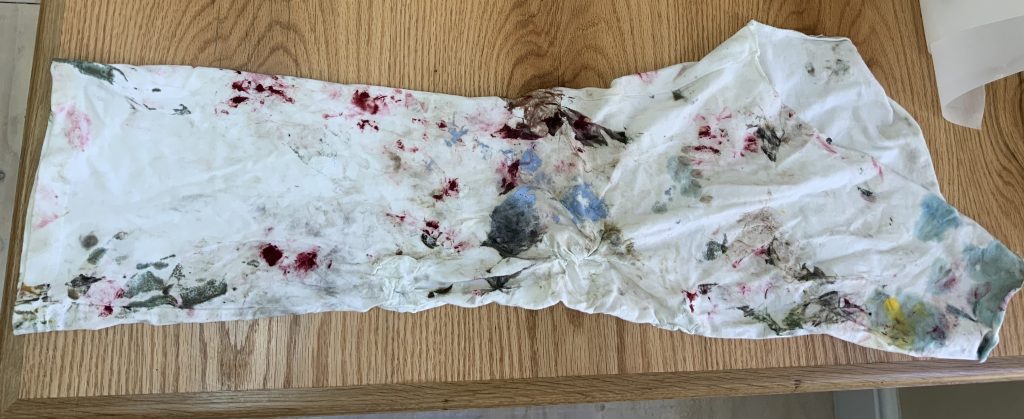
I chose a black dress and re made it with paper. At that stage, I used the foam object as seen as Fig. 6, but without the ‘canvas’ around it. It represented a body part – a leg. In Part Four of the study material I was challenged to explore painting with or without a canvas. By stretching the fabric over my made object it becomes a new work, as well as bringing a history of its own along. I can visualize a mushroom sprouting from this object. These exercises were inspired by my research into the work of Hungarian born artist, Simon Hantia, who invented a technique called le pliage come method (folding as method) and I explored more with fabric in the next projects of Part Four.
I am moving away from the canvas, the object has properties to become beyond what it is when I make an assemblage. Could it be that mushrooms and their mycelium are becoming a “giant metaphor for creativity“, as someone commented on my Instagram feed on 27 January 2022? I think about the form as an enlarged stem/stipe/stalk of the mushroom. The stem is the base onto which the cap of the mushroom is mounted. Its function is to thrust the cap above the ground so the spores can be discharged into the air. (Mushroombook, p 16)
I am thinking of the word foam as a material or substance that is soft and even malleable: in my making, I had by now learned that it is difficult to control form with the foam I have been using, and I, therefore, used the leg of a trouser as my ‘holding agent’ in order to control an envisioned form. The materiality of the foam allowed for the expansion within the ‘holding agent’.
I did look into how mushrooms make a foam when it is cooked:
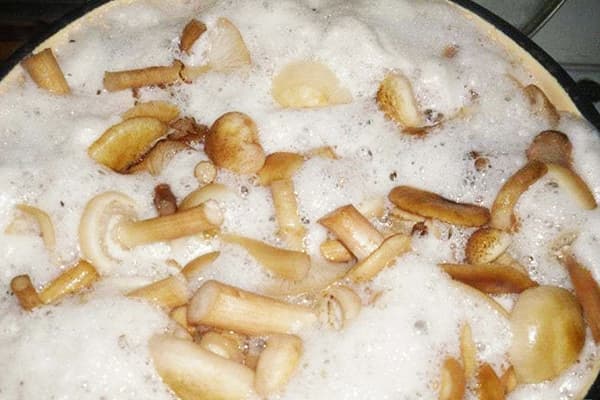
And know that chefs use foam of mushrooms in cooking by whisking together mushroom jus, foam magic and salt. This becomes a beautiful visual way of enjoyment of food. Later when I started foraging I learned about mushrooms which is puffy or slimy and discovered an Ink Cap mushroom from which I ‘harvested’ ink to paint with. In using expansive foam as my material, I attempted to manipulate it into forms; the material adds to the fact that they become ‘artificial’ – I made them big, not the natural size. I think I could say the form represents altered states of being a mushroom.
I developed a painting of this ‘foam’ object and linked it to the veiled mushroom form I was attracted to in my research. In 1845, Alexander von Humboldt described the natural world as a “net-like, entangled fabric”. According to Sheldrake, Fungal mycelium makes this net and fabric real. Some species of fungi form complex symbiotic relationships with the roots of trees and other plants. We describe these relationships as mycorrhizal. The idea of imagining net-like and entangled fabric stayed with me in terms of how I could make and explore work.

I do wonder how this material affects the way this work above, (fig. 10)will be perceived. I do not think this work needs more, like a cap, to be a mushroom. It reminds me of the drip paintings of Pollock, gestural marks, as well as a palette of Twombly. Its form is a 3d sculpture. After sharing it on social media there was feedback that the colours remind of mould: reminding of fungi?)
Fungi are the composters nature offers us, Sheldrake calls them ‘metabolic wizards’. (Sheldrake, 2020:10) They make me aware of ecosystems and demonstrate inter-dependency, something we as ‘individualised’ humans shy away from. I can look at this object as a re-interpretation of this life force of the fungi. My tutor made me aware of the artist, Ian Kiaer and I like the idea that he, as critic Jonathan Griffin writes: ‘Formally and philosophically, tests the propensity of things to hold together, to prise apart or to float irredeemably away from one another. The conclusion he arrives at, more often than not, is the latter.’ I learned from my research into his making, that Kiaer is interested in the physical legacies that used materials introduce, in his research into the art of reclamation he found these conceptual foundations and brought them into his making. He considers the idea that one makes something from scratch as always false. To him, when making, the artist is involved in a conversation and takes up what someone else has already said and developed it. (this learning refers to my tutor feedback session after Part Four of the course, to be found as Notes on Tutorial on my website: )
I found a work by the artist, Rodney Graham, The Green Cinematograph (Programme 1: Pipe smoker and overflowing sink) This is a film which, according to ArtForum (google search) tests the Kuleshov Effect. I understand this is an editing technique that causes the viewer to create a connection between two different scenes. In this work, the artist uses an old cinematograph and reverts between images of the artist smoking a pipe and bubbles being filled into a sink. (I would say he juxtaposed these sequences) So it actually means that meaning is made only by editing. I think about the difference between ‘editing’ when I write this blog and showing my making, (choice of visuals) in both circumstances during the making process on choosing what to show ( what to hide/discard) and how to arrange it in a particular order. It becomes clear that the metaphorical meanings of such actions are many and these possibilities are (have the potential/power/agency) for the spectator for interpretation.
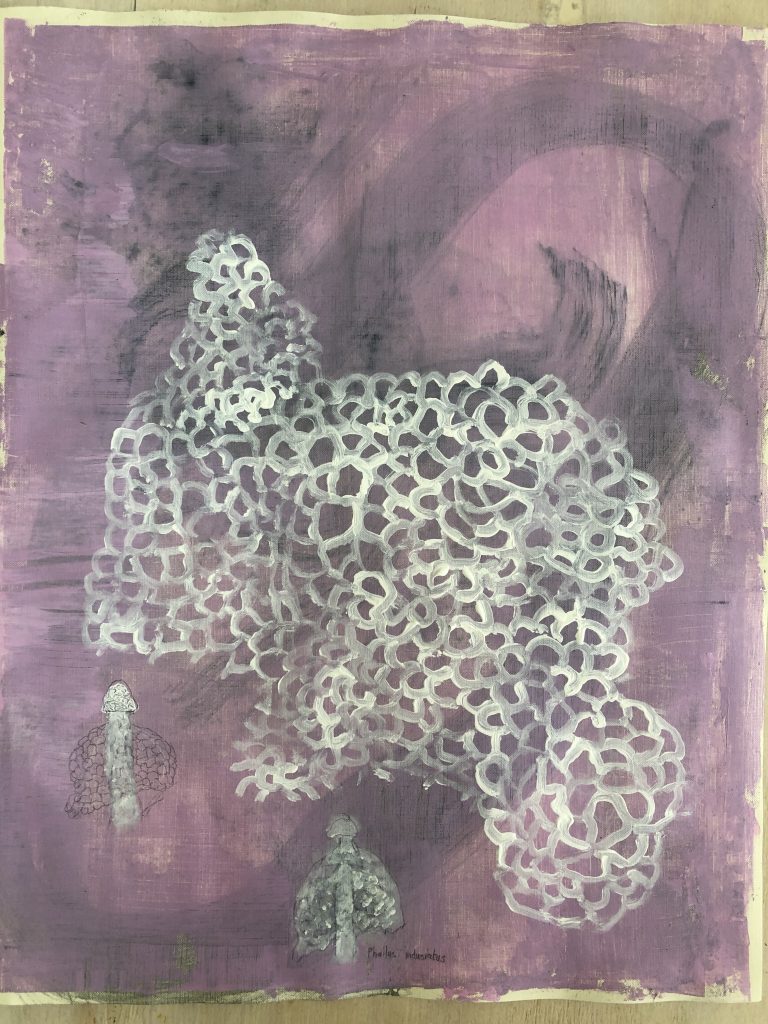
I add this work after reading about the work of Rodney Graham. I think the two works can share a space and give new meaning to the subjects investigated in these paintings.
Afterwards, I tried to hollow out one of the objects I made from foam. Later, when I started working with clay I made a small clay image, by hollowing out and forming it into a mushroom shape. By now I realise form and shapes have become visually attractive to me.
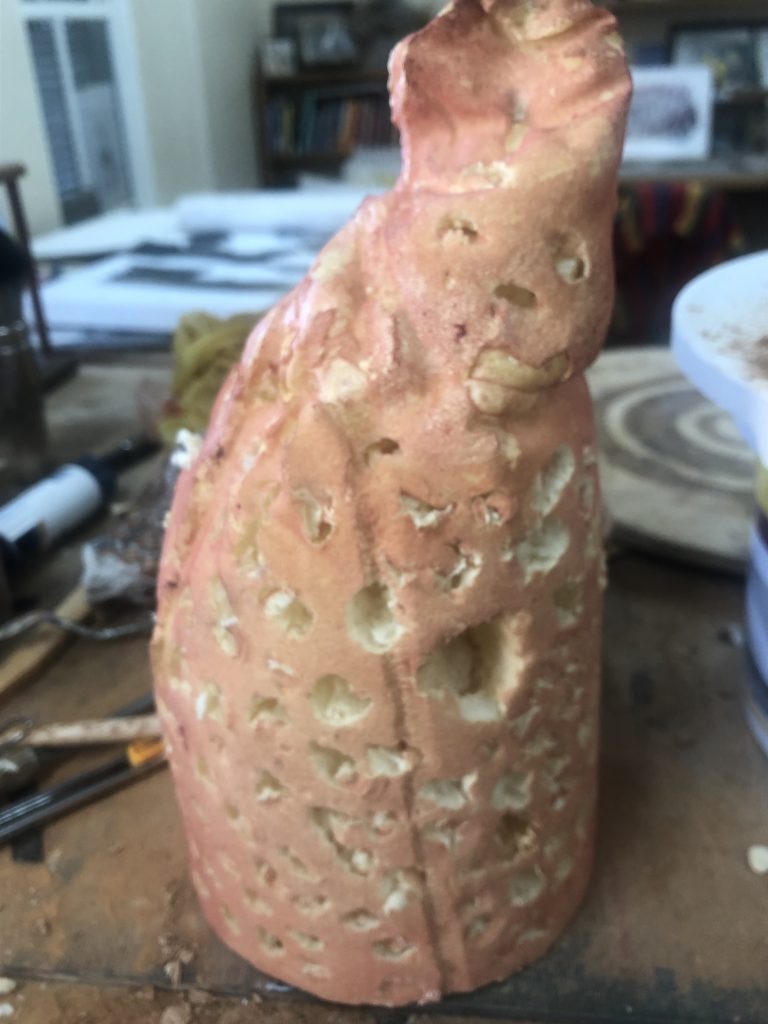
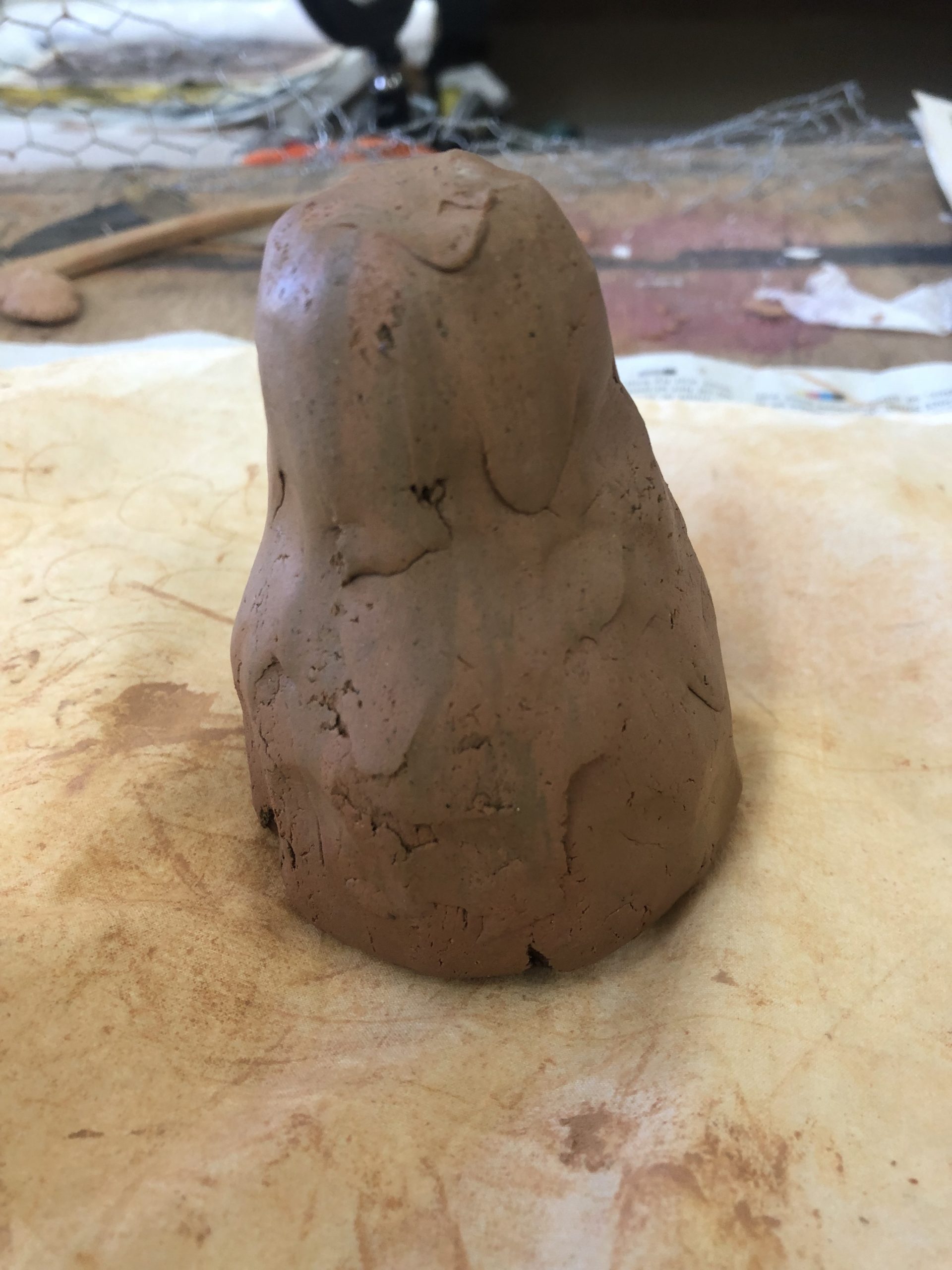
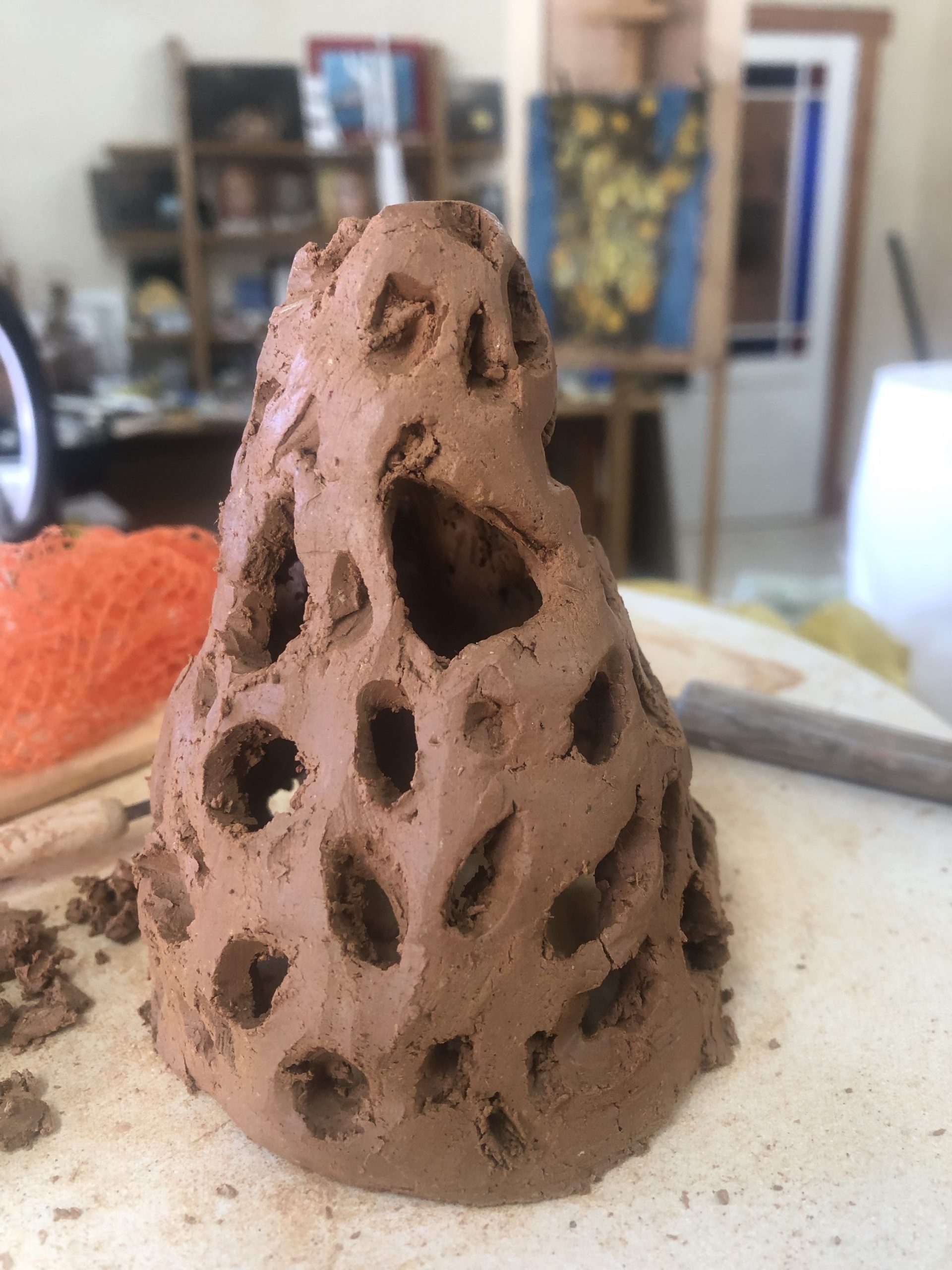
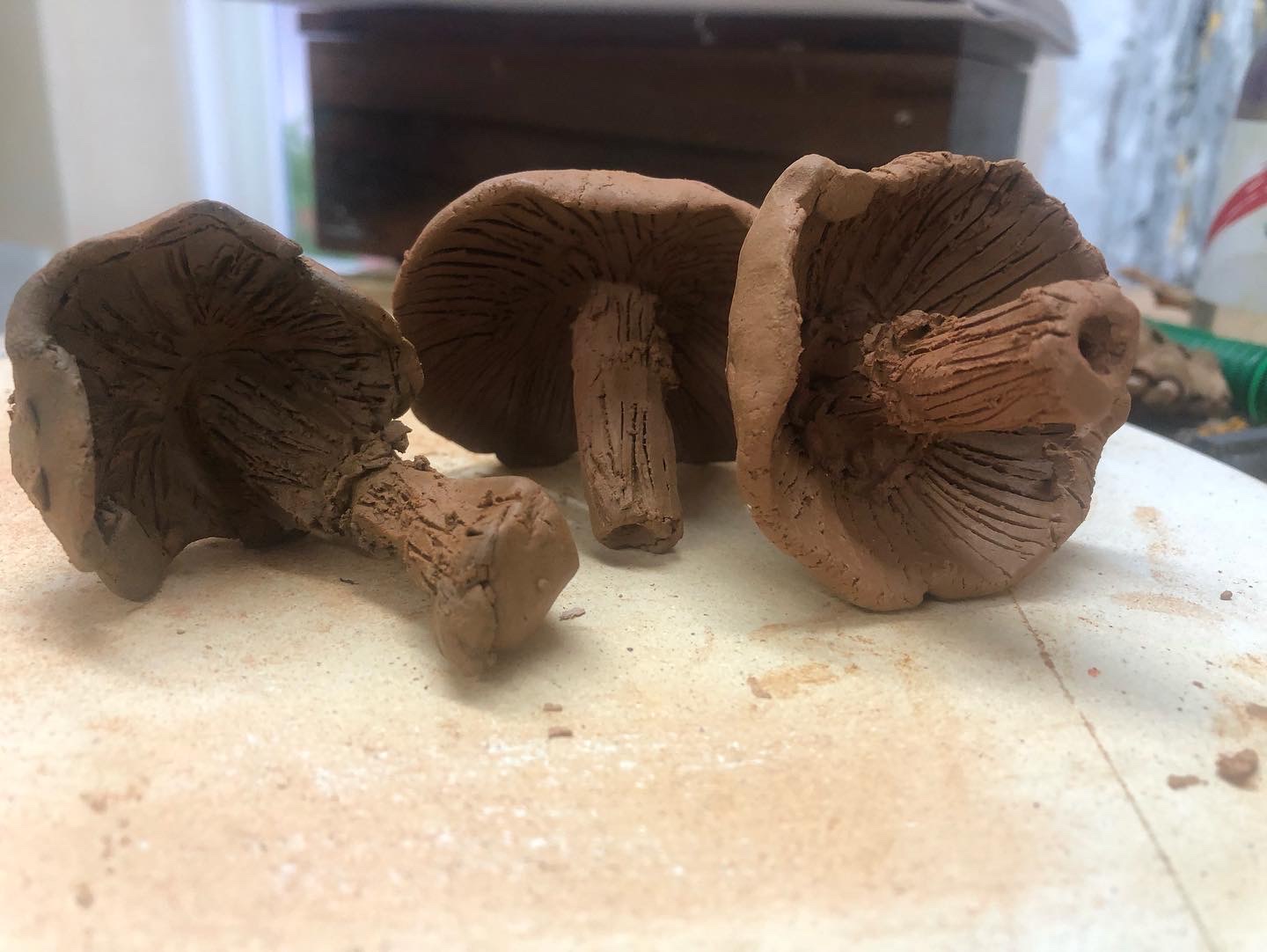
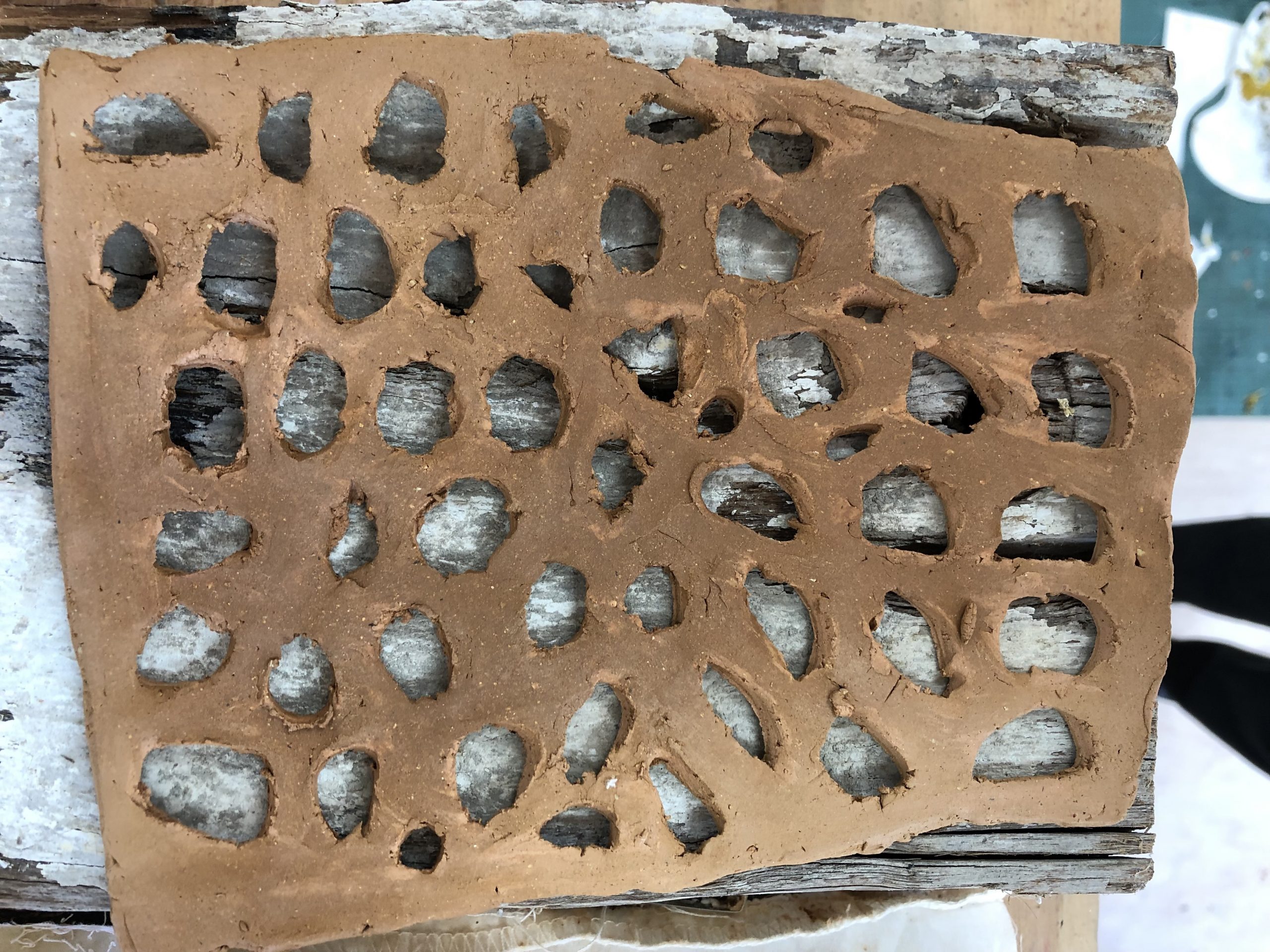
I wonder about Tsings’ ideas of an ‘always-in-process collaboration’ (Tsing, 2015:14). She talks about a curiosity that we need as the first requirement of collaborative survival in precarious times. I do feel that modernization and progress have not really come up with answers to many of our hows to live life in the current moment – answers to pollution, extinctions, climate change, and the Covid virus. Could it be that the fungal world has some answers? In Tsings’s writings, I visualize our landscape as a ruin, everything has been touched by the human hand or is disturbed. She paints a vivid picture of a mushroom, the Matsutake, which emerged in these devasted landscapes – like that it was the first living thing to emerge from the landscape in Hiroshima after it was destroyed by an atomic bomb in 1945.
In Part Three of Studio Practice, we looked at an object as a stand-in for the body: I wanted to look at this foam form ( Fig.6 )as a stand-in for a mushroom.
I associate the foamy material it is made from with the spongy feel of a mushroom. It reminds me of what I read about the artist Lynda Benglis, where her work is seen as an exploration of shapes and using a wide range of materials to “render dynamic impressions of mass and surface: soft becomes hard, hard becomes soft, and gestures are frozen” (Pace Gallery, L Bengalis exhibition, Aug 21-Oct 23, 2019). I can place the mushroom in different locations and photograph these explorations. I also think is important to consider how a viewer will be affected by it.
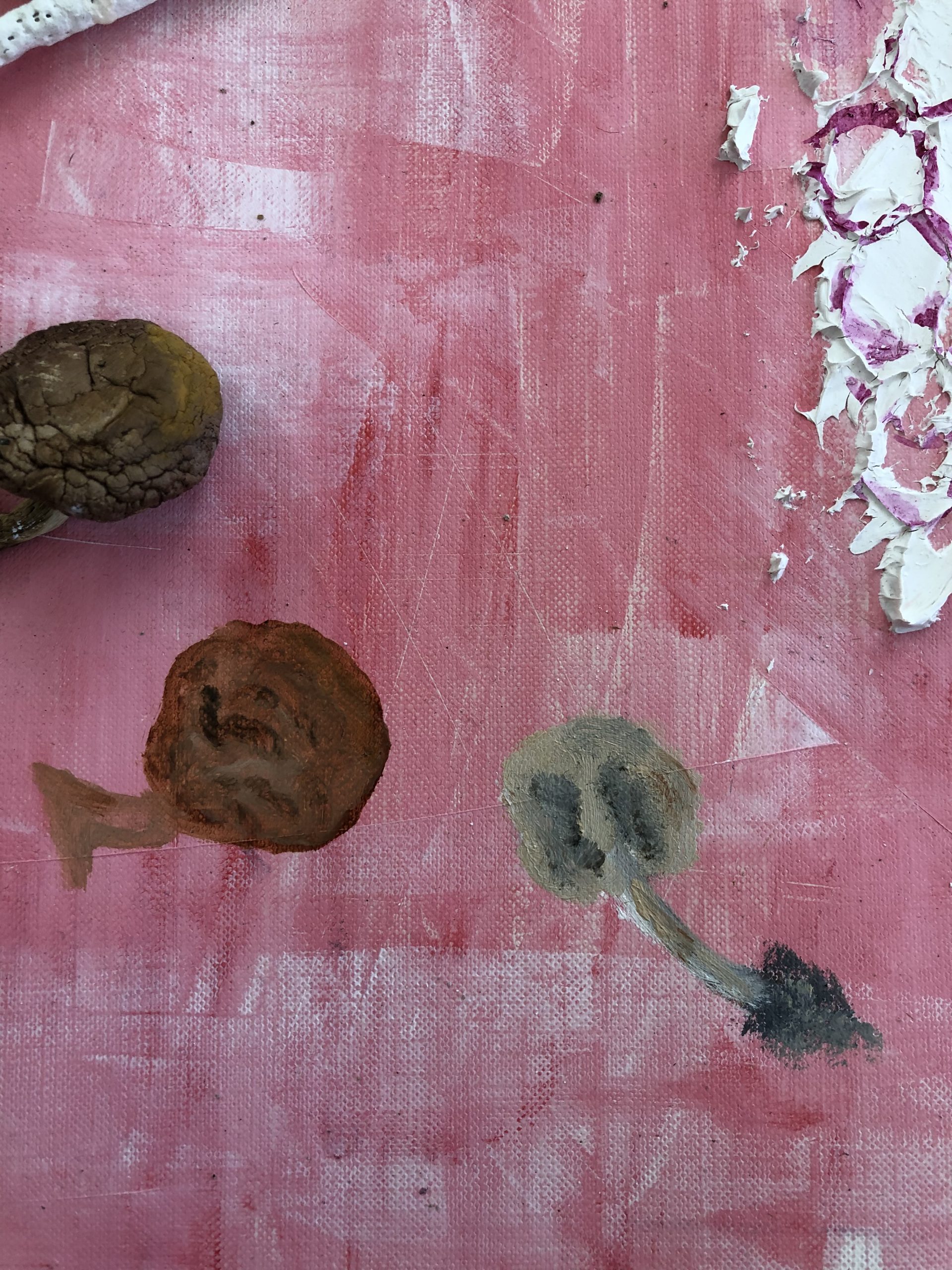
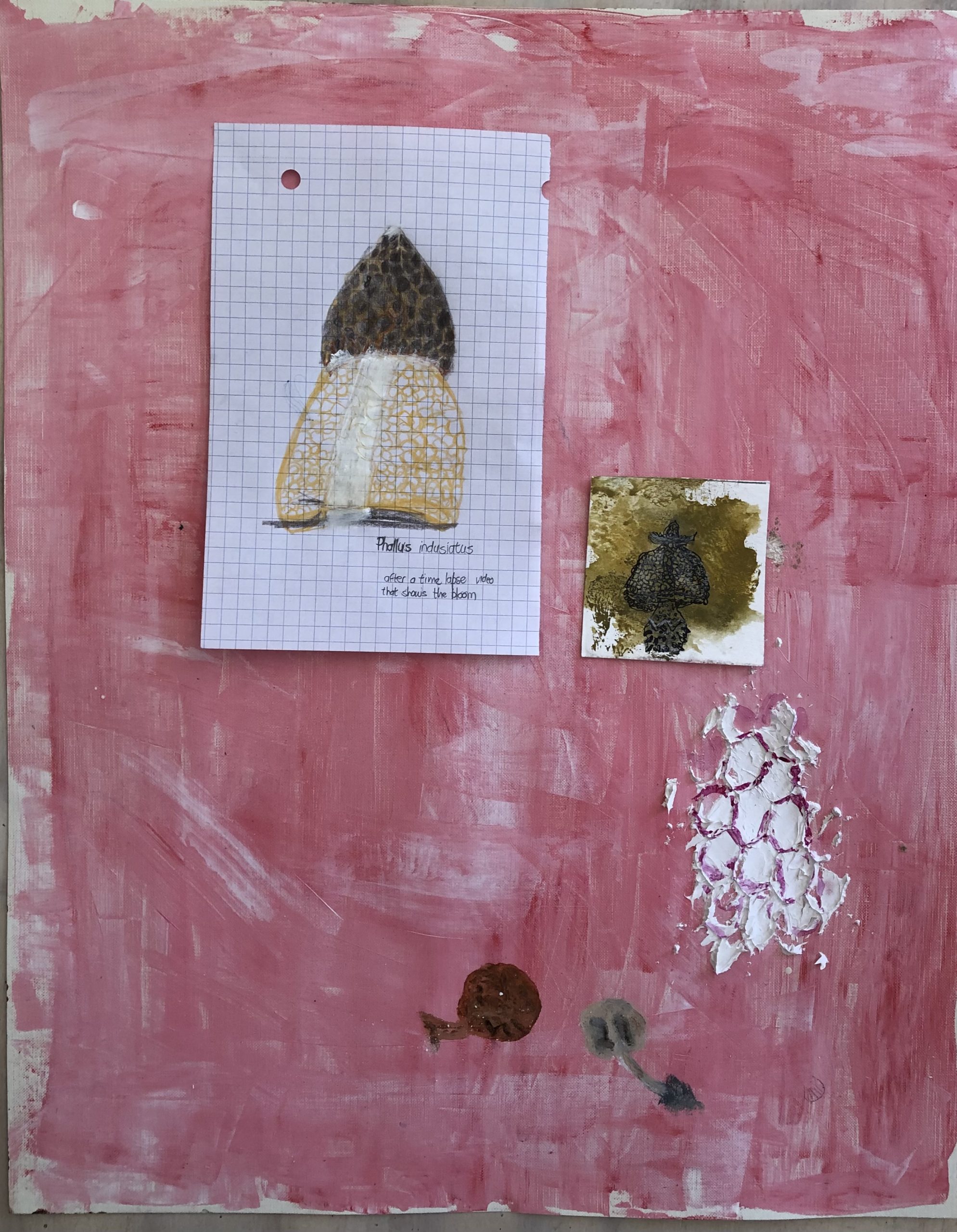
Looking at the above work, a while after making this foam object, and considering my tutor’s suggestion I look at the work of Ian Kiaer, my mind was opened to more making and thinking about materiality and my own ability to ‘grab hold of’ things and go and explore it materially. I value that my tutor encouraged this energy or way of thinking and making. I saw the possibilities of exploring the ‘cellular layer’ in this work. It opened my mind to look at these structures or objects as the same things that could have a conversation.
The developments of a series of works can be seen later in the project, under the heading, Considering ideas for painting and developing resolved pieces. Here I consider the work of Twombly and explore form, materials, written language, and colour. I would like to see the work develop as an idea of looking at the network of mycelium, a rhizome type development, and of decomposing as a form of deconstructing the work.
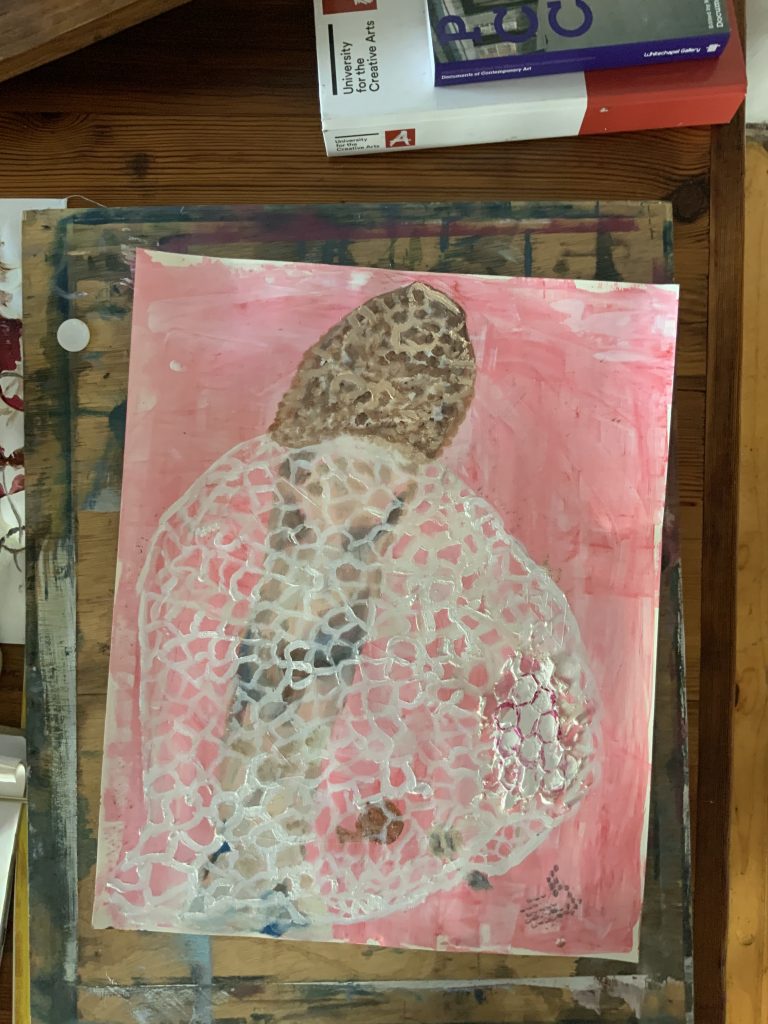
I continued thinking about developing the above forms and shapes of the mushrooms which intrigued me. for being natural forms. and implicating nature in the process. I would like to make bigger work and develop something on steel or aluminium to hang in the same space as the paintings, drawings and 3D objects I made.
MAKING MUSHROOMS AS 3D OBJECTS
I thought about the caps of the mushrooms – rounded form, which has gills below and is mostly the part we would consider eating.
In the images below I show a smaller cap I tried to make with plaster of Paris and formed around the chicken mesh, see Fig. 19 and Fig. 20; I do like the hollowness of this object. I later placed it on a ‘stem-like’ object to become a fungus, see fig. 25.
In Fig 21 – 22 I show a bigger ‘head’ or cap I made with Plaster of Paris – here I formed it inside a rounded surface and used cloth on the outside to give texture to the form. I stuck to the Pink/Purple palette and wonder if I am moving ideas around the psychedelic side of the mushrooms with the making of a bigger form. I will consider this more in my making.
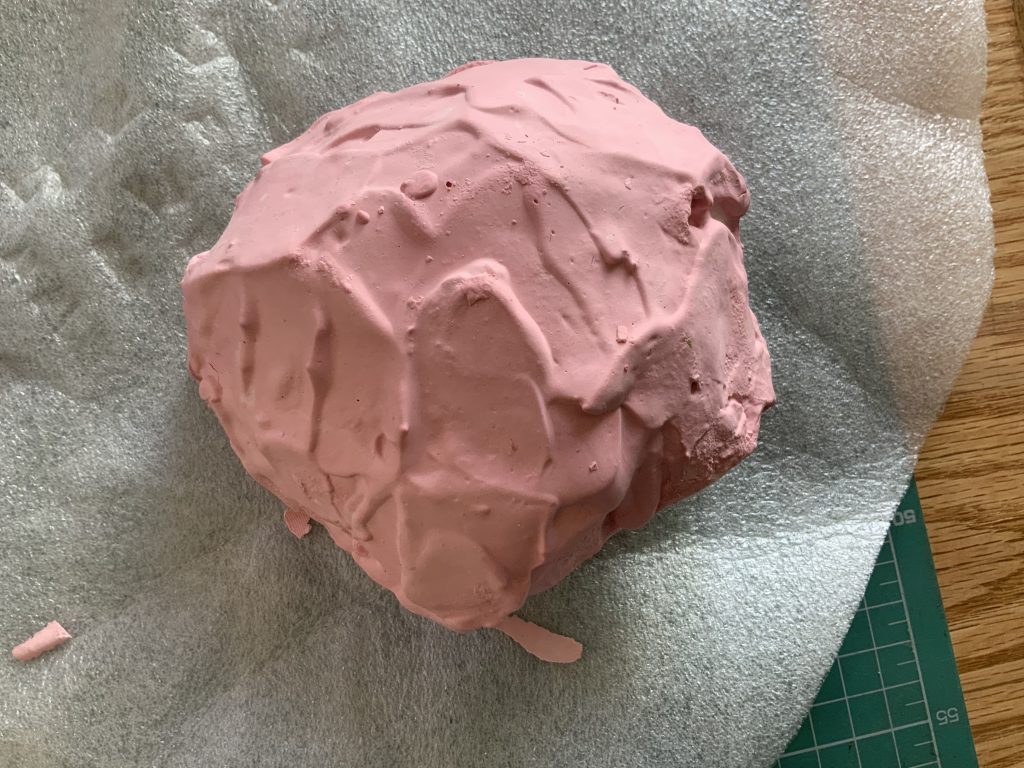
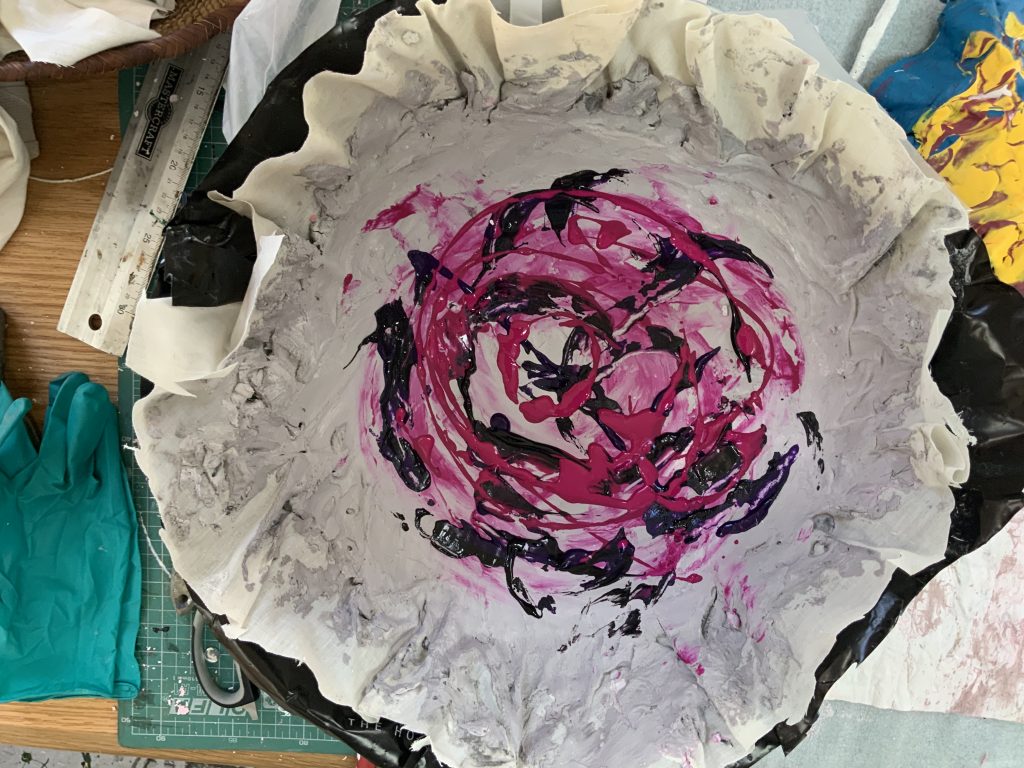
I bought chicken mesh and plan to use plaster of Paris powder to make the cap of the mushroom form. For cutting the mesh I needed a tool and it was hard and difficult to work with this soft, but rigid mesh. I decided to make a small maquette first and coloured the plaster of Paris with some Plum-colored craft paint (Acrylic) The pink colour reminded me of CY Twombly and I continued to explore ideas to work closely with him in mind. I have always thought of his work as personal explorations, like a person obsessed with drawing and exploring gestural marks and flow. In my research about Twombly, I became very aware that the works he did around the mushrooms for his series Natural History can also be seen as not just an exploration of the relationship between natural and human history, but could refer to our (mine for sure) almost relentless desire to classify, label and categorize the unknown. (Bastian Gallery). I hope to reach an understanding of this regarding my own way of researching the topic as a way to make art. When I started with Part 4 of the course and there was a direction to paint without paint – I became even more interested in the emphasis to create a material surface that could transform the canvas – be it texture, tone or colour.
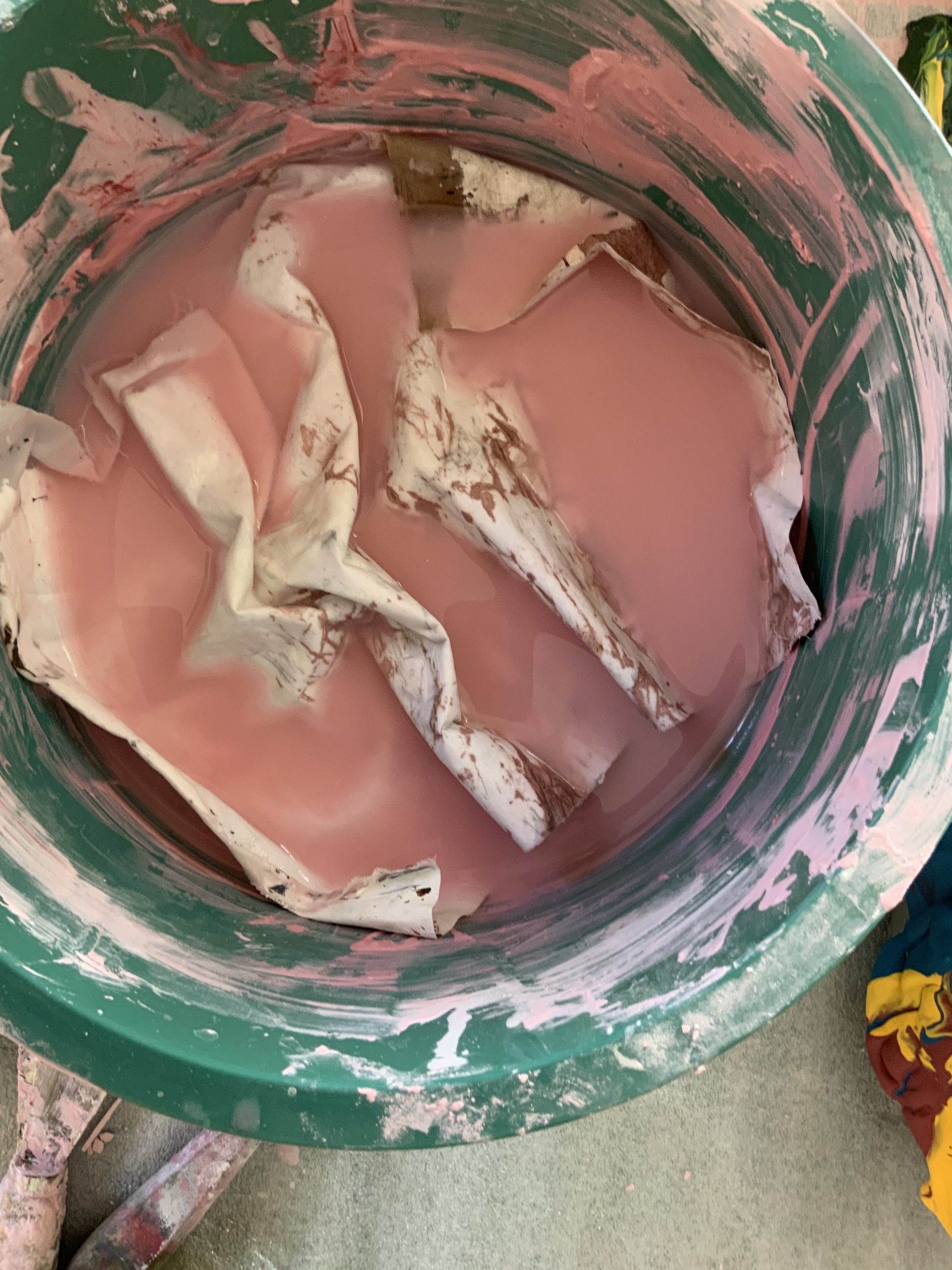
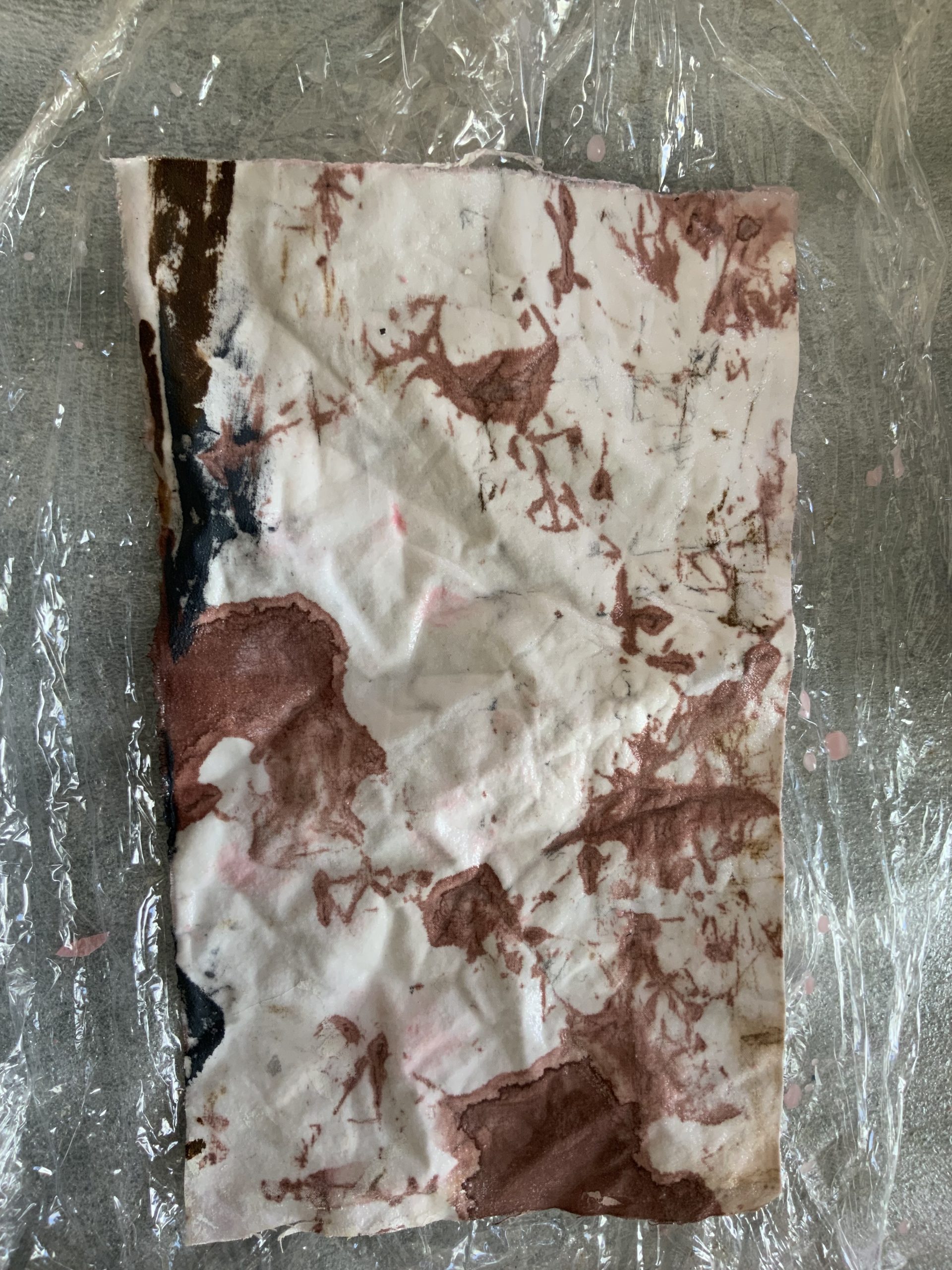
I do not think the bigger bowl-like cap, Fig.19 came out good – I do not like the colours inside the form and it is due to my adding the paints when the surface of the form was too wet, the paint became ‘stuck’ on the surface and I could not ‘interfere’ due to the fragility of that stage in the developing of the form. I however like the fragility and form of the object, as it reminds me of the natural form of fungi and how it does not last many hours in nature. I kept this object in the garden in front of my studio and over time it became very brittle and fragile. It reminds me of the decaying process – slowly time and conditions will make it deteriorate.
In Fig 32 – Fig. 33 I illustrate dipping a made piece of canvas into the Plaster of Paris and trying to create a mould like fungi ‘growing’ on the fabric. I know this is temporary and that the images will disintegrate with the handling of the fabric.
The image below can easily be resembling mushrooms.
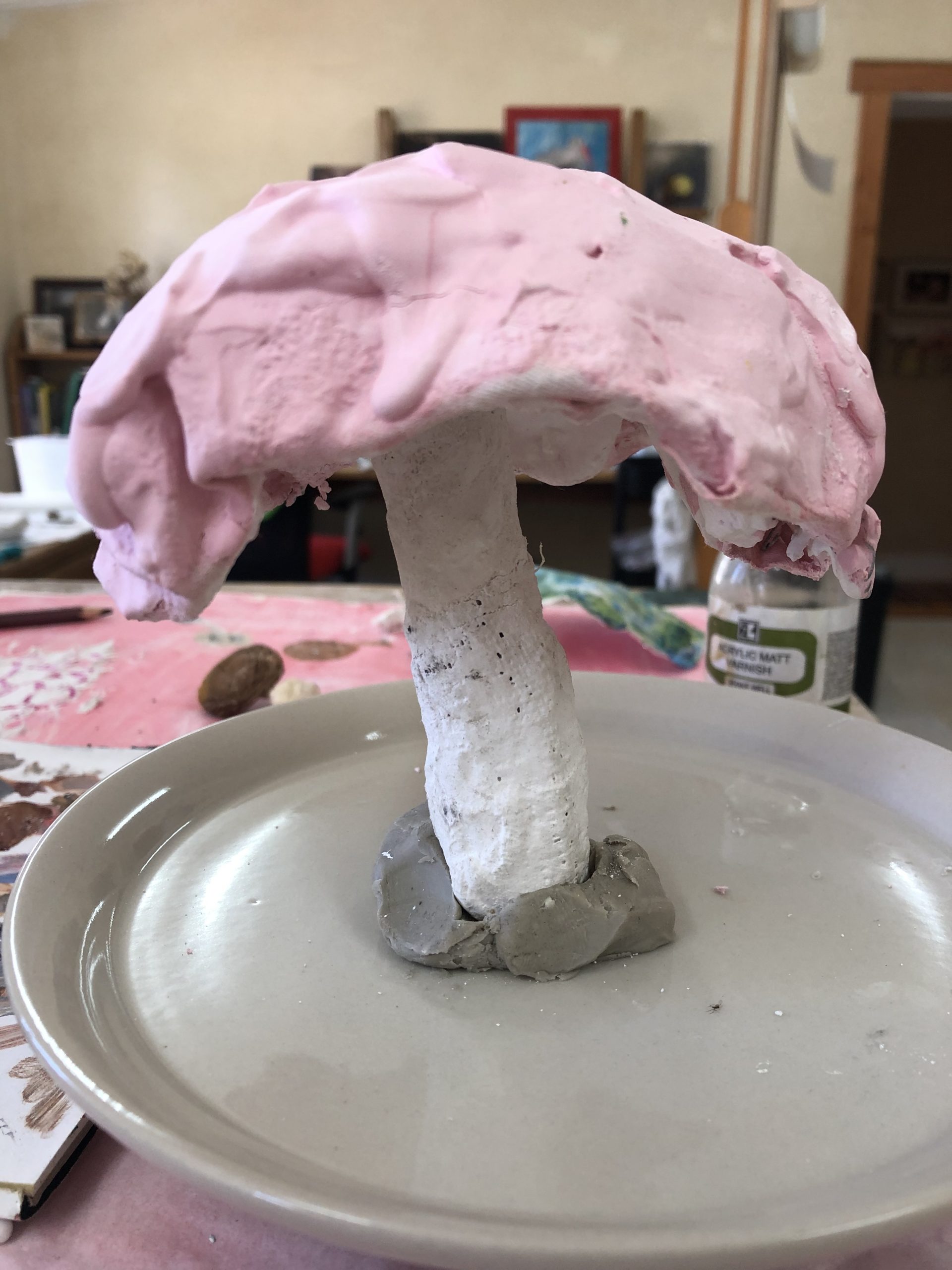
Looking at responding to the making of other artists who influenced me, I would say the following selection of works shows how the Fungal Kingdom started to influence my making in the course. Some of these works are exploratory and others are in reaction to the making of Annette Holtkamp and Cy Twombly.
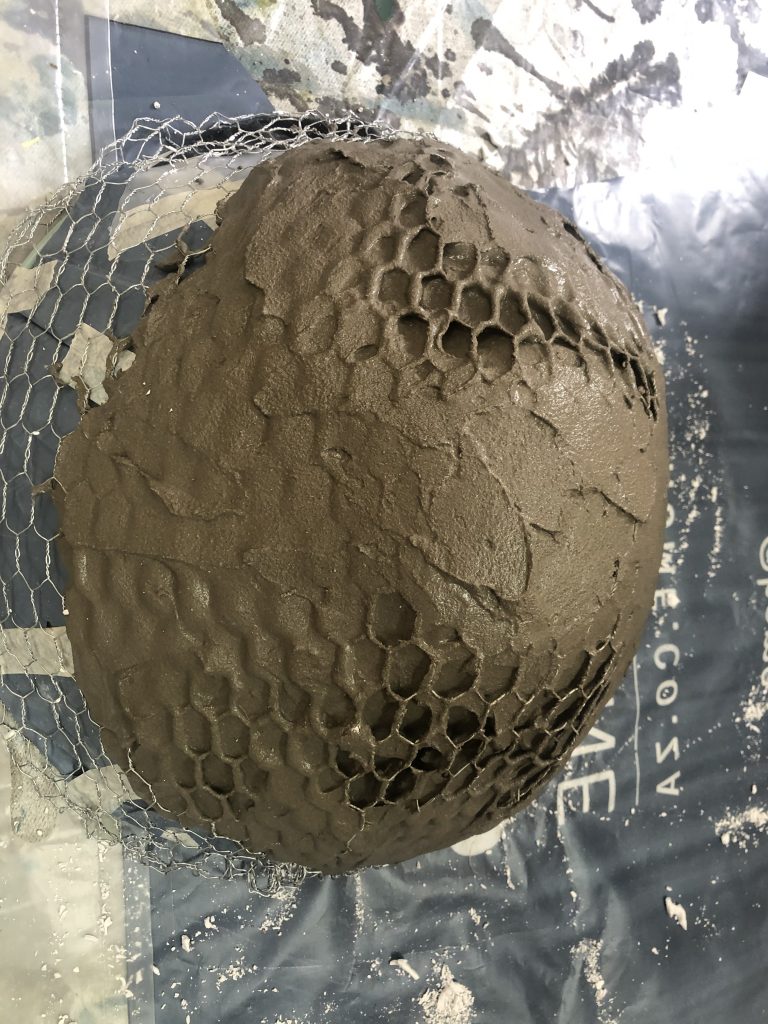
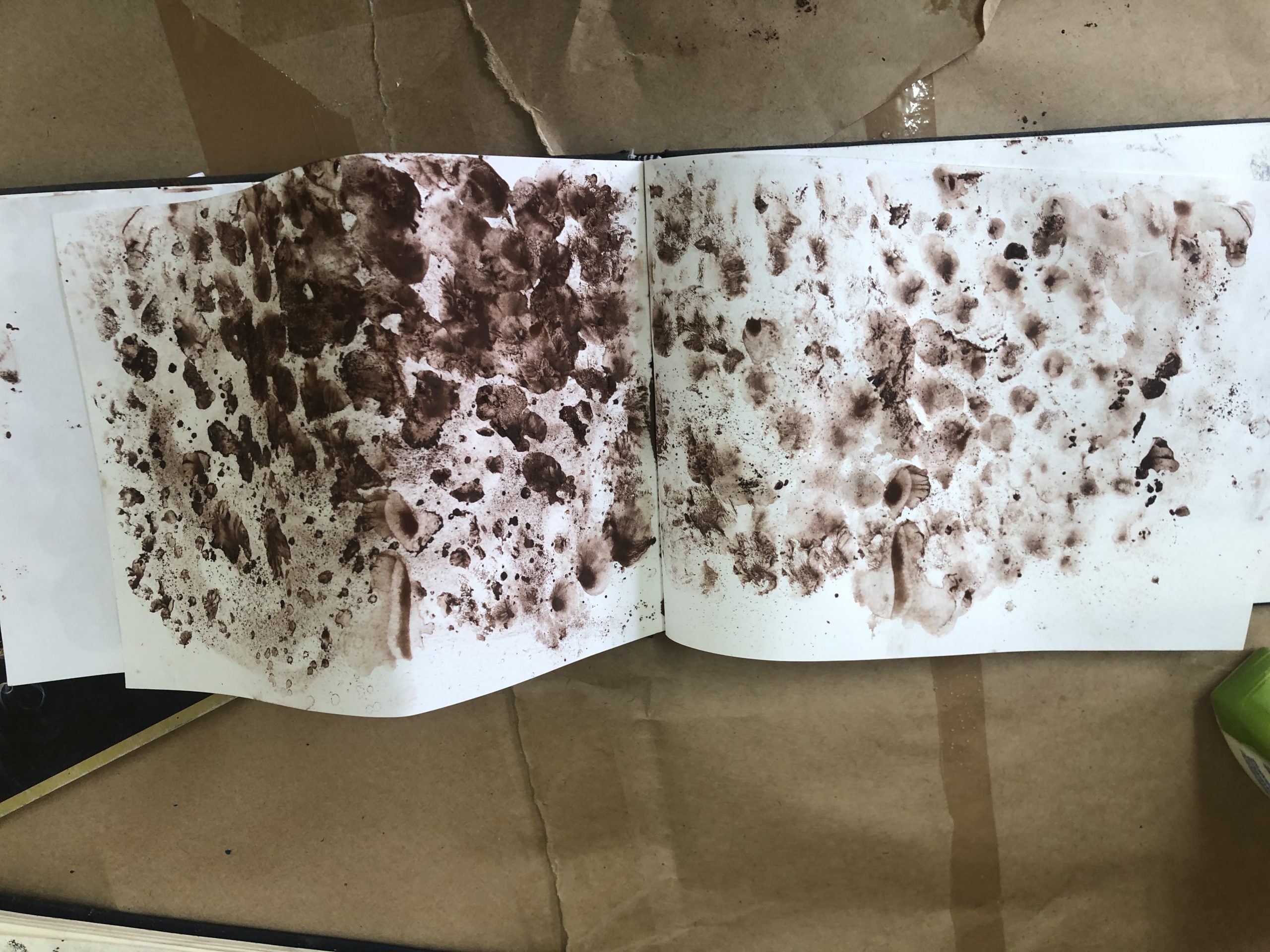
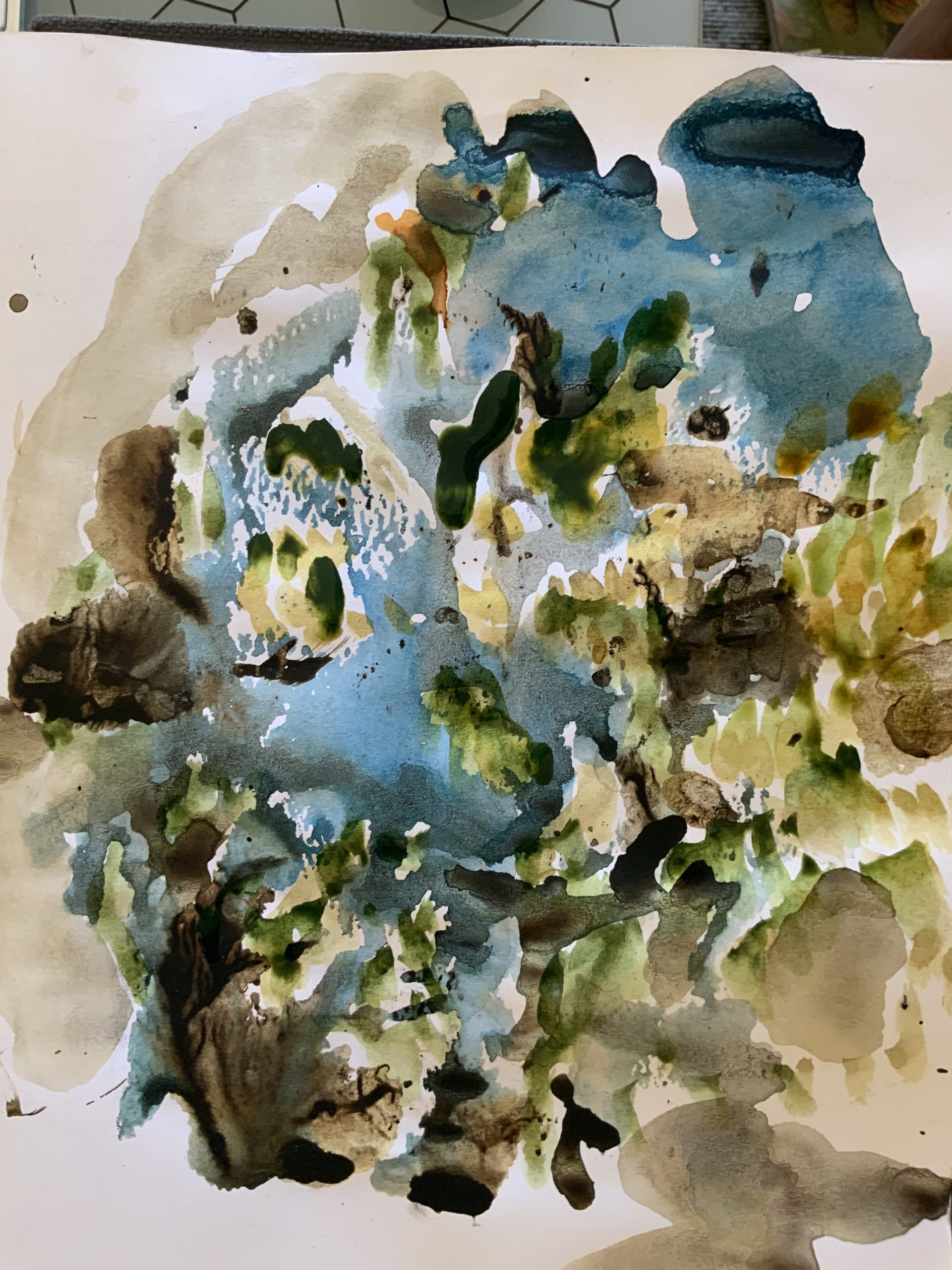
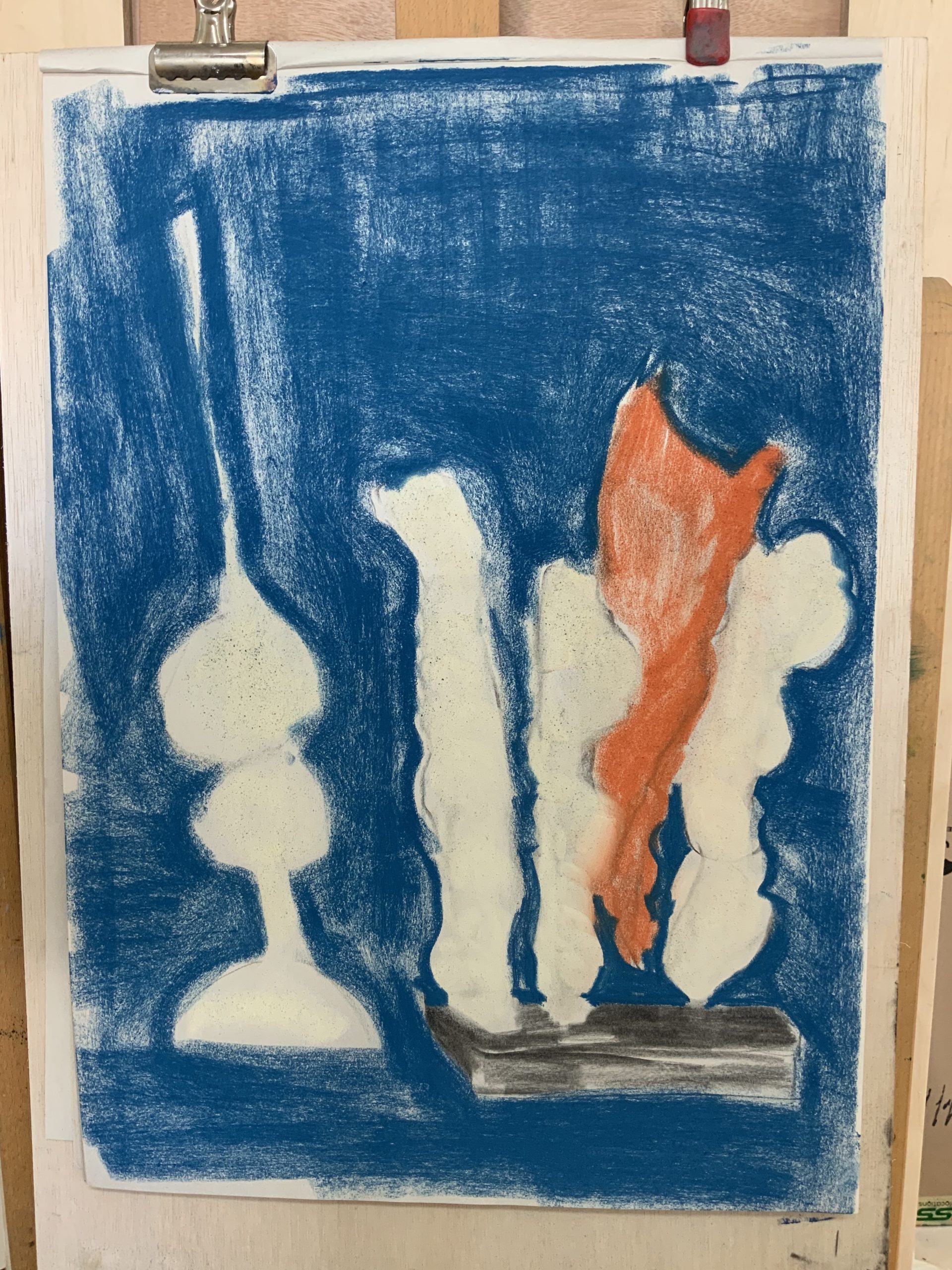
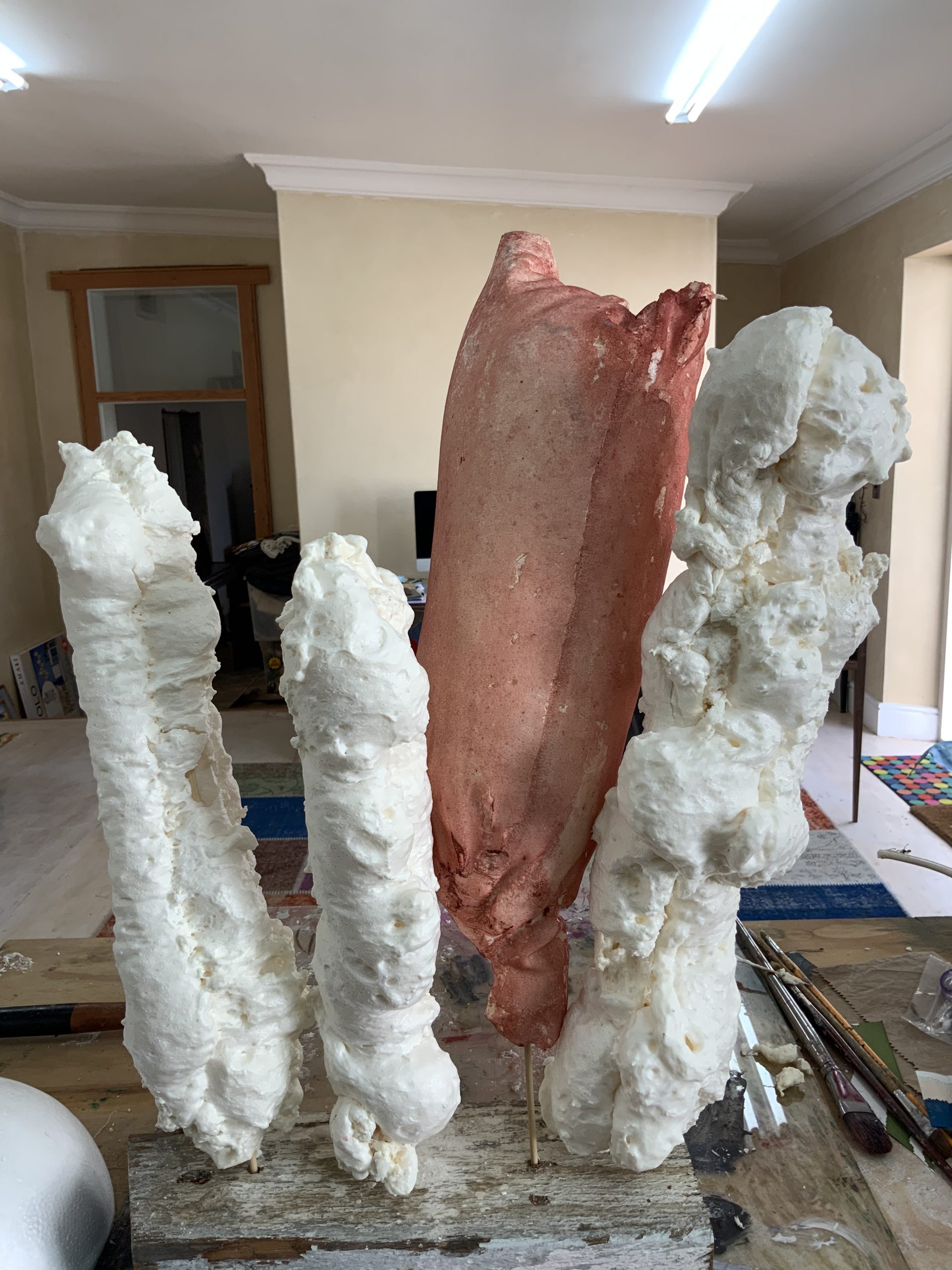

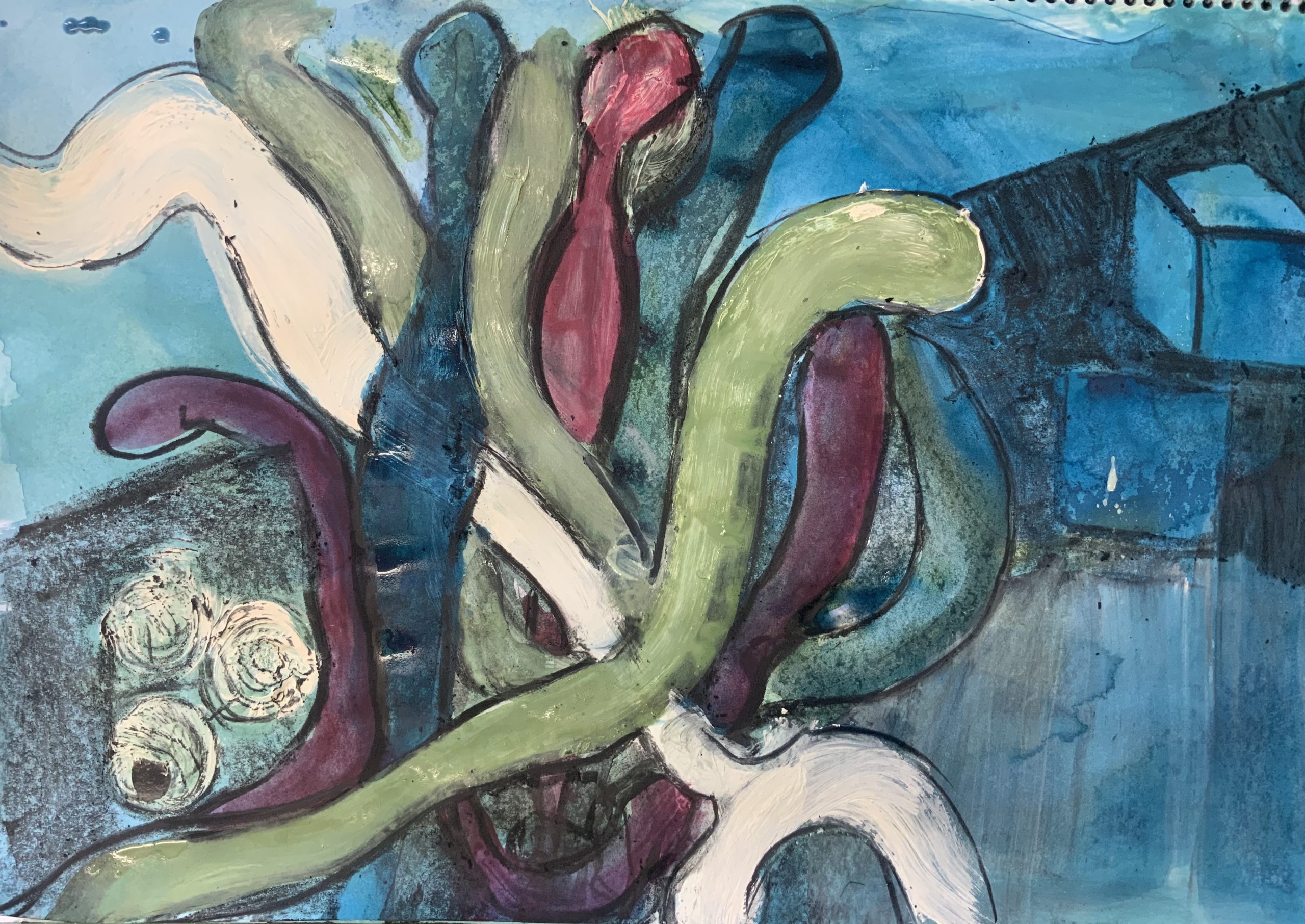
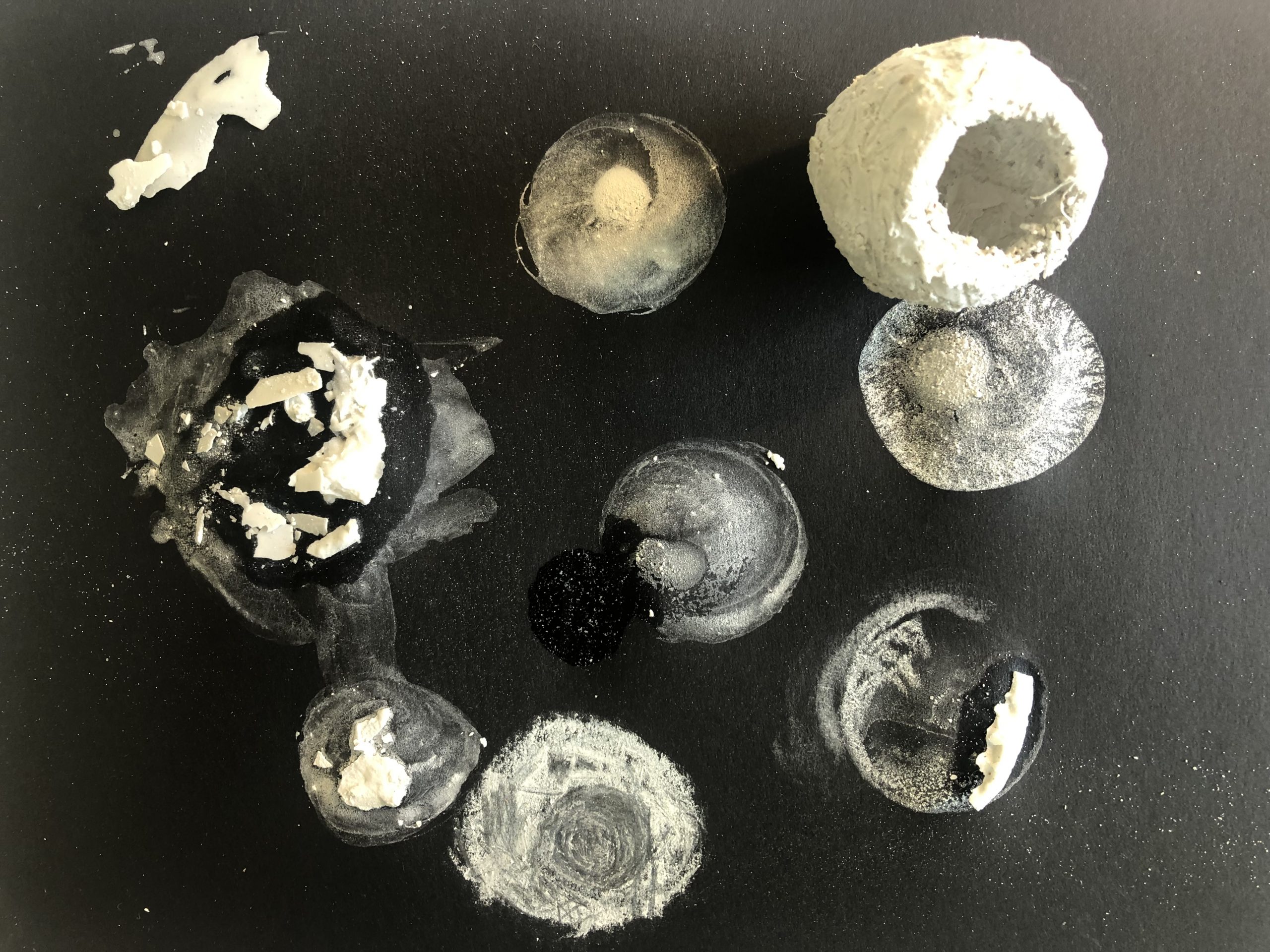
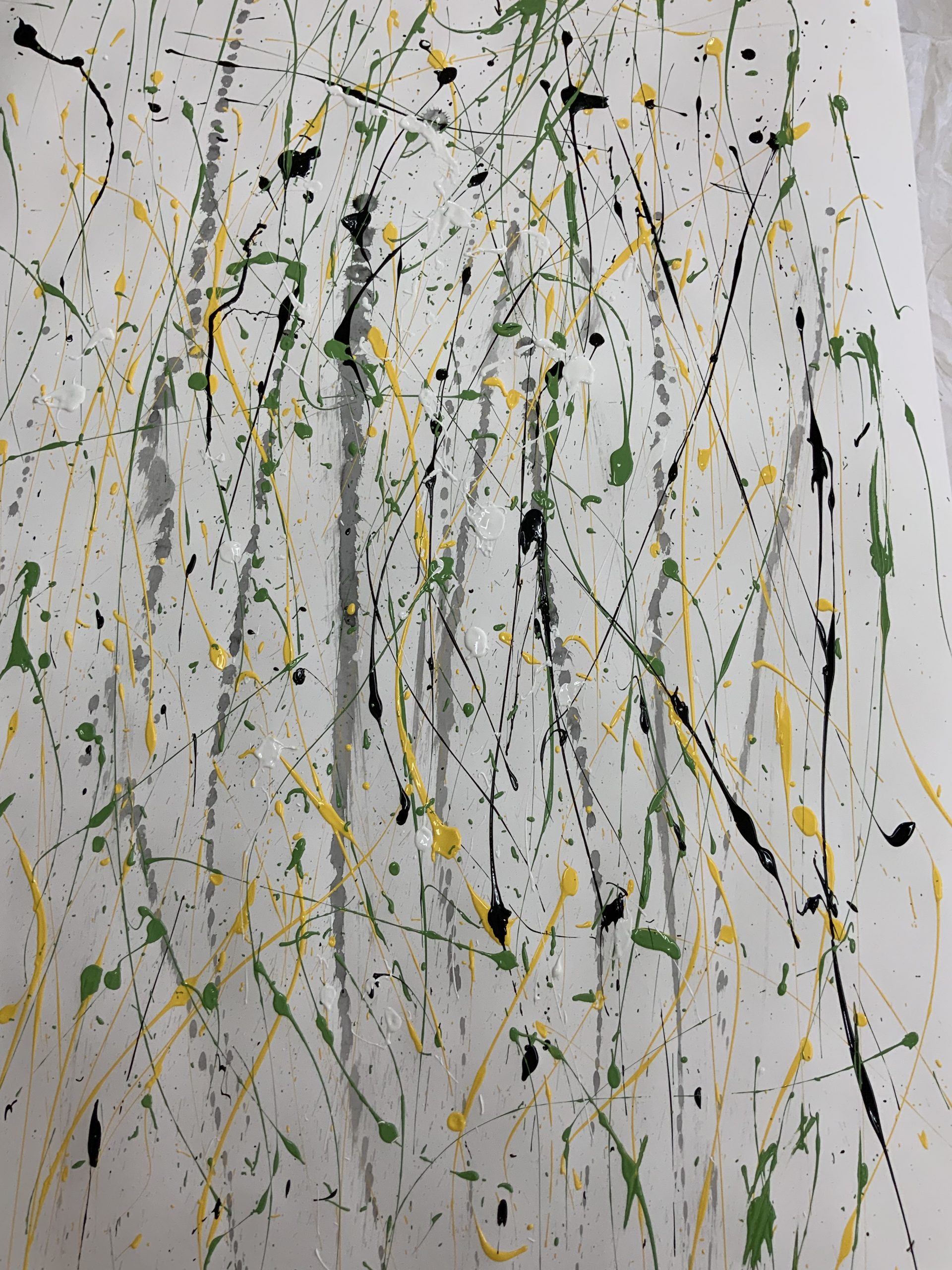
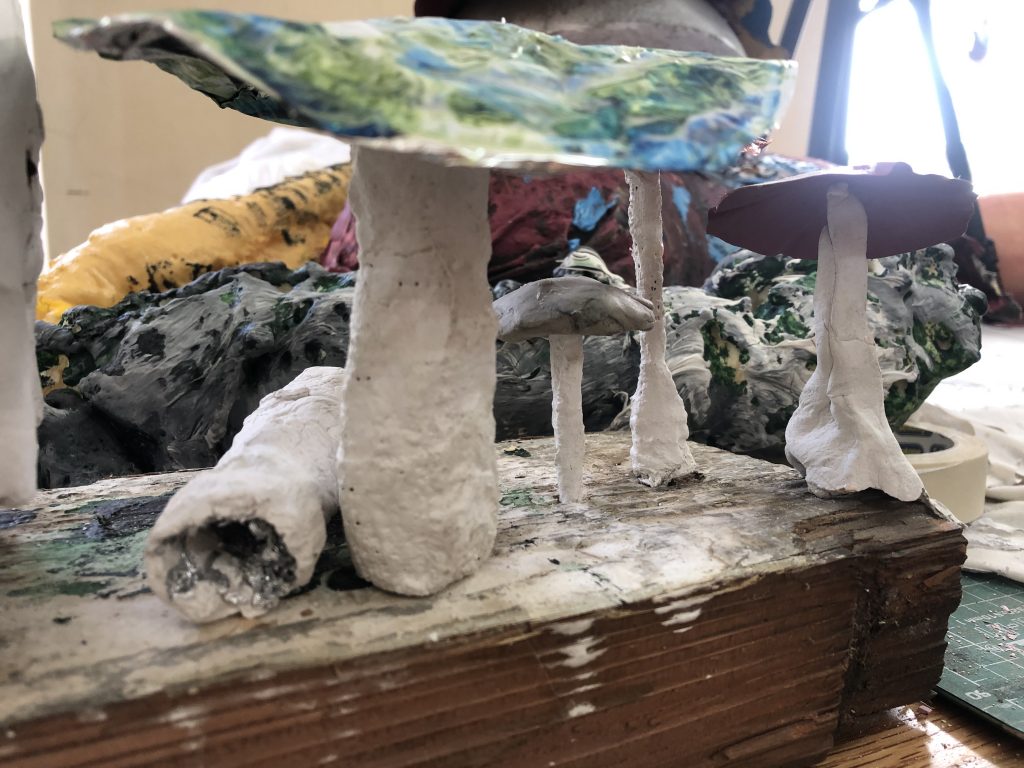
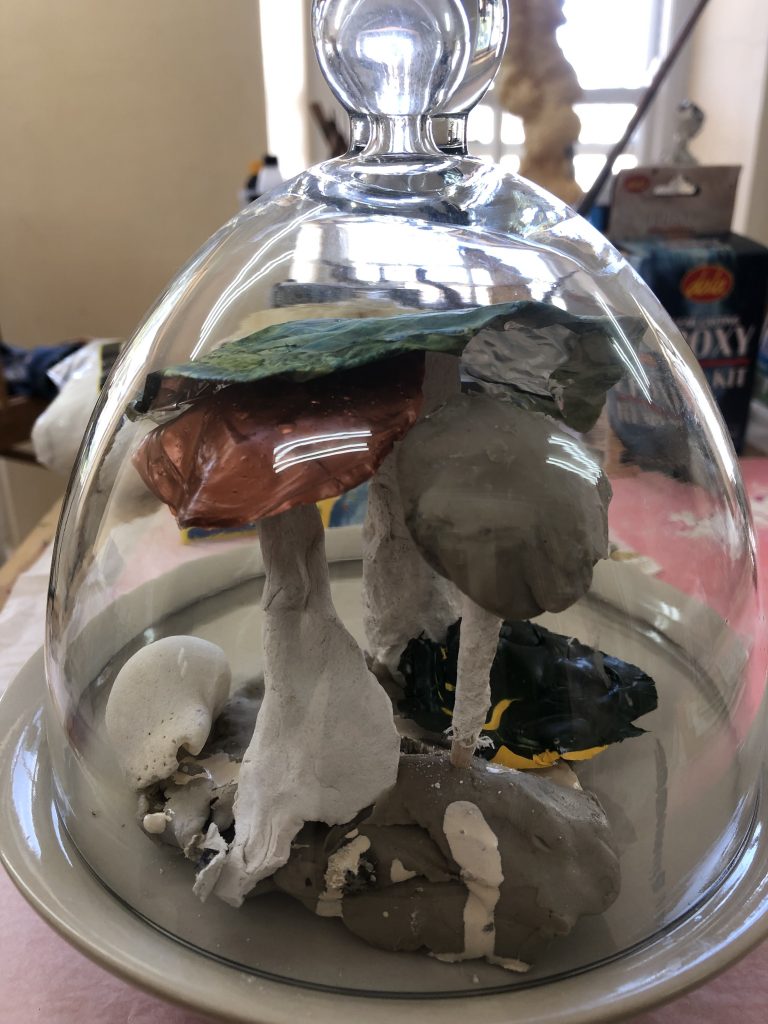
I came upon an image of the King Bolete (Boletus edulis), and I think the description can fit one of the mushroom assemblages I made with expansion foam. I can consider painting the surface and placing the object in a garden or wooded area.
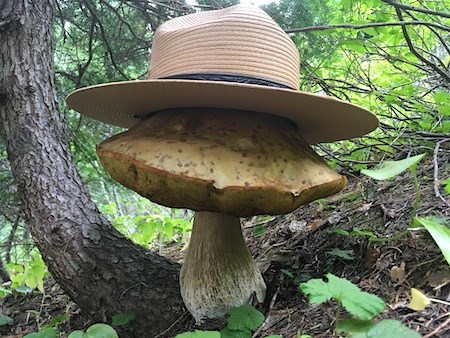
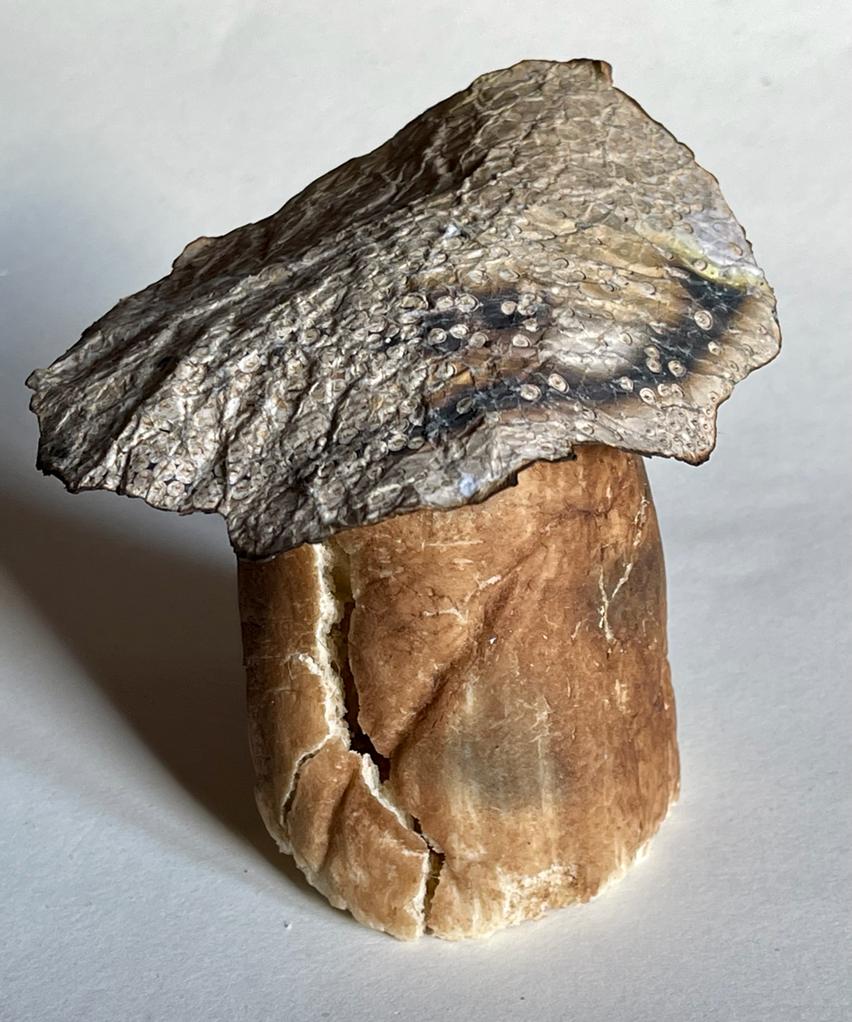
The description of the above Boletus in Fig. 35, reads as follows: “Medium to large-cap, various in colour, but generally some shade of brown. The underside of the cap reveals a spongy surface of tubes (no gills), which begin white but turn yellow and finally olive with age. The upper surface of the stalk has a fine white net-like pattern known as “reticulation.” The flesh does not change colour when cut or bruised.” (https://www.nps.gov/mora/learn/nature/mycorrhizal-fungi.htm)
It is harvested in Italy, Eastern Europe, China, Southern Africa, and North America and is part of the Porcini family of mushrooms. What makes them interesting is their symbiotic relationship with trees. How can I work with knowledge and observation of fungi as a metaphoric idea, is something that I have been considering. Does my making say something about my thinking about this symbiotic or interconnected relationship? I am mostly dependent on photographic images for making work or inspired by what Annette makes – 3d textile explorations. I am not sure if this means that the work is not always grounded in reality. We are now considering using the digital image as a final work.
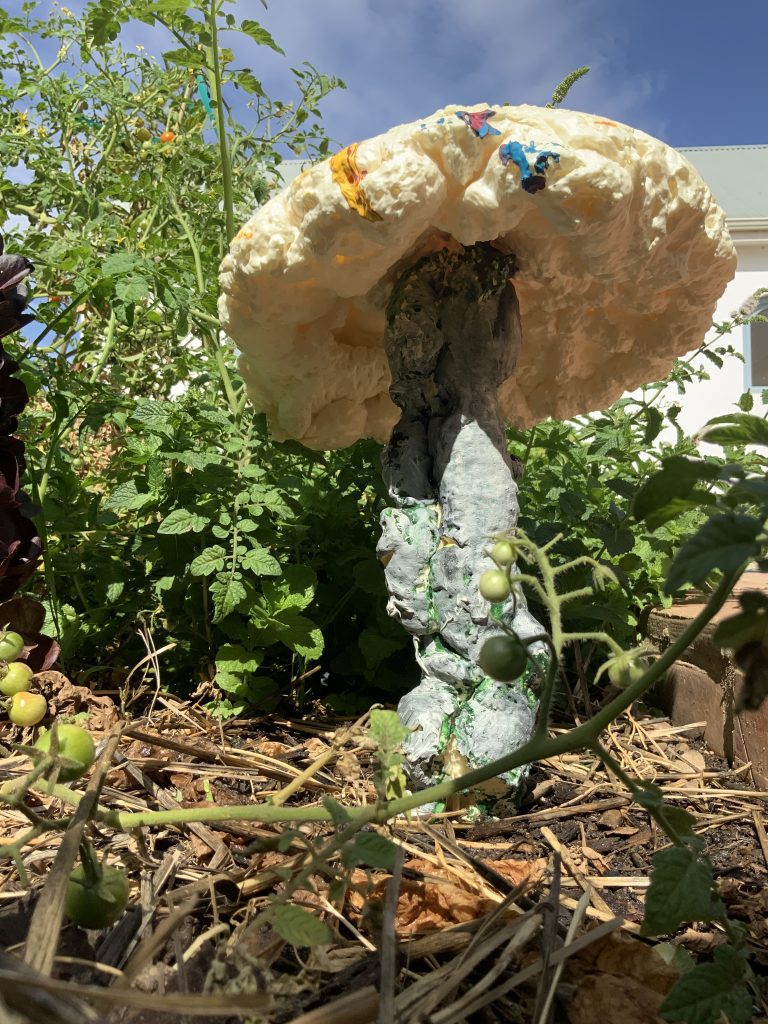
MUSHROOMS AS DRAWINGS
I explore drawing and painting with the final work of our collaboration in mind. In a group session with tutors Diana Ali and dr Michelle Whiting (OCA ) on Saturday 15/01/22, the tutors encouraged exploration around healing, thinking, and sanctuary. We looked at provocations as a stimulus when drawing, and one such exercise was a reading of Raymond Tallis, Summers of Discontent: The purpose of the arts today. ( I found it on SCRIBD and will add it to my reading list) At this stage (prior to the workshop), I have been looking at lots of visual images of mushrooms and other fungi and it felt that when I draw freely it was mostly rounded shapes or big curves which I try to connect, as well as a need to write down words about feelings around the heard words. I kept wondering WHY was I making this. I wonder if I am corresponding to what I hear or to my own expectations that I need to create and focus on. (later, when I started reading Summer of Discontent, Tallis refers to Rilke when he compares arriving like a child, who immediately gets absorbed into something at the place of arrival – “…so loses himself in that ‘nowhere without no”. ) I do feel the workshop made me aware of that in-between space between arriving and leaving, a deep need to see or experience without relying on memories, expectations, experiences, anticipation, words to describe or even be constantly reminded of mental images, good and bad – using drawing as this place/expressive/open/free/no judgment/safe/connected. I wonder how most of the time we just numb feelings.
Earlier in the day I started a charcoal drawing and decided to work on this. By now I had my composition of fungi and wanted to show the mycelium network underground. The idea of an X-ray to reveal what is underground came to be my choice to work further on this drawing.
I made a drawing in mixed media of a series of mushrooms, all imagined, onto canvas paper – initially, I thought, when I prepared the paper with a light wash of gesso and Quinacridone Burnt Orange, it would be a Cy Twombly exploration, but also want to consider a work that could sit with Annette’s 3d mushrooms.
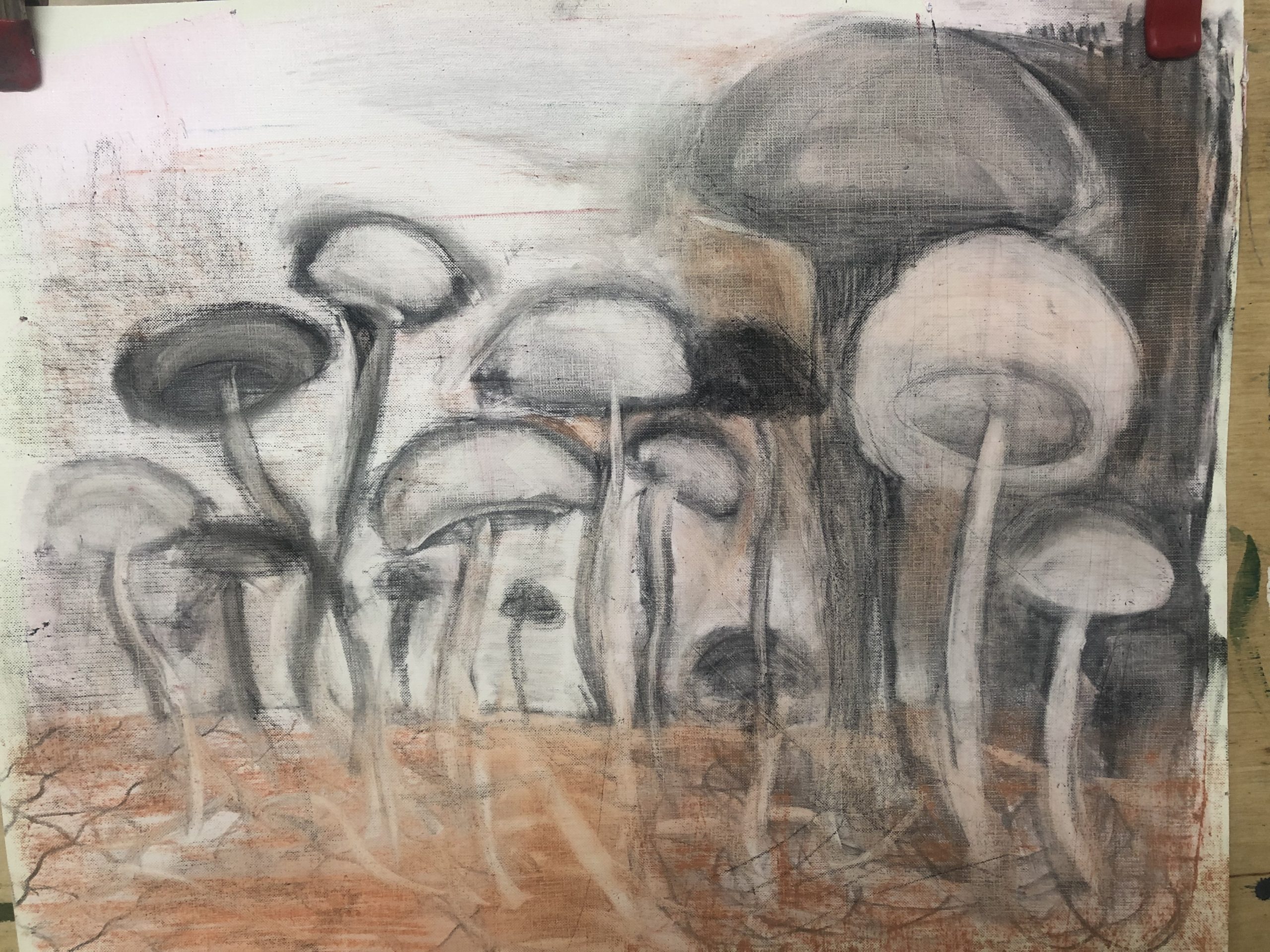

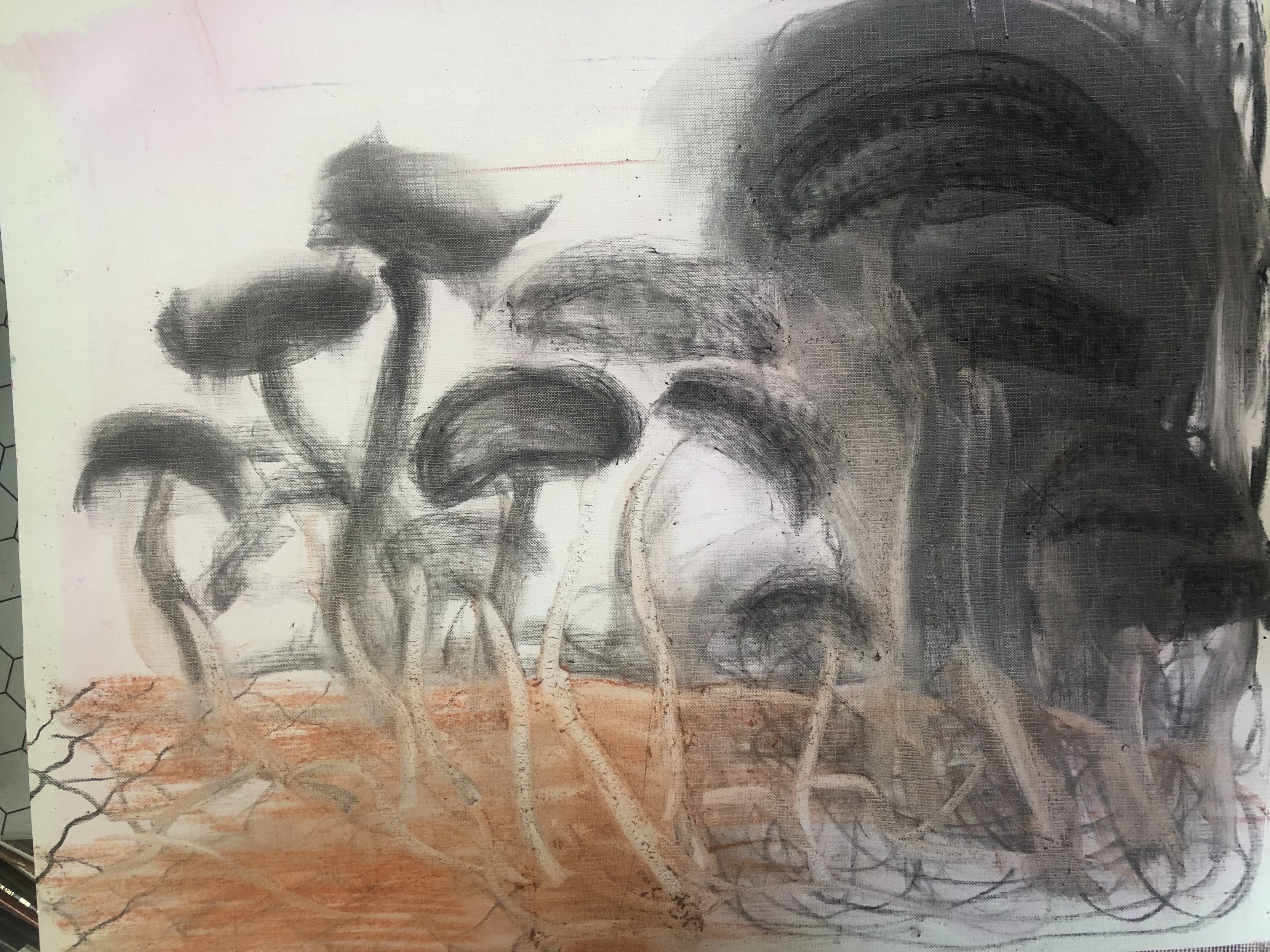
This work led to further exploration when I attended another OCA-led workshop with tutor Helen Rousseau. On Tuesday 18 January I joined an OCA tutor/artist lead workshop which is ‘Drawing Conversations 2’ – a practical workshop. Prior to the workshop, we were asked to look at at least two videos from artists who use drawing in their practice and see if we find any links with our own practice. These videos are available on the drawingroom.org.uk website. I looked at Robert Longo and Jittish Kalat. I have learned about Kalat in Understanding Visual Culture 2 and enjoy how he uses the sense of chance and process in his work. Robert Longo works with charcoal, comes from a sculpture background, and uses scale to take the drawing to a really lovely place. In his large mostly charcoal drawings he examines the mass consumption of media images through hyperreal drawings of monumental scale. For his Manet study (image below), he used an X-ray of the original work as inspiration and that really caught my eye in his composition of Manet’s, A Bar at the Folies- Bergere, 1881-82.
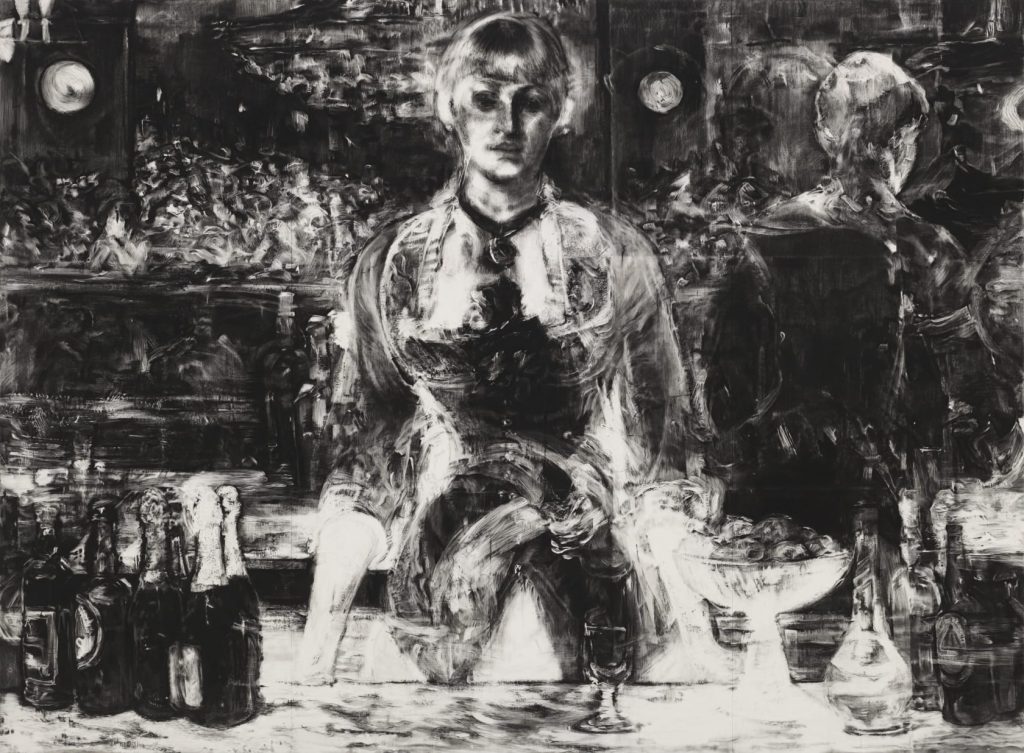
I was fascinated by how he worked from light to dark in this drawing. This drawing is bigger than the work of Manet. The size of the work is 261.8 x 348.8 x 10.2 cm, compared to the size of Manet’s work, which is 96cm x 130cm, and it is done on paper. This work reminded me of working with Reflective surfaces in Part 3 of the course. Listening to Longo talking about Manet, I felt the need to add some notes in terms of my learning. Thinking about making as an invention versus realism. Manet did not make this painting whilst sitting somewhere in this bar, he was at home, already nearing the end of his life and most probably reflecting on many things, but in this work, it is the gaze of the barmaid that captures. (in Part 3 I remember reading on the Courtauld Gallery Website that the sitter/barmaid went to Manet’s home to pose for him) Longo sees her trapped between the frame, the bar, and the mirror. I have contemplated her melancholic look, as being detached from her environment, and now agree with Longo with regards to the placement of her hands – here one reads confrontation and/or assertiveness. Longo shared that these barmaids were expected to provide sexual services to their clients if so demanded. He referred to the Bass (the UK branded) beer bottles, with red labels as an +addition in the bar, to serve the visiting British clients. Interesting that Manet put his signature onto such a bottle, in the red bottle on the left. It makes me look at her role as a worker, differently. I wonder if she felt she had a choice – is Manet also referring to the Male Gaze, Berger referred to? By now, comparing these two works and thinking about the time the artists spend around the work made me reflect on the time one spends working and what thoughts go with this – is this an ‘awareness’ that happened because one looks at this work? It also seems that tiny brush marks are being ‘blown up’ in the drawing. Longo shares the opinion of Walter Benjamin who talked about a loss of aura, and how he saw two pairs of eyes and felt her gaze set the ‘aura’ of the image- to him the X-ray is like ‘seeing’ the aura or the invisible. Reality is clearly not as things appear in this work, did I miss/ignore it during earlier visits?
In the video conversation, Longo talks about us living in an image storm and that this work seems like it could slow people down. I do like the idea of looking at this work and also seeing the image as almost trapped between the frame of the work, the bar counter, and the mirror. I considered how I used photographs in many of my bigger rhino drawings as well as a drawing I started this morning around fungi – mostly inspired by Annette’s compositions of her handmade mushrooms. In my mind, I could use my drawing as a backdrop or combine it with other work in a video installation.
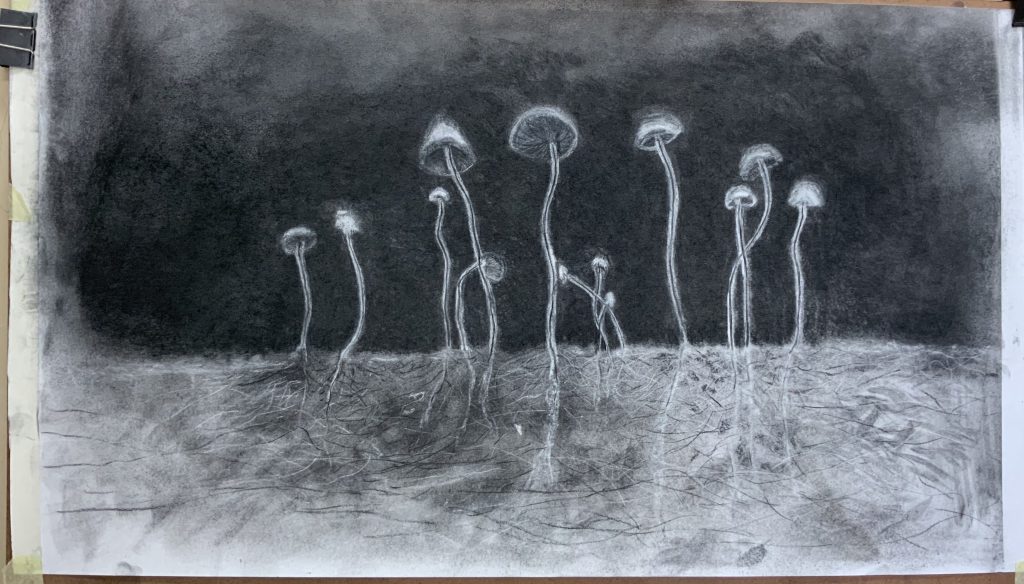
Helen suggested we go back to one video and use the idea of verbs, like in Richard Serra’s work (we covered in part 2, under Object table development), and make a list of verbs that stands out. With this list, we then went back to the current work to find how this research resonates with my practice in developing the work by using these actions that speaks to me. I was struck by: to transform, to reveal (thinking X-ray) to change, to entice, to erase, to toy with (gaze) to amplify, to look up close...Considering the materiality of charcoal, I realize that the fragility of my material is part of why I like drawing these small tender fungi with it – there seems to be a real connection between the material and the subject. Once whilst drawing I poured some charcoal dust over the work, it covered the drawings, but also made me aware of mushrooms that turn into dust when their flowering is over. There was a few moments of panic about whether I would be able to bring the little mushrooms to ‘life’ again – but this showed the material at work and tells a story about the layers inside the work. Later when I sprayed a fixative over the drawing these same ideas came to mind.

In the drawings below the first two images is of a small study (A5) done on black paper with white chalk and charcoal. I was inspired by images of illuminating mushrooms I have seen. I then started to draw on a big sheet of wallpaper with the idea of erasing the shapes/forms. Looking at an X-ray of fungi (fig. ) and thinking: to amplify, to reveal, to look up close, as my verbs from Longo, I continued the drawing by working on how I could illuminate these forms, to almost become monumental or eerie as I would think could happen. (had I been an ant looking up, or eating magic mushrooms???)
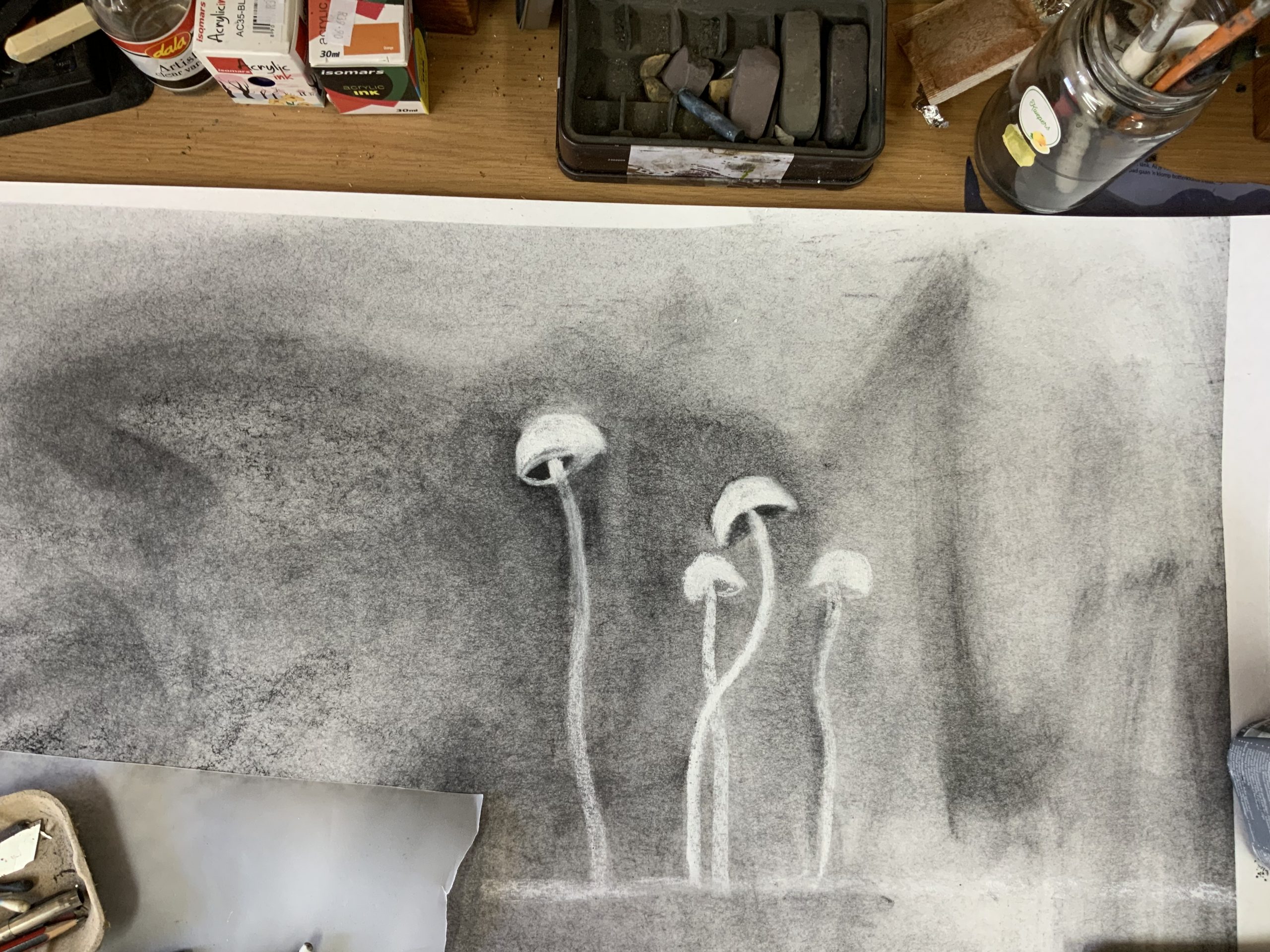
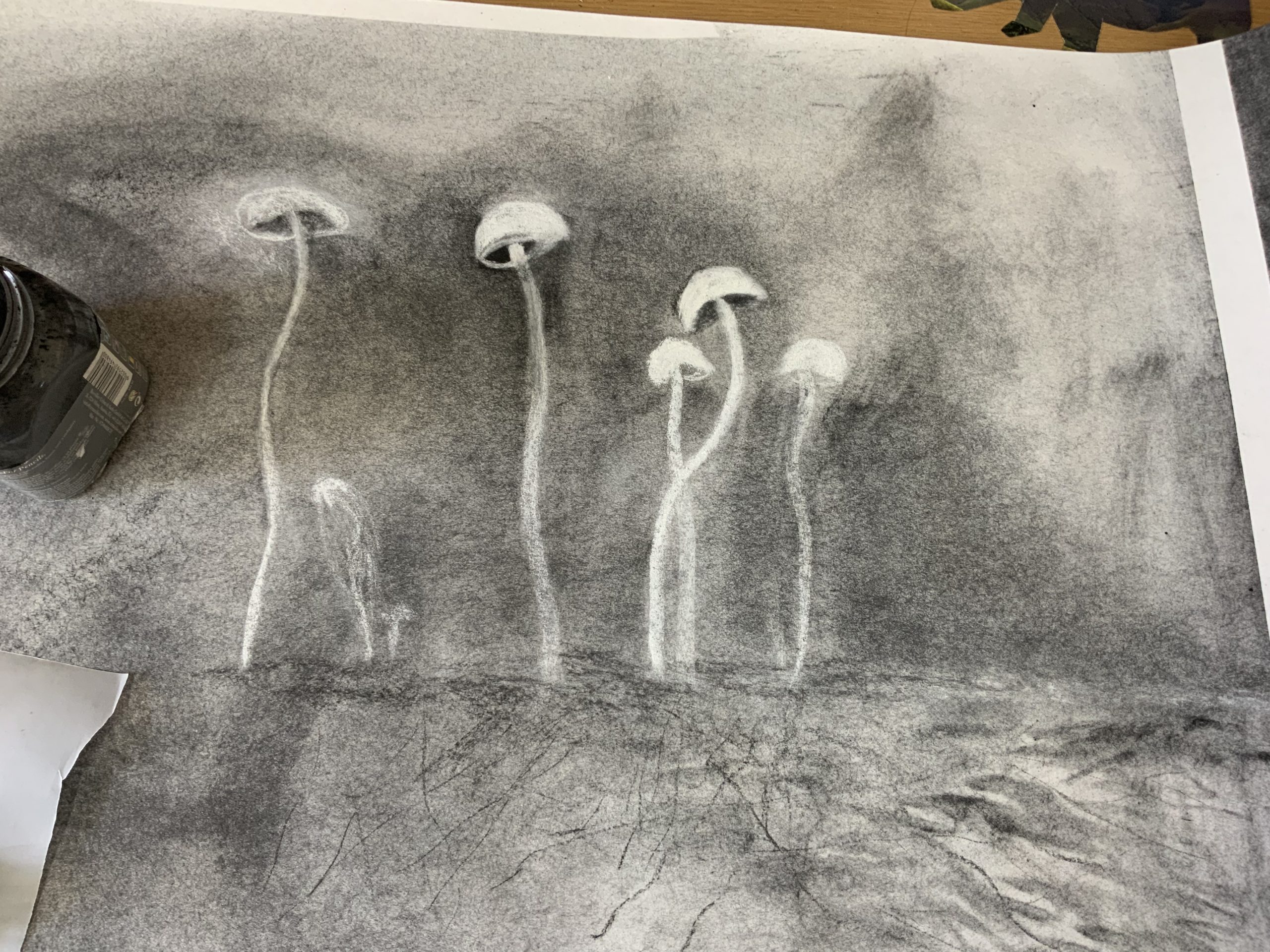
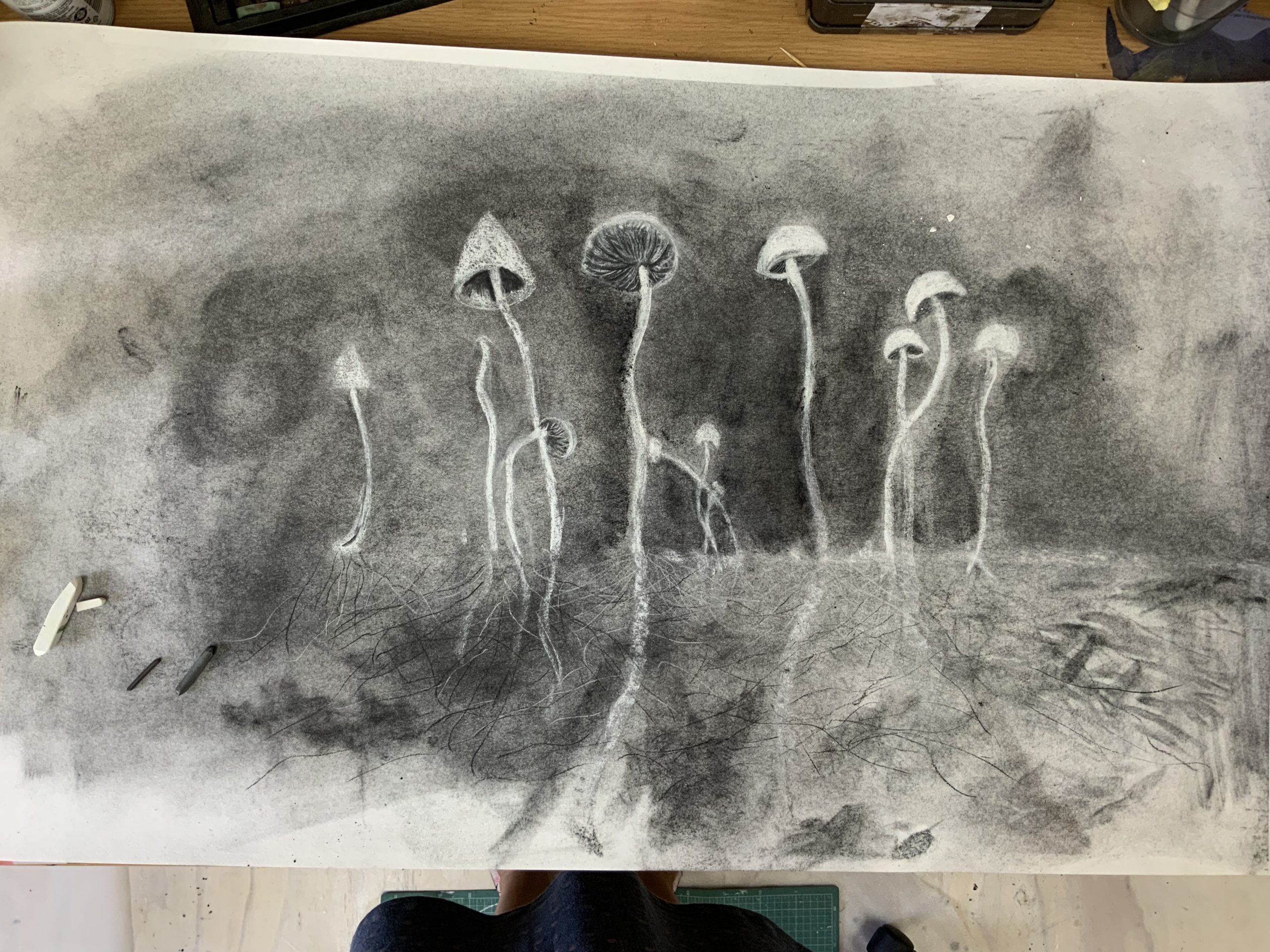
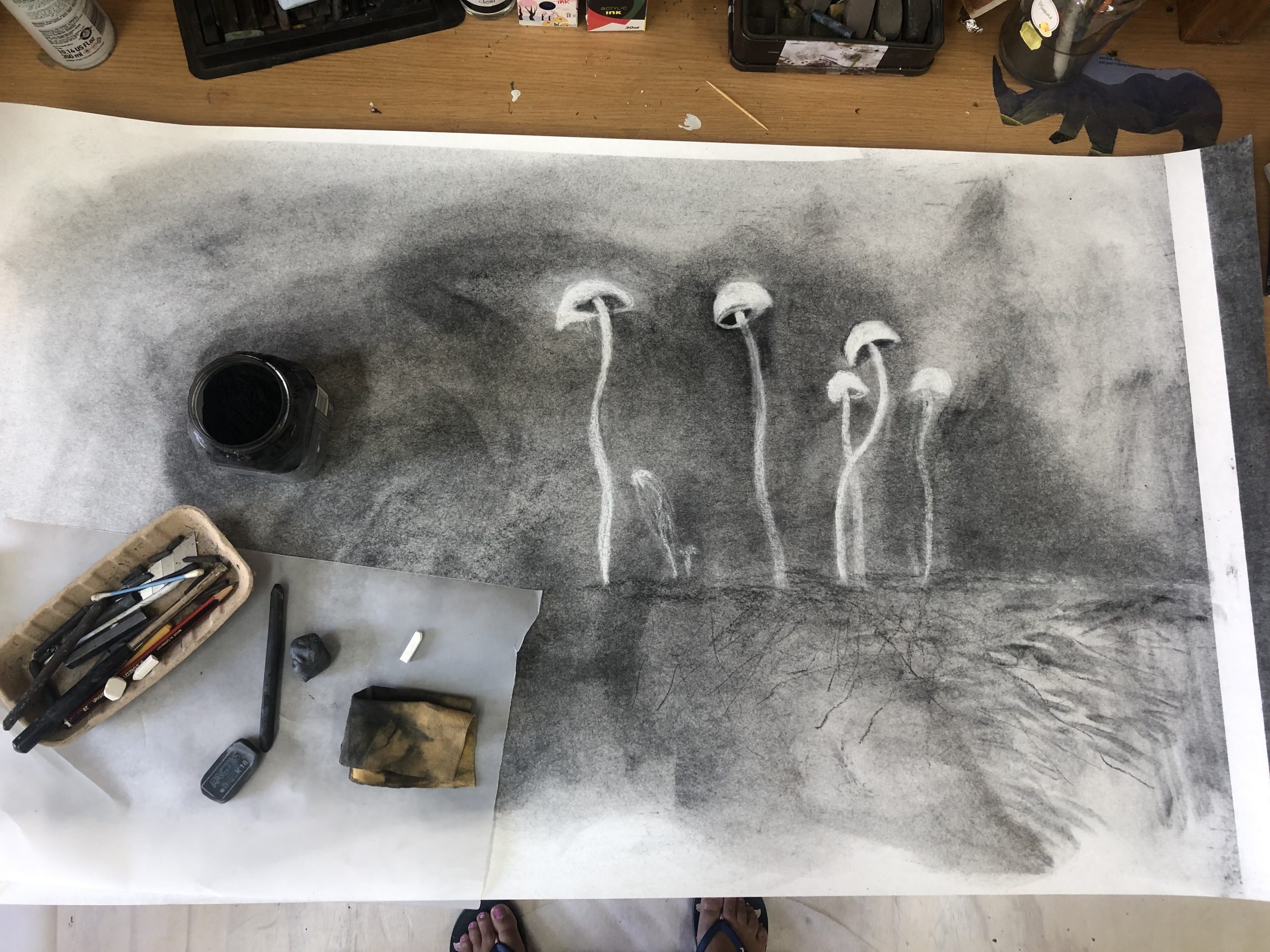


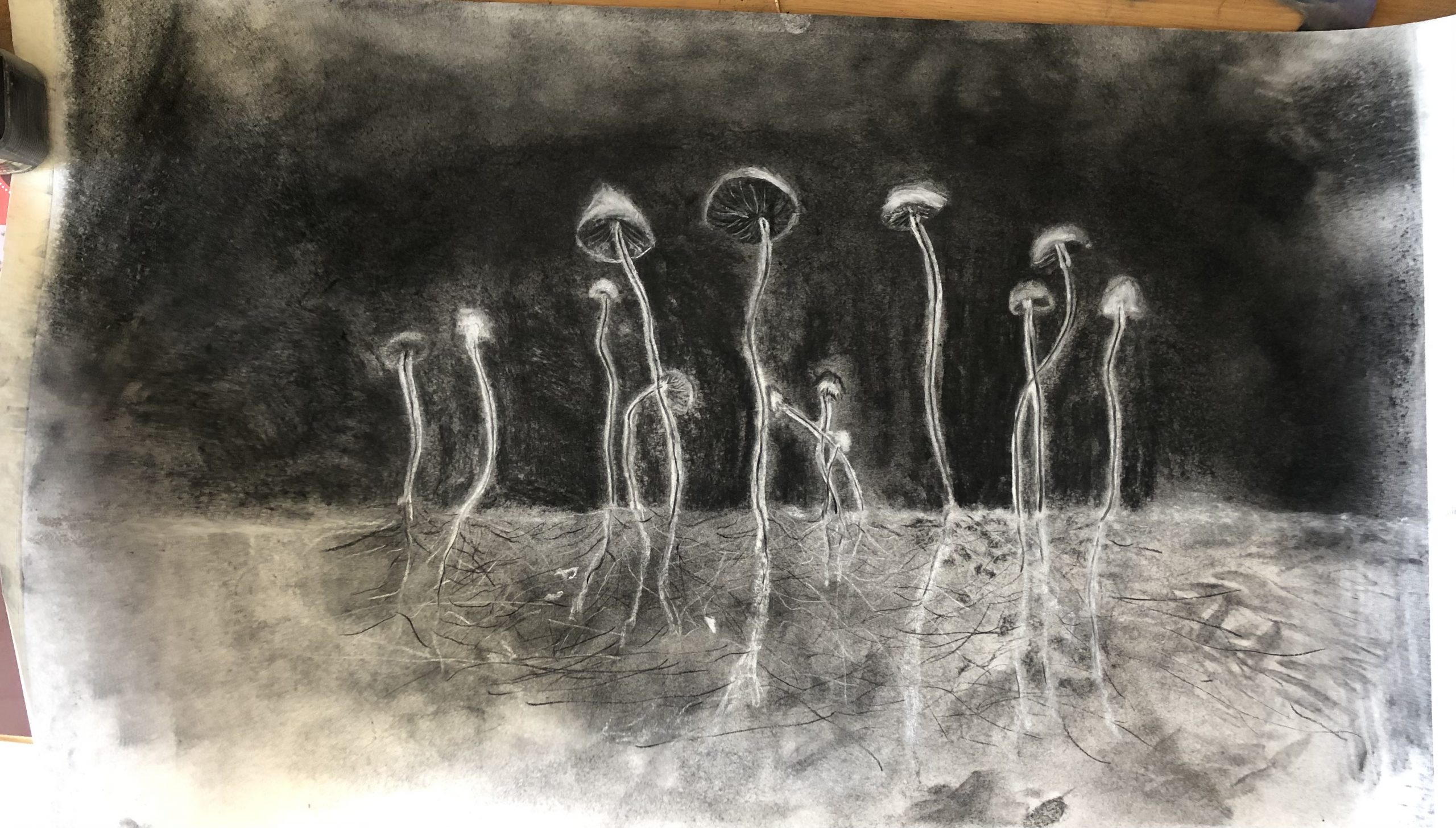
In the smaller group session after this making/working process, I was inspired to consider working on more layers in the background ( use fixative) and making the material almost consume the paper. I could also consider wetting it with water.
I continued adding darker tones and layering them in between with a fixative onto the paper. Another idea I can consider is to paint with charcoal powder – using a brush to apply the powder onto the paper surface. I saw an artist on Instagram who works with charcoal powder and compressed air, interesting is that he makes his own charcoal powder. (Frank Lombardo) In his making process, I saw that he keeps his paper support upright – a great idea that gravity helps with the dispersion of charcoal. I will implement these ideas in my next drawing.
A student in the group, who worked with colour, inspired me to consider these as studies and use colour. Interesting is that in the course work I was now working with colour wheels.
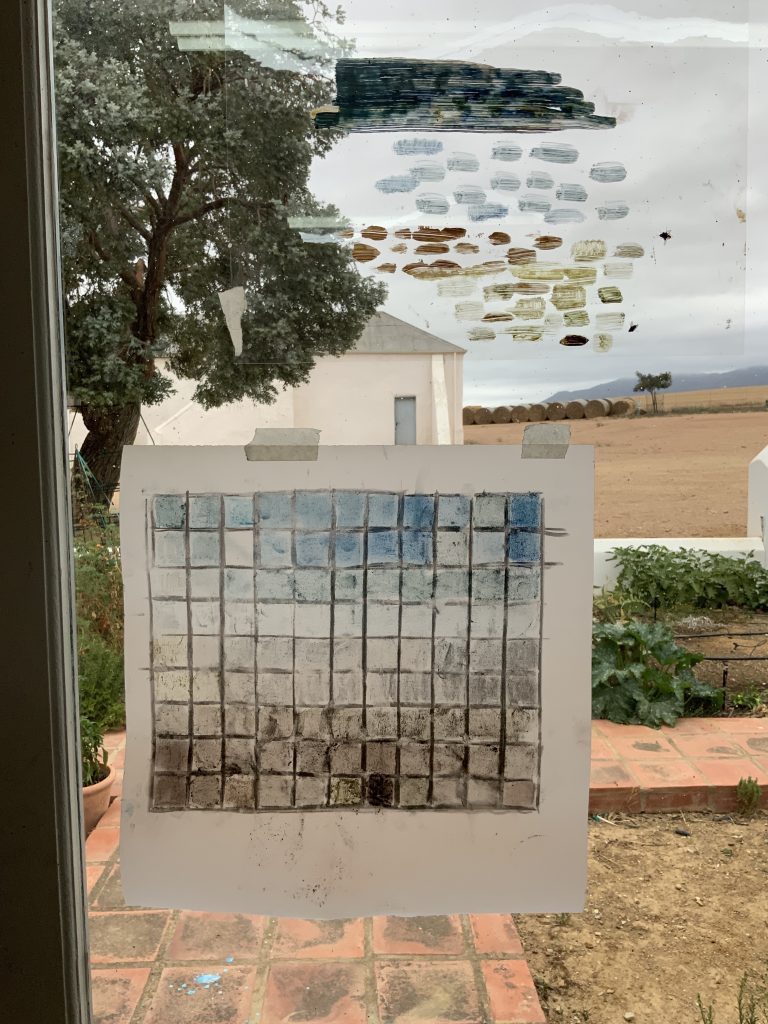
It was as if tonality spoke more to my making and exploration. are images I took with my cellular phone to explore colour and tonal options. I was inspired by the work of other students to consider the use of guache or soft pastels as well as water.
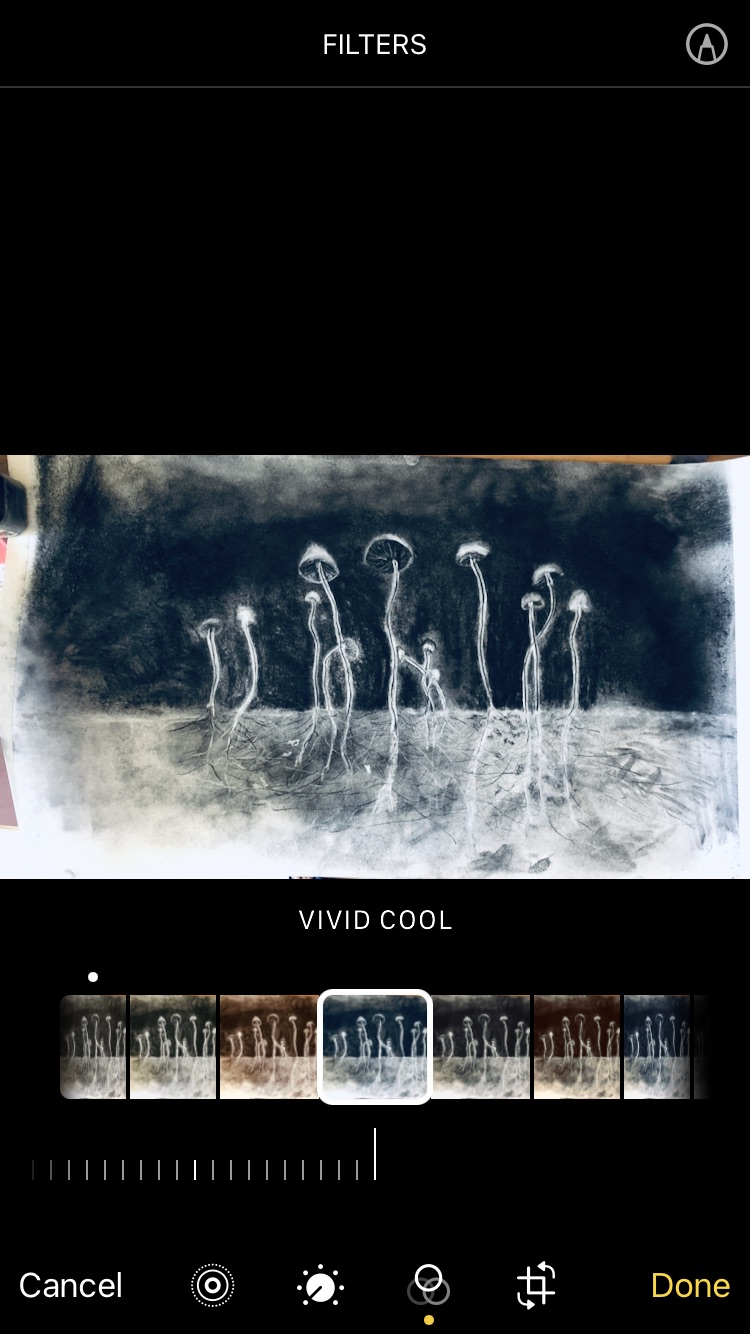
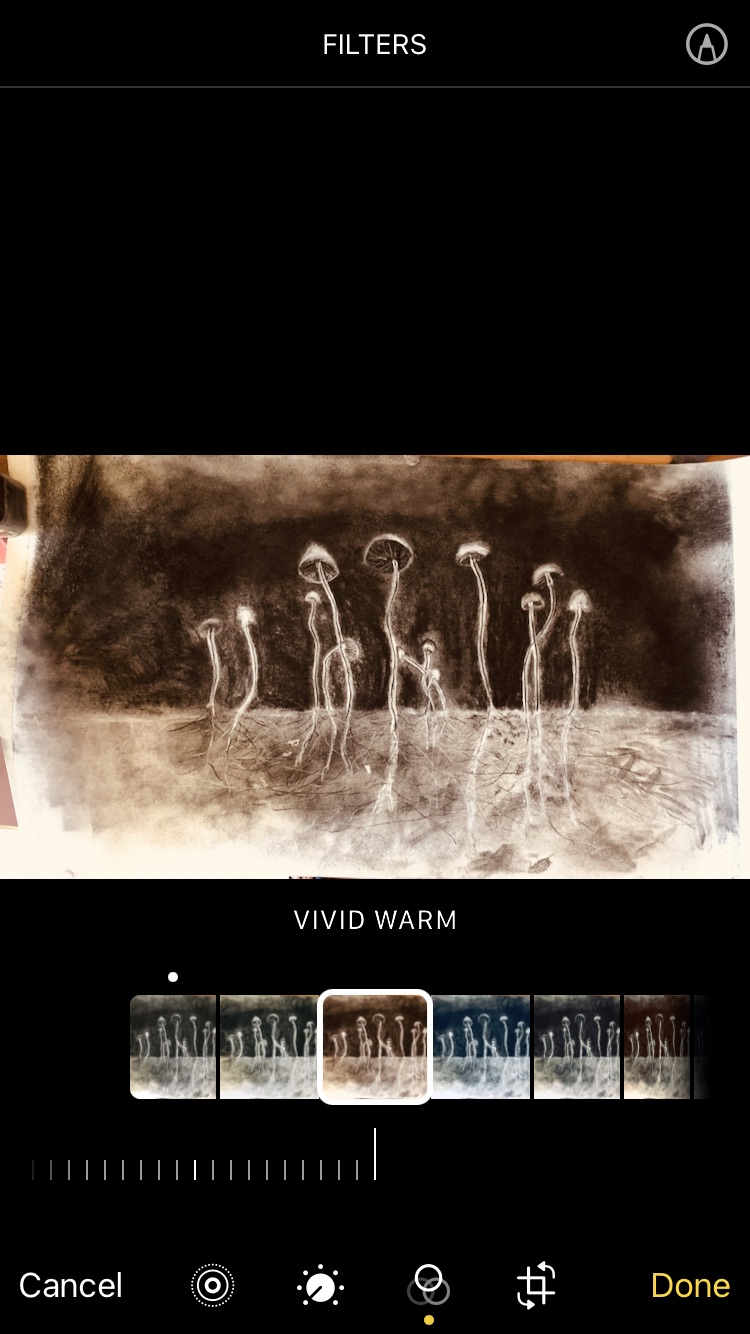
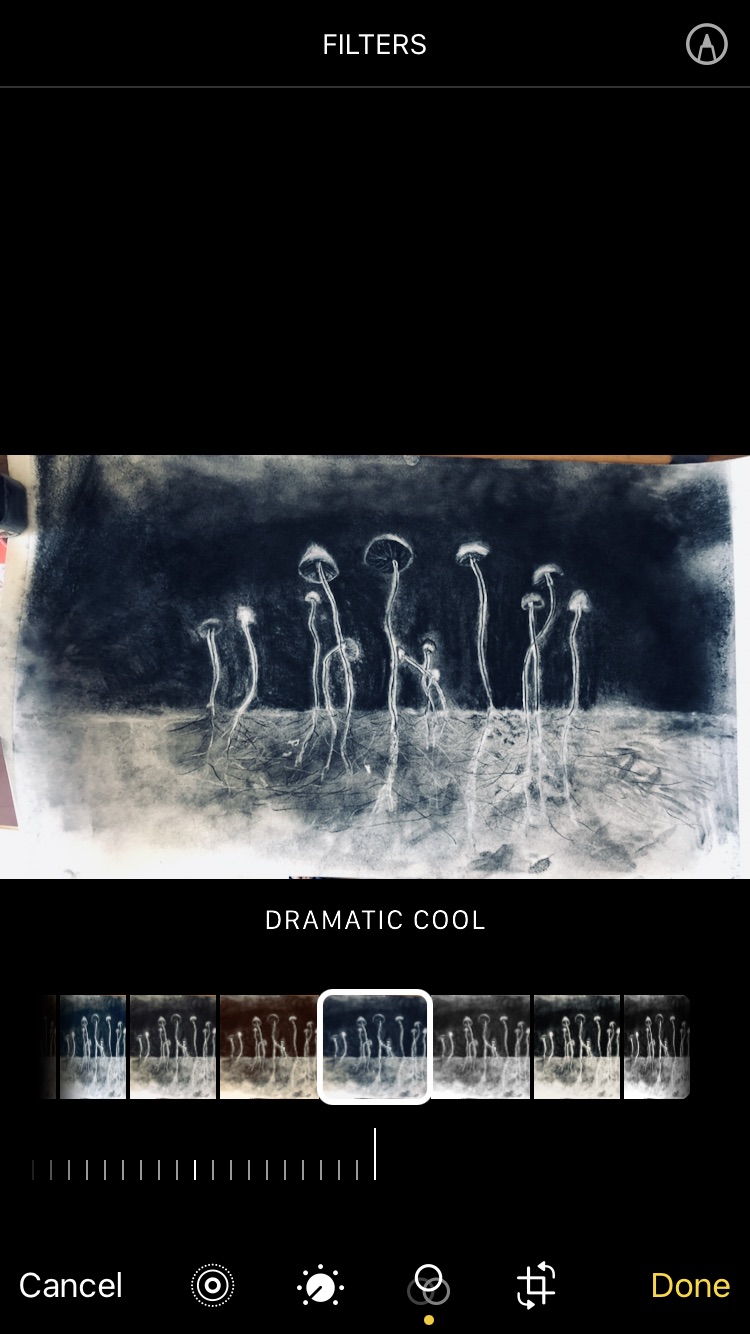
It became clear when looking at my making that I was moving closer to the collaboration work between me and Annette. I was getting to a space where I could make work that could sit with her work.
I took part in an OCA tutor-led session, called a Silent Crit, and share the above work in Fig. Tutor Cheryl Huntbach used a reference from a book of essays by Ursula K Le Guin, called Dancing at the Edge of the World, and in particular, the essay called, The Carrier Bag, to open the discussion. All the participants had ten minutes per work shown, to write ideas, suggestions, and feelings about the work in the chat. This was done after the maker introduced the work in terms of size, medium if it is a finished work and the title. The space was safe and non-personal – the work was seen, looked at, and understood differently, but with consideration, openness to difference, relevance, respect and positivity.
I could take so much of this generosity back to my work and develop my ideas and feel in a way validated around my making and learning. I clearly came along to the Silent Crit with my own ‘carrier bag’ and was made aware of being sensitive to other’s’ stuff ‘in their bags and the opportunity to share something from my bag as well as take from others’ bags. Like mycelium, there does not always need to be a leader, during the session we were all participants and observers. I think in this way I was absorbing the thoughts of others..like synergising ideas which were created from within the group. Nothing was really joined up…different ways will be taken by each of us. If we consider using the Padlet further I am sure one will get an idea of just how these ideas ‘fermented’ into new works or learning. I could relate the process to my work and ideas around fungi and mycelium – I am intrigued by stories about mushroom hunts, foraging for mushrooms, and using mushrooms as medicine/food as well as a tool to learn about our ways of living. Is this also a way into telling and creating stories (making work) about the untold ones – the life story and not the old story institutions/politicians/hero’s/Hollywood/ culture/beliefs/things tell us.
I think of myself as a container – and new questions arose: what am I holding, carrying with me, telling and collecting? Is Le Guin also telling a story about feminism compared to dominant narratives of aggression and technological superiority? What influenced my making from here?
Below is the commentary on the work.

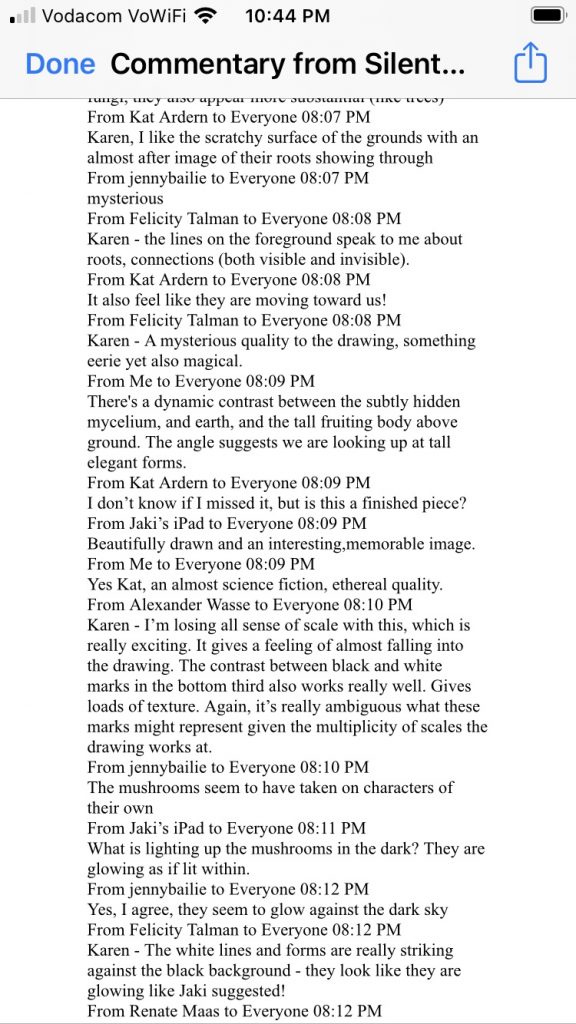

I read the complete essay after the session. Here the author beautifully writes about the analogy of using containers for our life stories, ‘claiming’ that a container could have been the first thing hominids evolving into human beings needed – to hold stories, things, and food. She suggested the first cultural device, “…was probably a recipient…” I can imagine it having a sling to lug things in that you will need at home and for tomorrow. Le Guin then writes about what she. sees as to feel a human being….”if it is a human thing to do to put something you want, because it’s useful, edible or beautiful, into a bag…” (p 32) This story took me to African culture and stories around bags to carry. I was reminded of an art exhibition I viewed at Zeiss MOOCA, Cape Town, in 2019. The young South African artist, Nobukho Nqaba, born in 1992, was using the bag as a stand-in for culture, heritage and memories. This revisit of the images took me the memory I took away, namely that of migration, survival and the notion of the home if you live in a shack, your existence, dreams, and ambition of having things. This bag goes by many names here in Southern Africa as well as Western Africa – In Ghana it is a ‘must go home bag’, here on the farm the Zimbabwean staff told me they call it a Shangaan bag, I have heard China bag, and have my own version of it – not in the traditional striped pattern, but with a Rhino. I am familiar with the Xhosa words for the bag as being ‘unomgcana’ or ‘umaskhenkethe’. I am again thinking of metaphors of the Fungal Kingdom as this being a carrier bag of stories about foraging, and connecting with nature. It also takes me to my reading of Tsing and how culture is embedded in mushroom foraging.
Sheldrake describes a song of the Baka or Babenzele Pygmies in the Central African Republic as follows: ” As they wander around collecting mushrooms, their steps tracing the underground form of the mycelial network, the women sing amid the sounds of the animals in the forest. Each woman sings a different melody; each voice tells a different musical story. Many melodies intertwine without ceasing to be many. Voices flow around other voices, twisting into and beside on another…Polyphony is singing more than one part, or telling more than one story, at the same time. Unlike the harmonies of a barbershop quartet, the voices of the women never weld into a unified front. No voice surrenders its individual identity. Nor does anyone’s voice steal the show. There is no frontwoman, no soloist, no leader. If the recording was played to ten people and they were asked to sing the tune back, each would sing something different. Mycelium (web of fungi) is polyphony in bodily form. Each of the women’s voices is a hyphal tip (branching fungal roots), exploring the soundscape for itself. Although each is free to wander, their wanderings can’t be seen as separated from the others. There is no main voice. There is no lead tune. There is no central planning. Nonetheless, a form emerges.”
Collaborative work as part of the EU student group online exhibition
Exploration with shoe wax and shampoo led to more mushroom paintings and finding that the network of mycelium was becoming more important in my making. Discussions with Annette convinced me of the influence of opportunities which came through sharing our making and thinking and experience of exposing oneself to others in the process, without focussing on expectation. Together we discover how good it is to look at the horizontal exchange between our materials, as we are seeing it in nature. By the end of January, I started making exploratory drawings which would eventually become our collaborative work for our WWW exhibition. The final work size of the paper is 85 x 130 cm and I worked flat on our dining room table. I used a photo image from a Facebook group I belong to, see the image below. I changed it in the next image to a tonal image, which became my choice for my own work which developed from this.
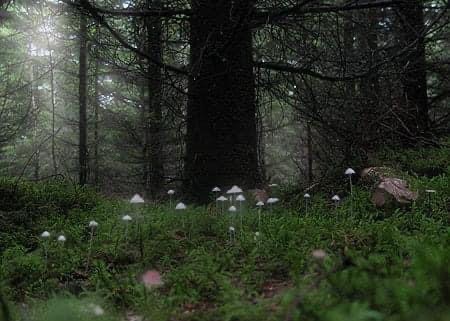
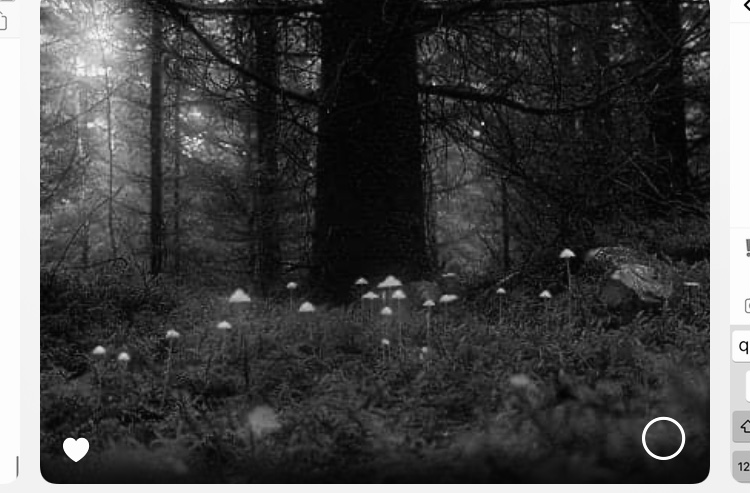
Explorative drawings were done with charcoal and pastels, I scratched them into wax, and worked on white drawing paper as well as velour paper. I would call all these works below, thumbnail sketches which lead to the making of the final work.
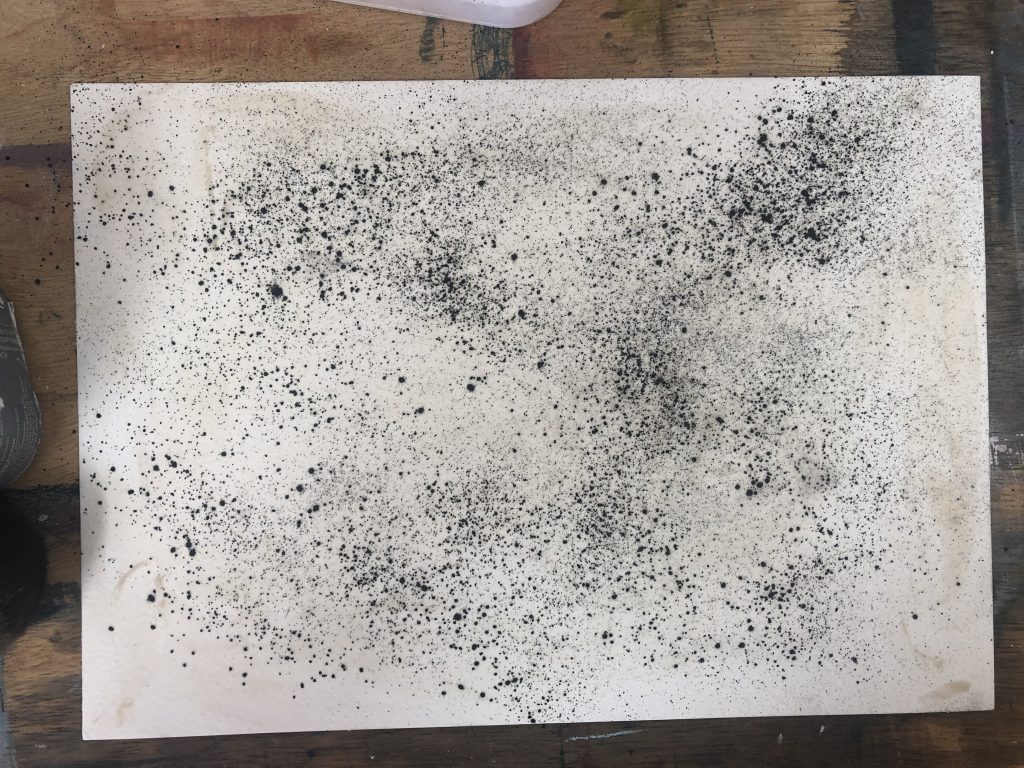
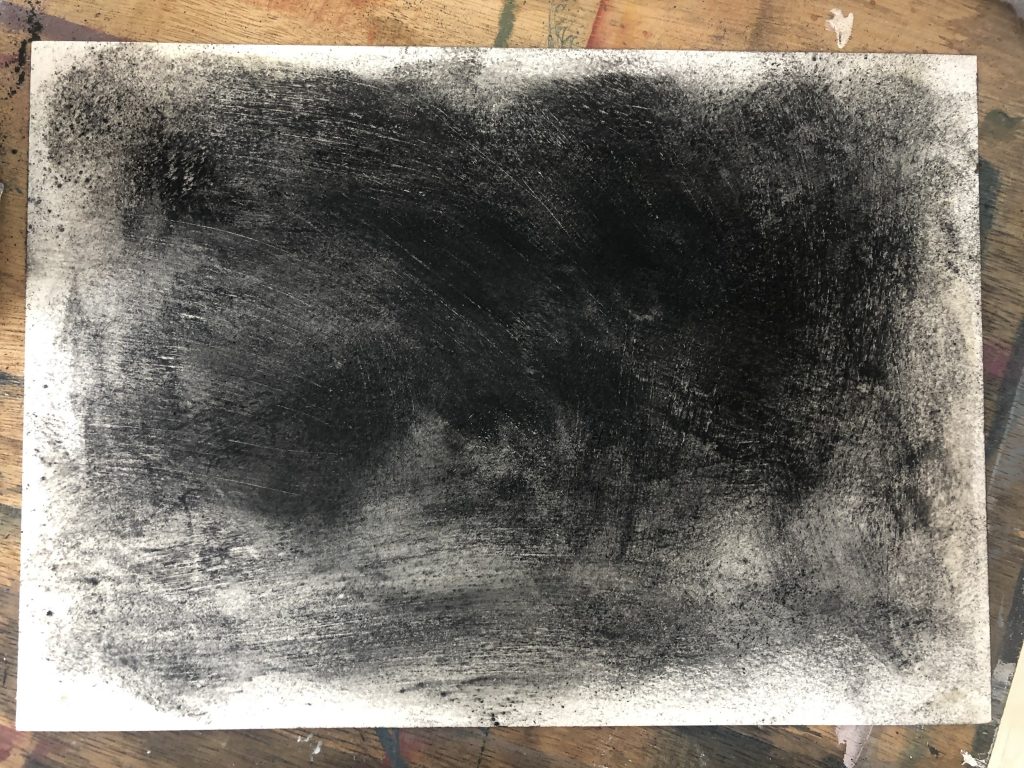
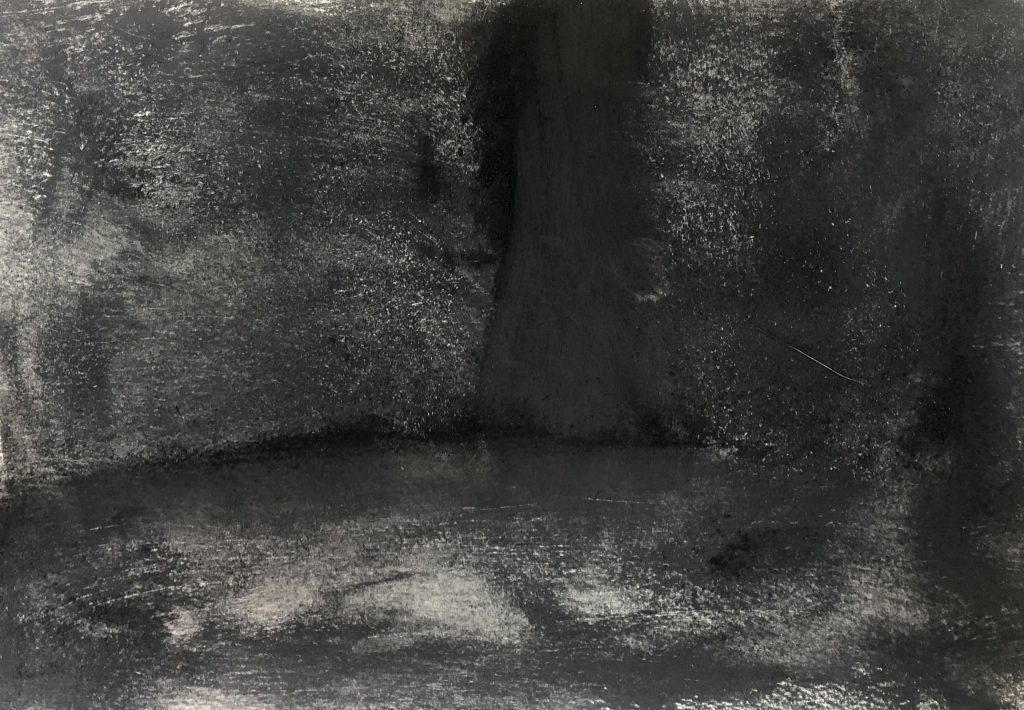
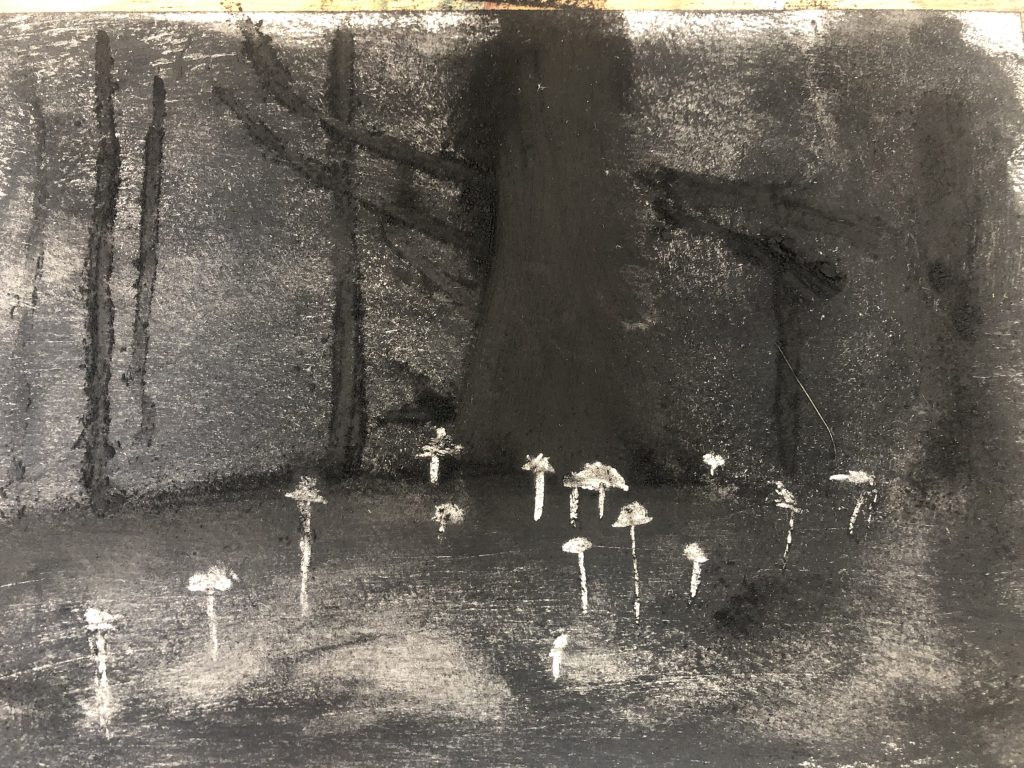
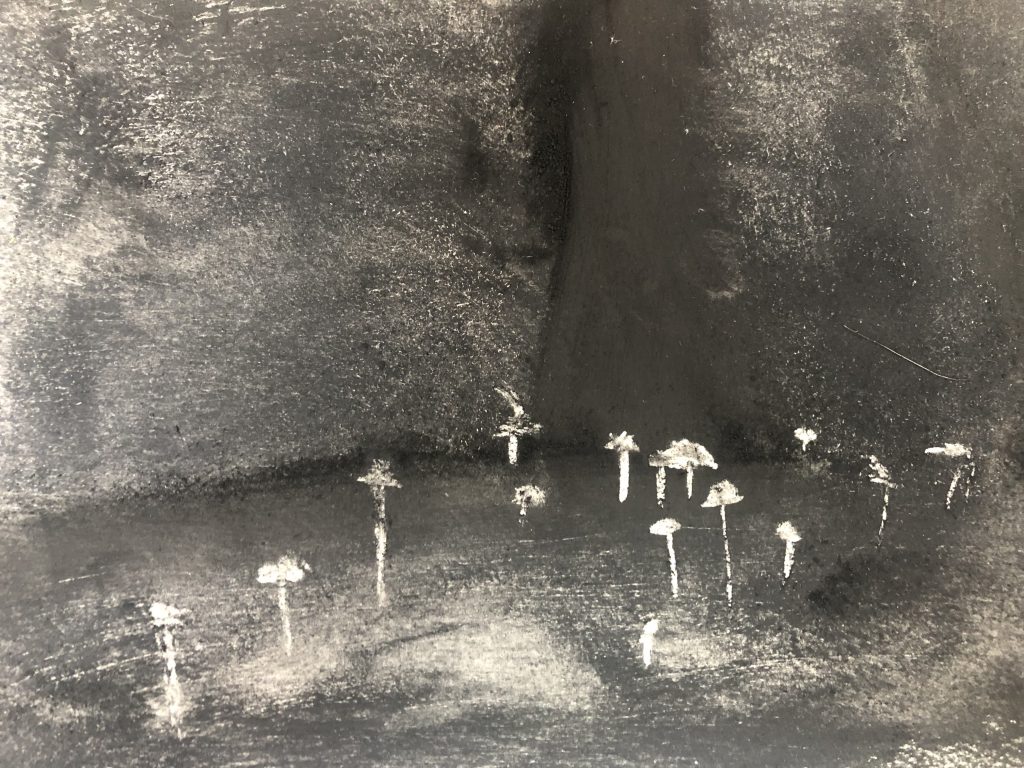
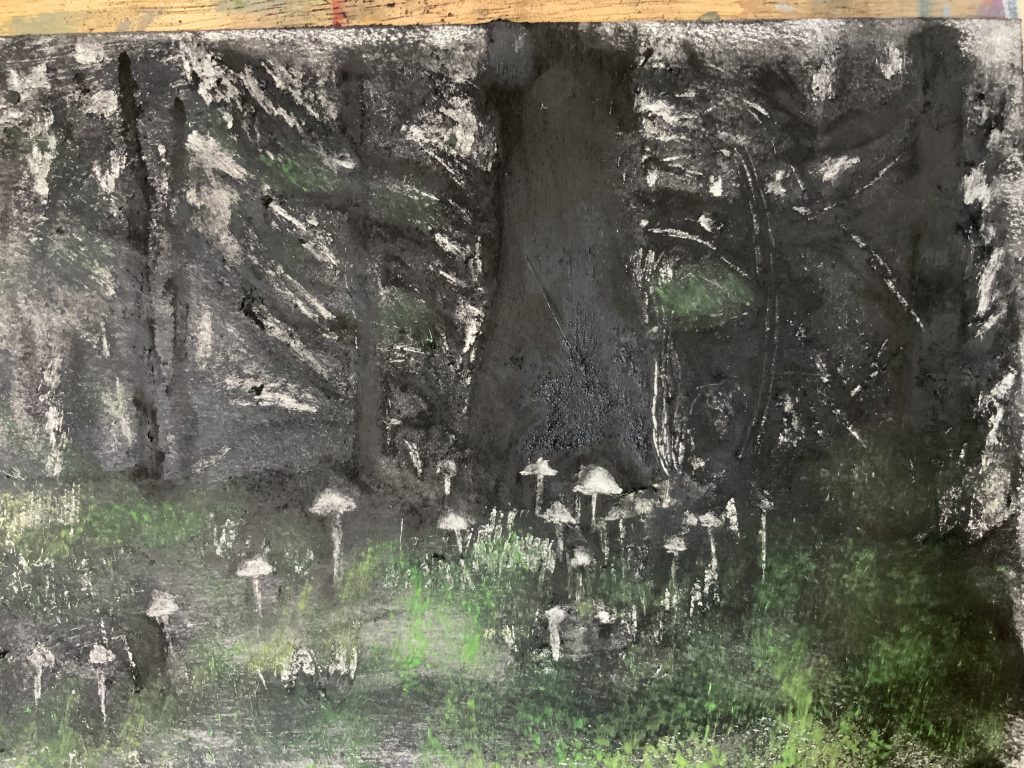
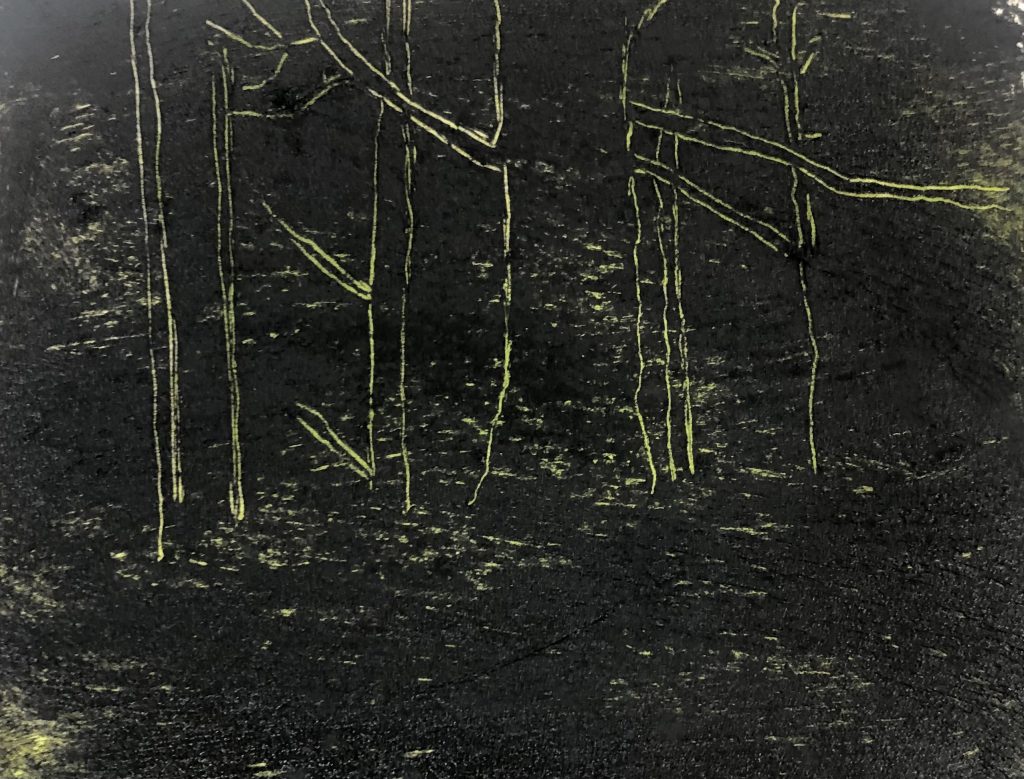
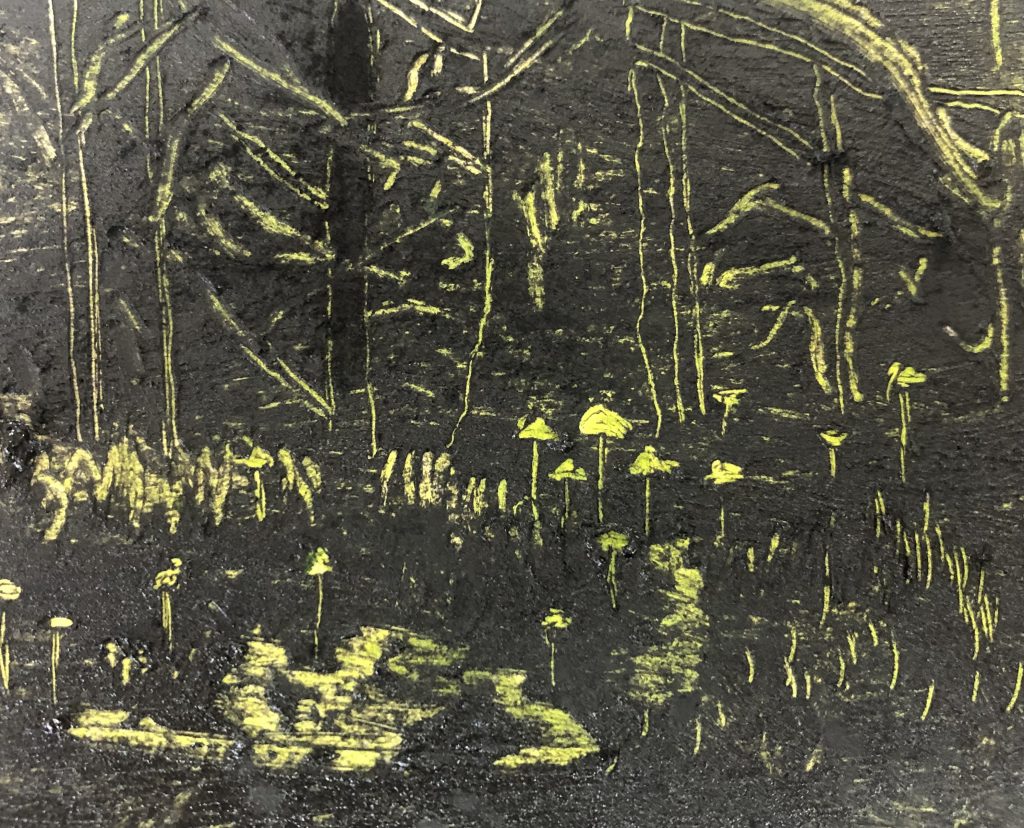
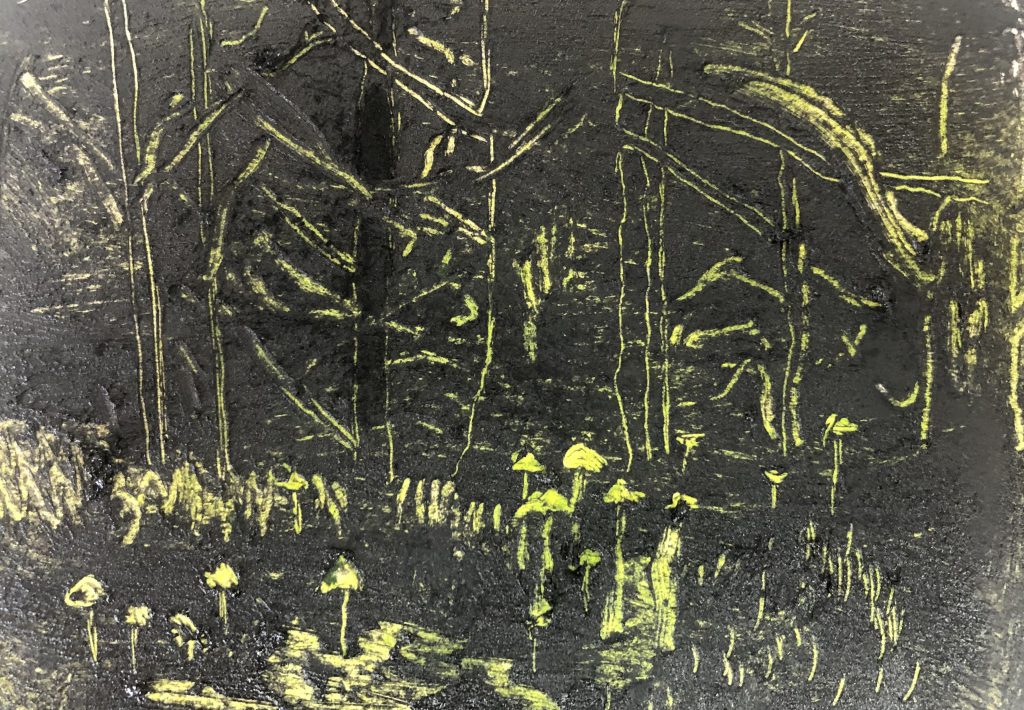
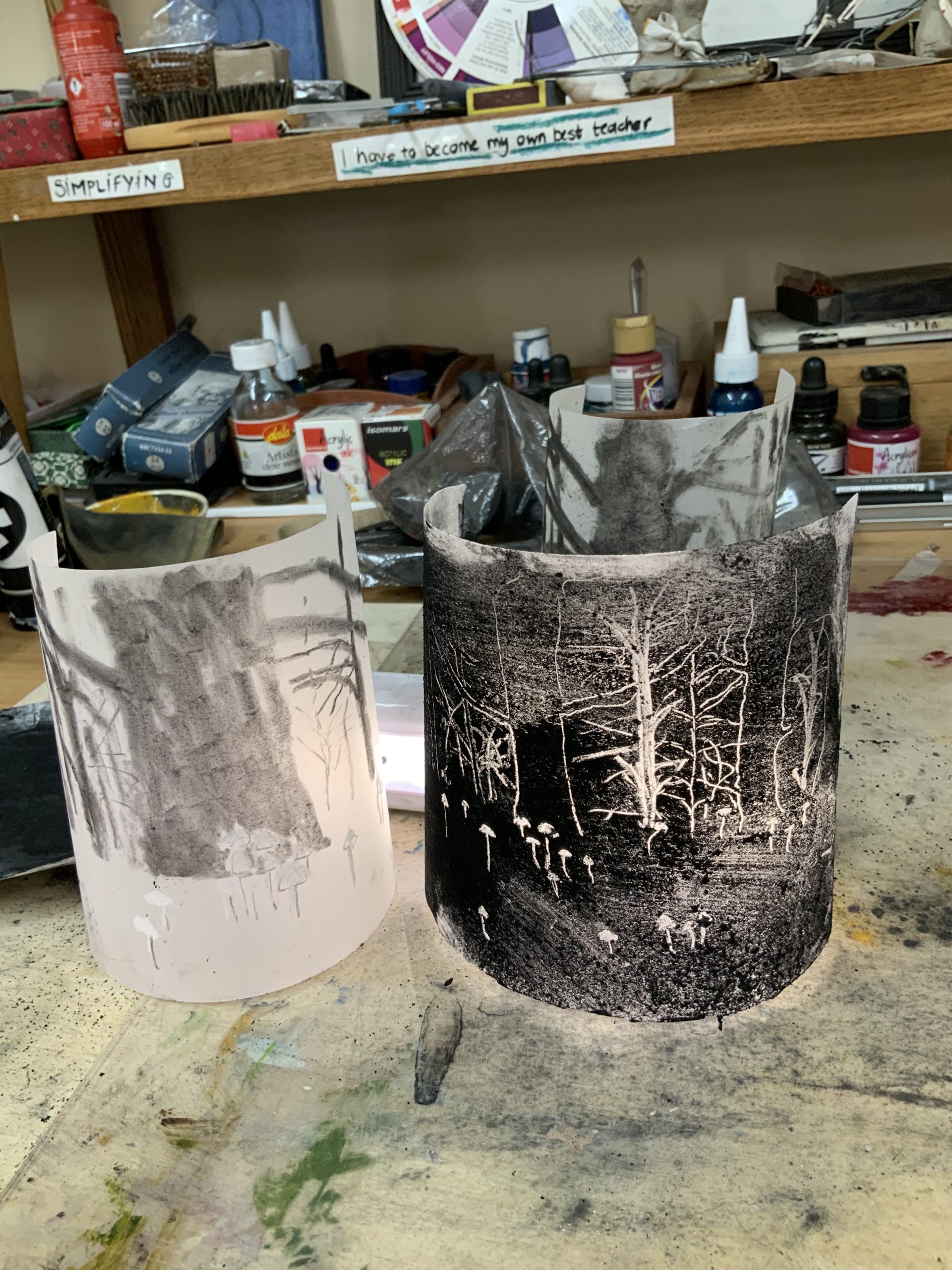
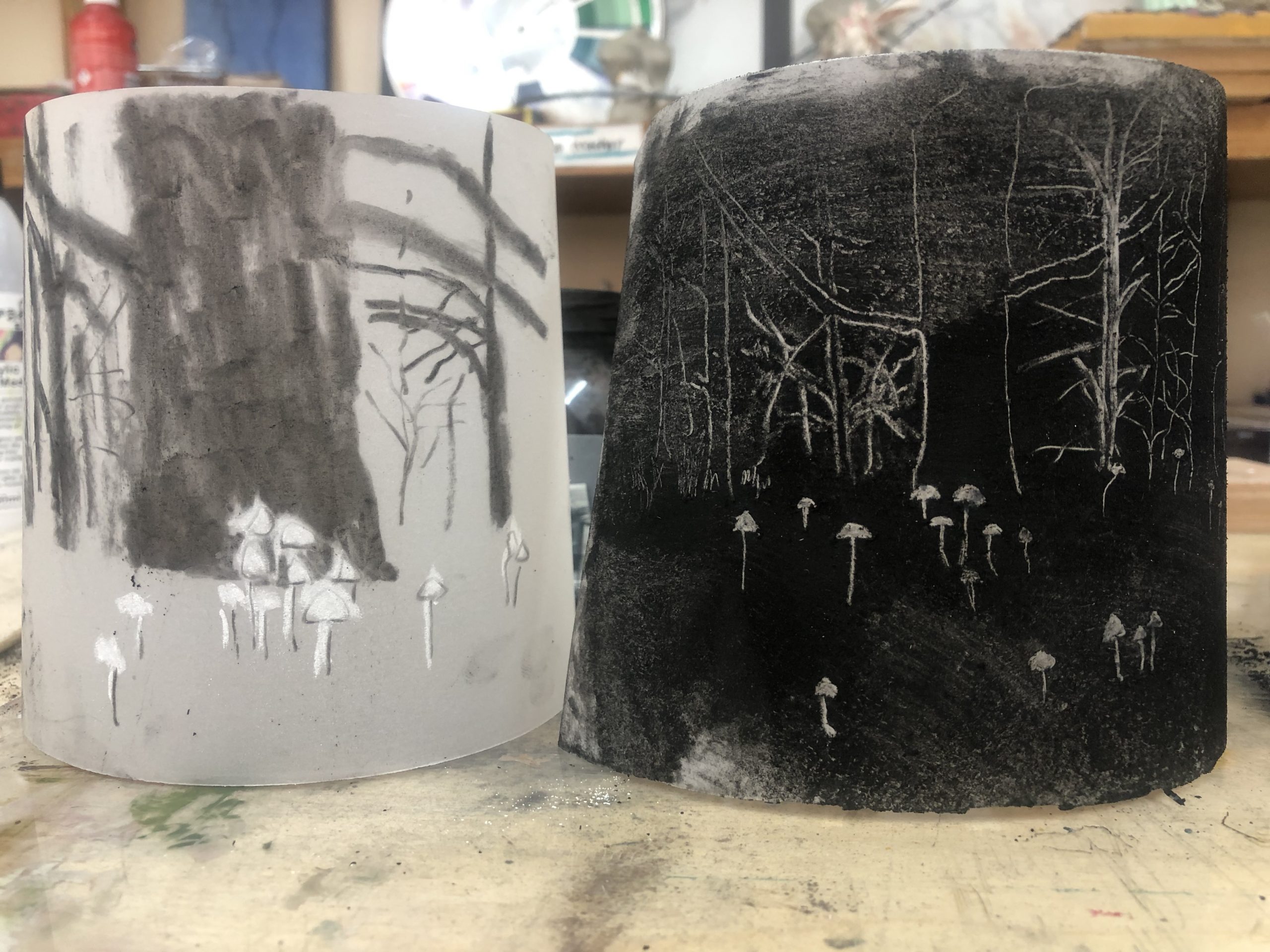
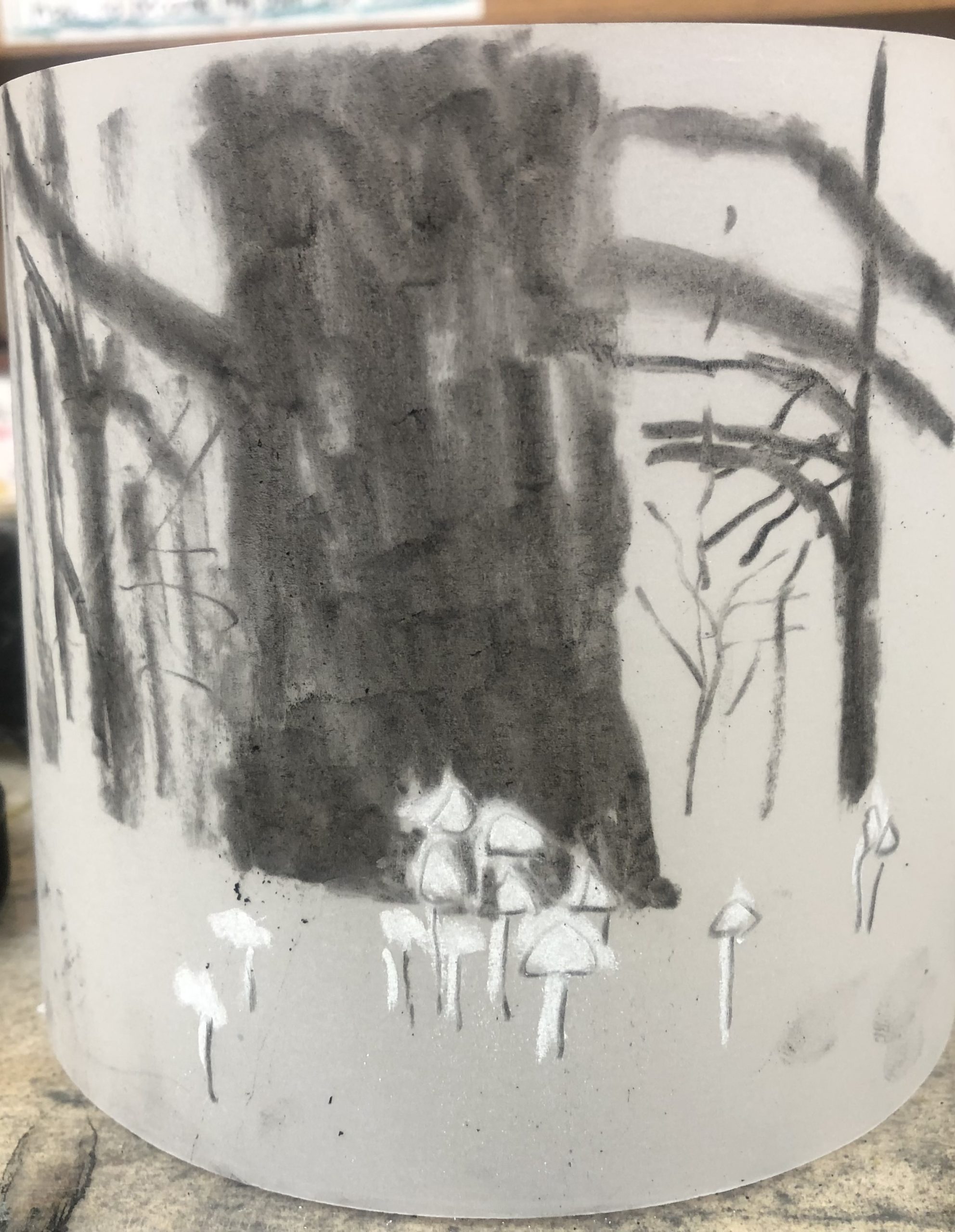

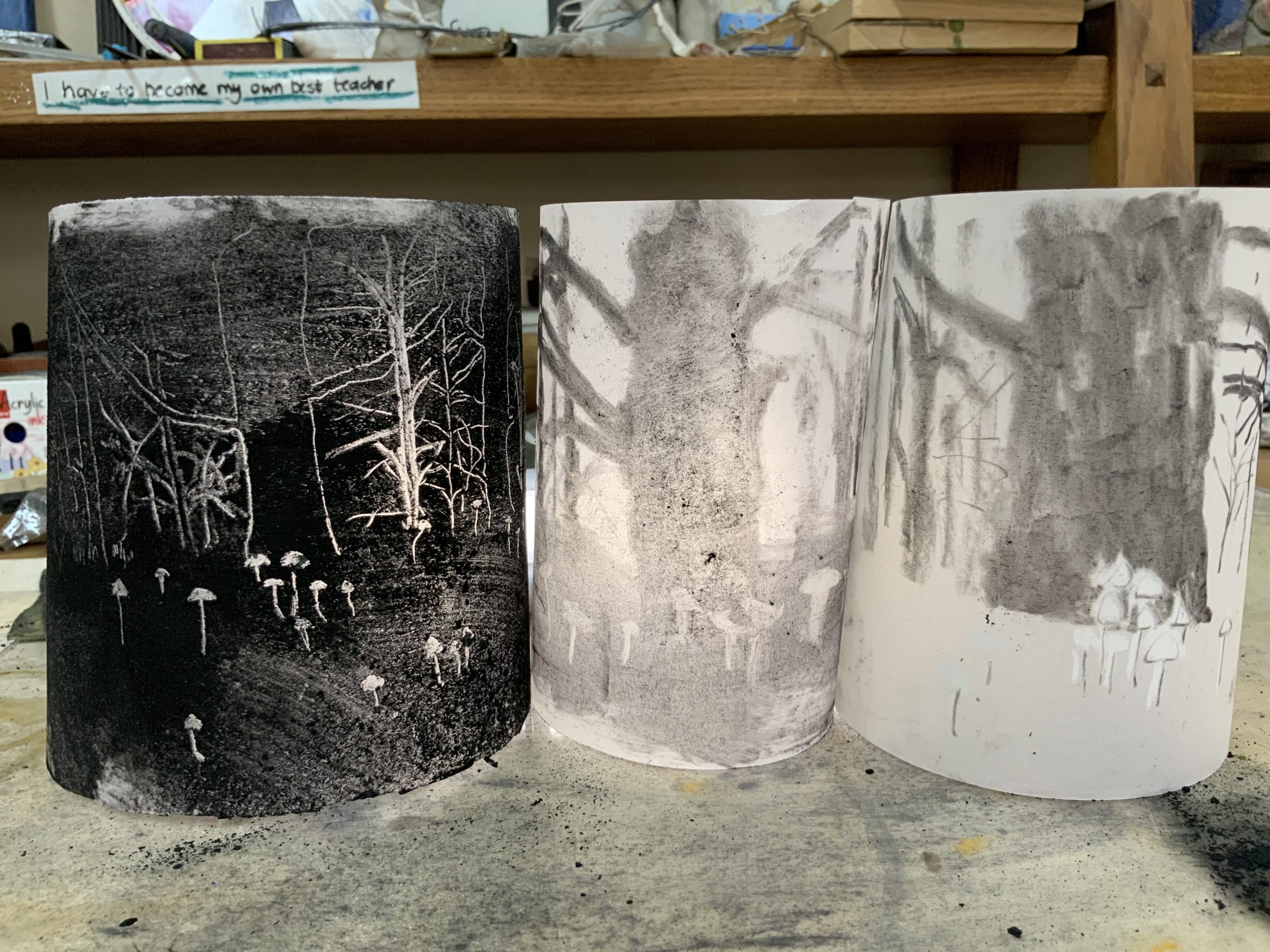
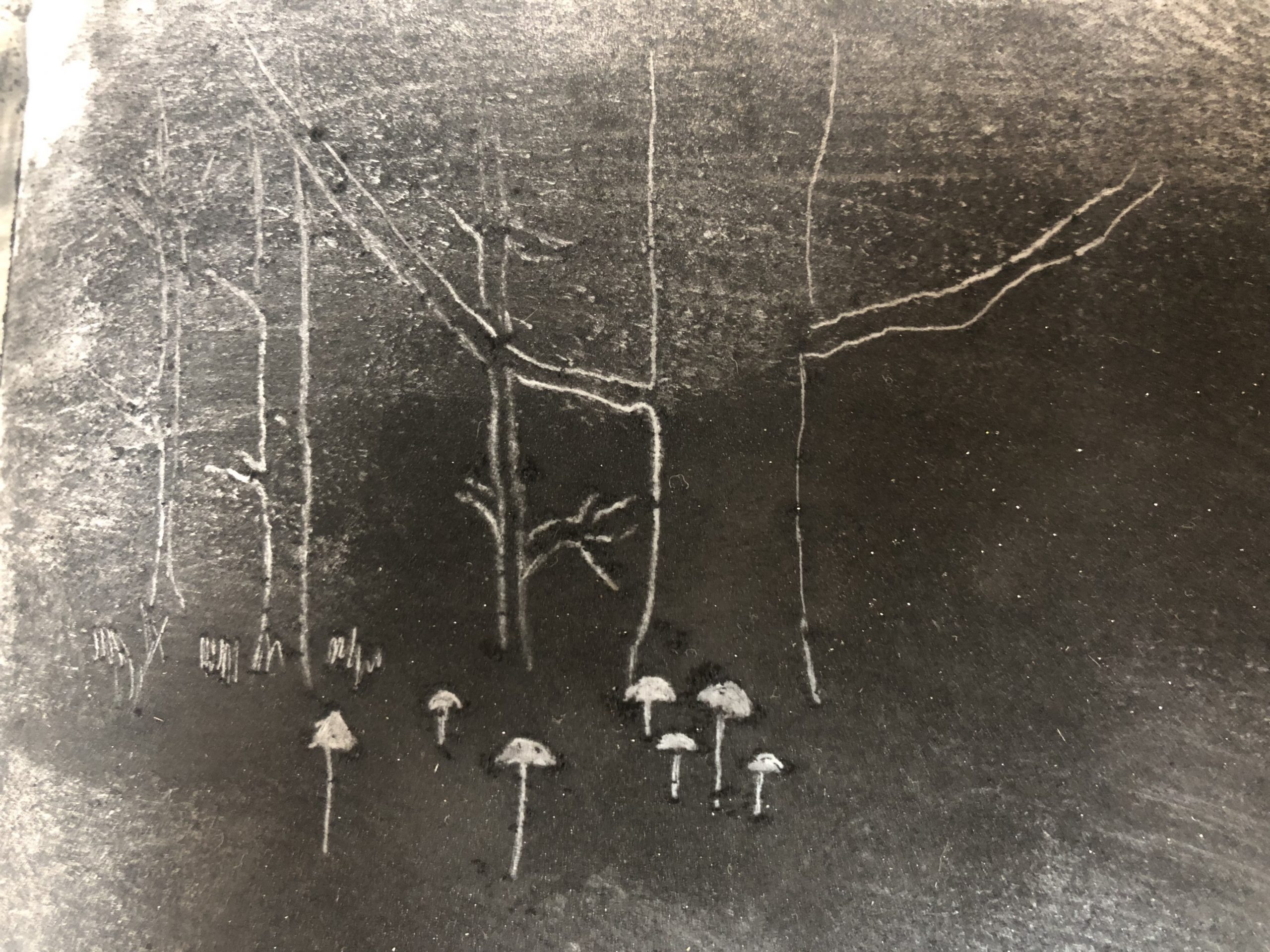
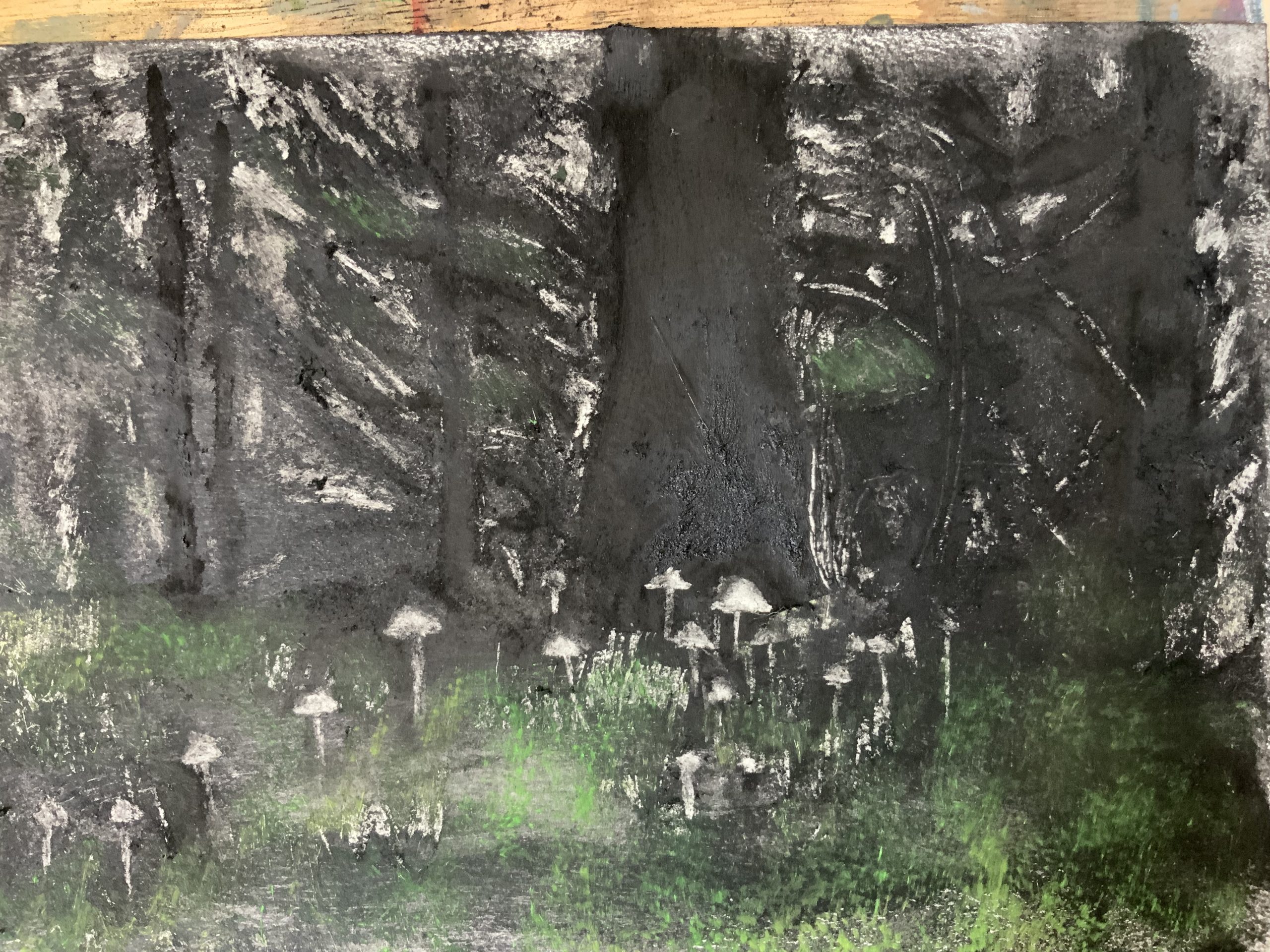
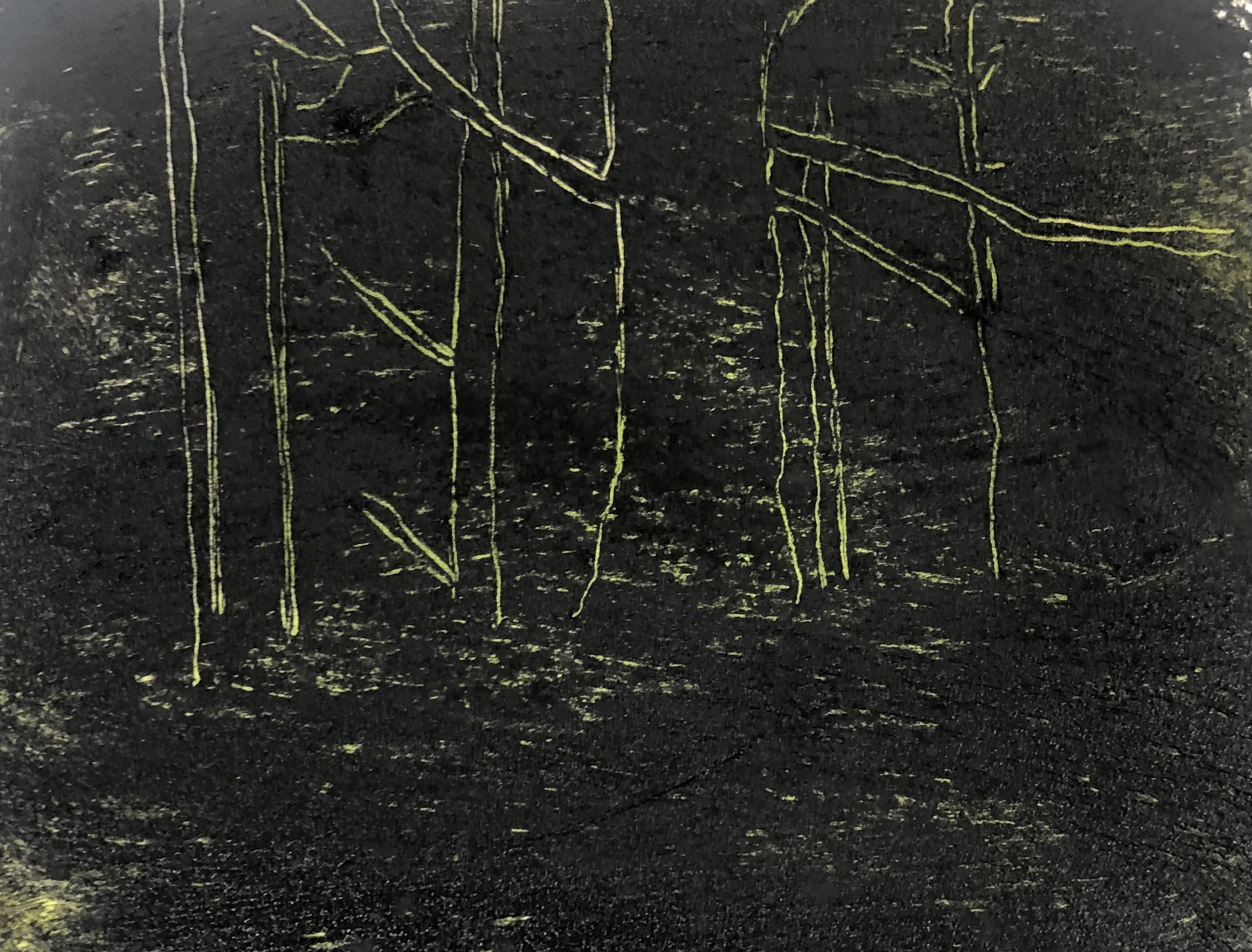

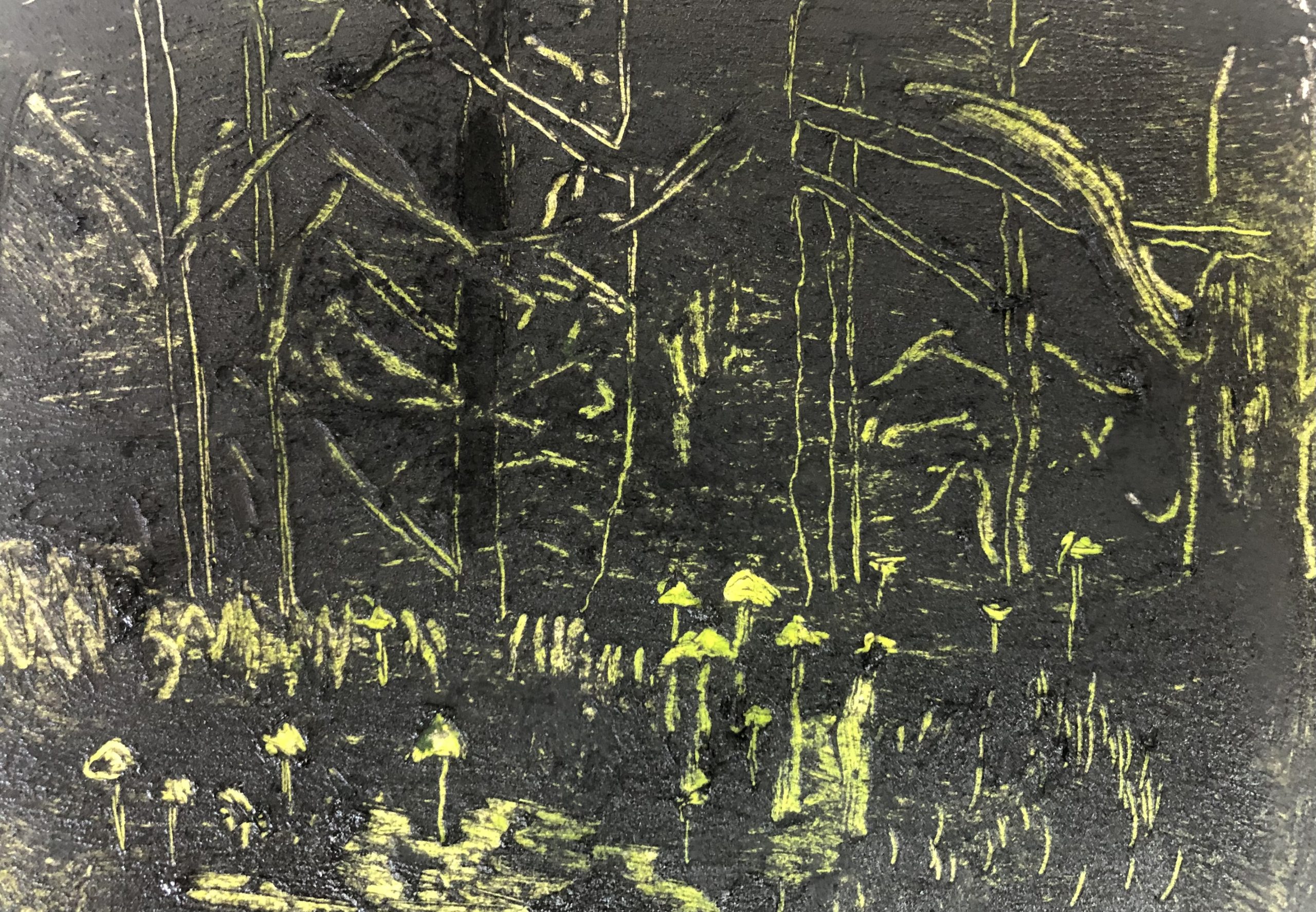
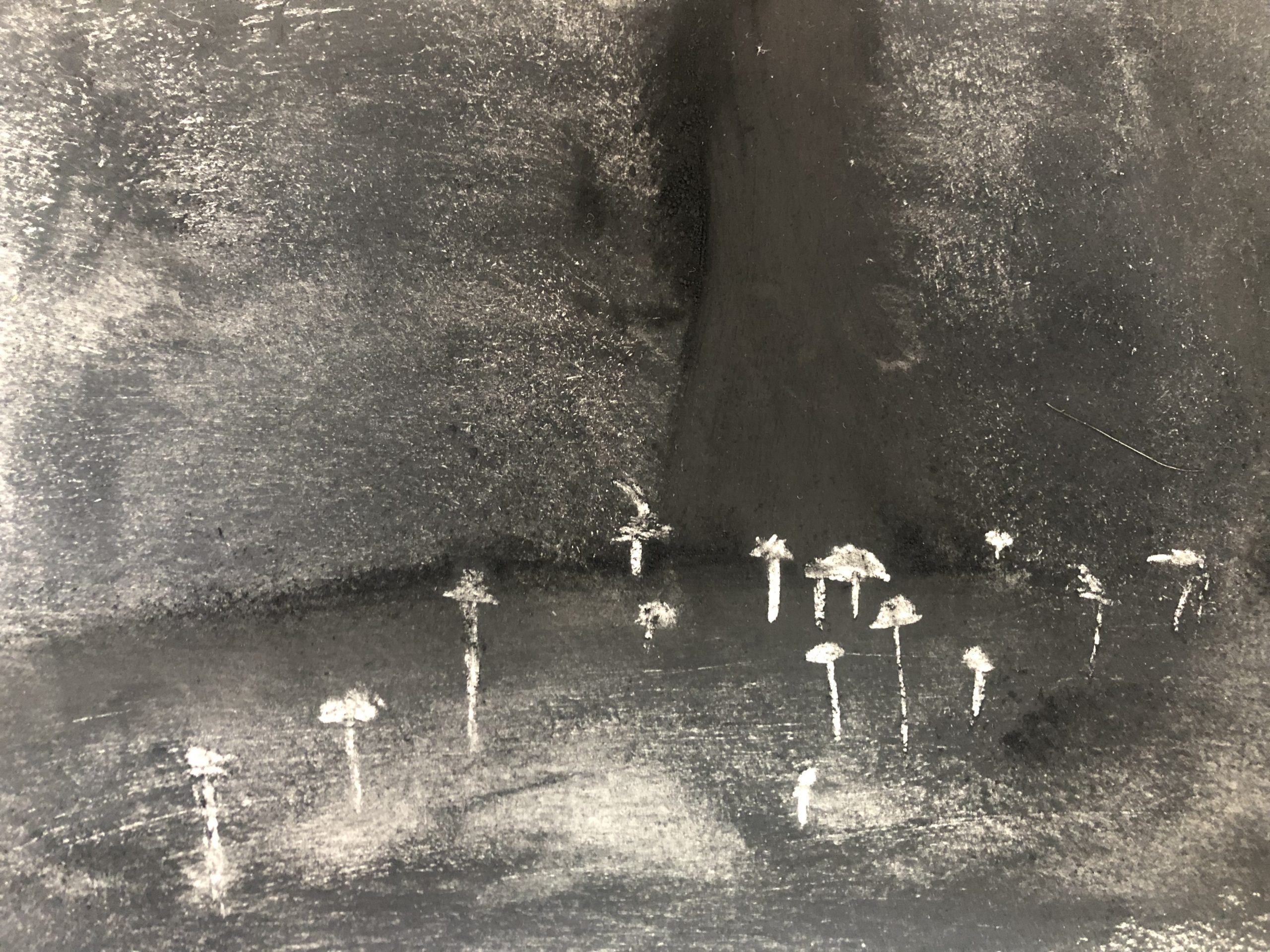
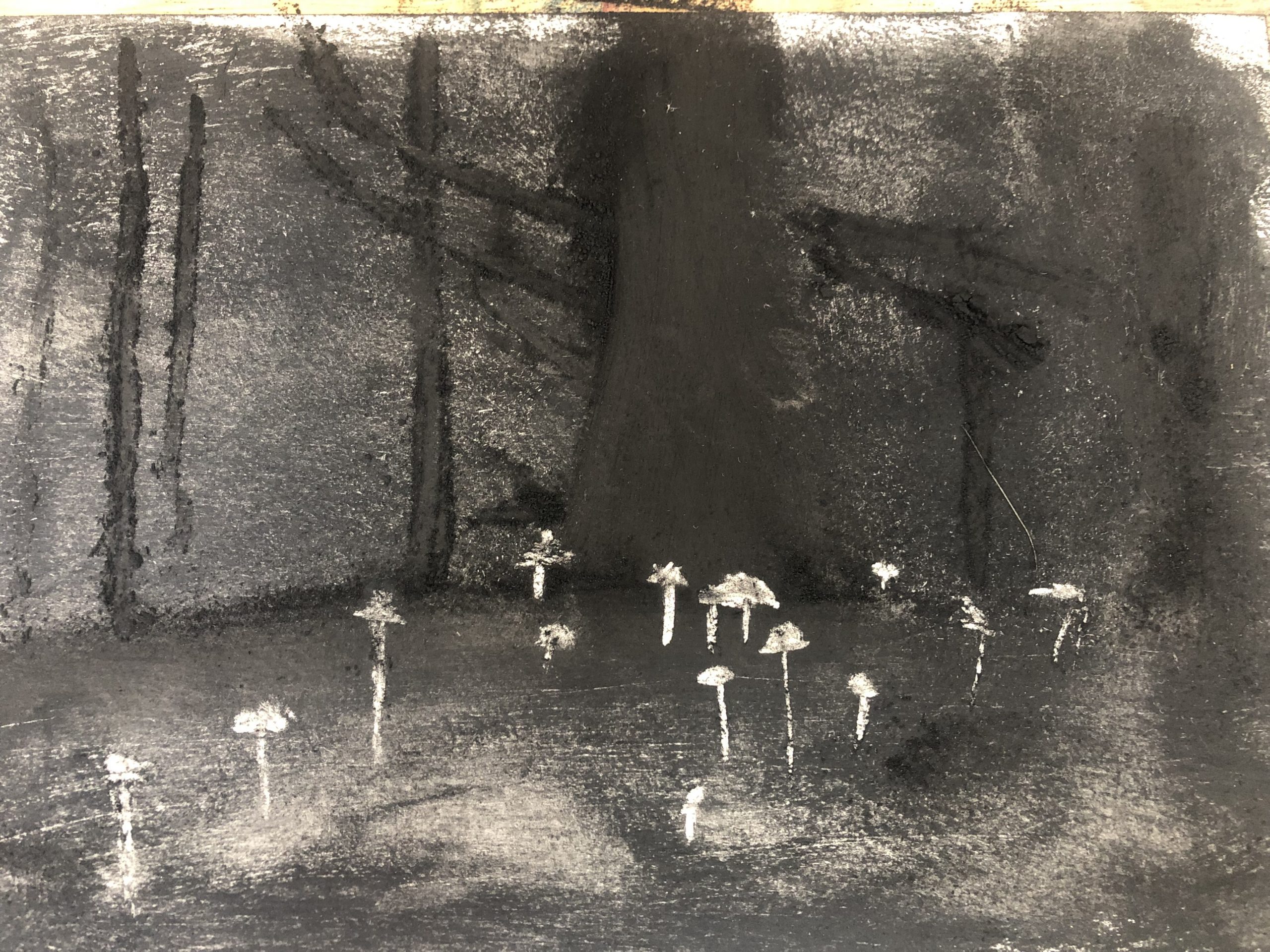
I decided to explore the work on a bigger piece of Vellum paper and had to move to my dining room to make the drawing. The size of the paper is 85x130cm. I am working on a flat surface (dining room table), in order that I can walk around the work, and have access from different places on the surface. I remember reading about the work process of the artist, Claire Woods, recently, who trained as a sculptor and spoke about her work on the flat surface (trestles or on the floor) when she paints on aluminium surfaces (big):
” I paint flat, so the painting is horizontal and that control is really important. When you’re painting while standing up, you’ve got this very small area of control, whereas when I’m walking around the painting, I’ve got much more control of the movement and pressure of the brush. I studied sculpture, so when I’m making these I think of them as objects. ” (Ocula edited the transcript of the interview).
As the work developed I realised that Annette and I could use this work as a backdrop for her sculptures, which could eventually evolve into a digital collage. Thinking about the paper as eco-friendly became a bit of difficult terrain, as most of my research could not really clarify this, as it seems that even vellum that is 100% recycled is typically made with plasticised cotton, so it has a thin poly-based coating on it, and the material is neither recyclable nor compostable.
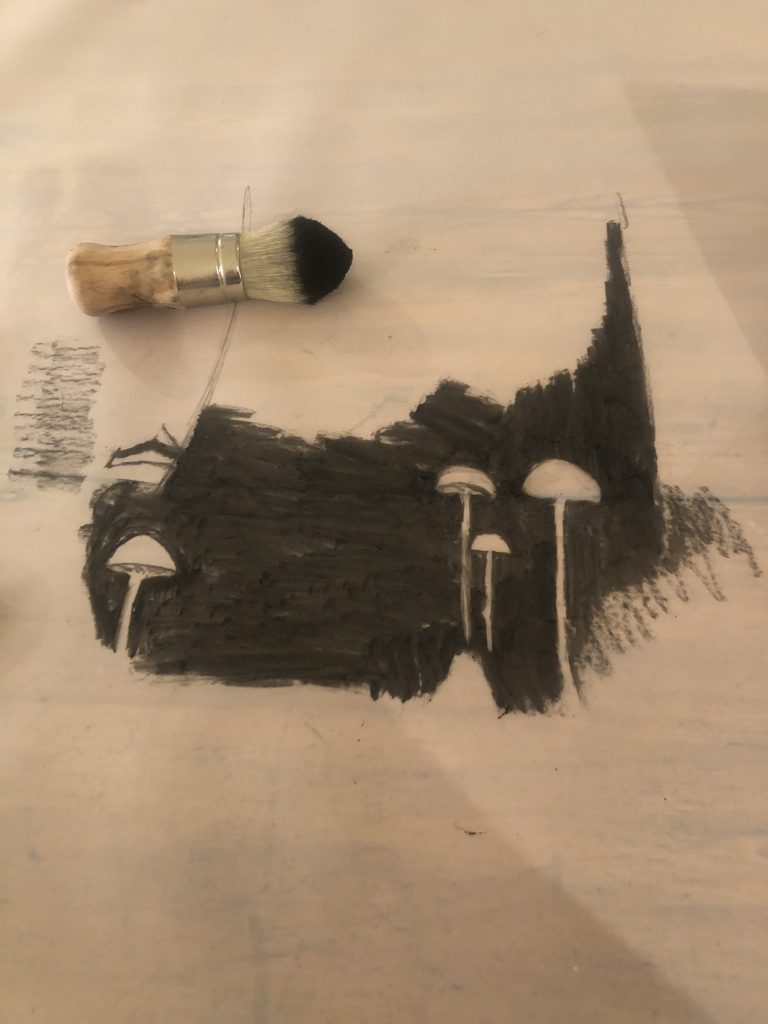
In my making it became clear that I would like the little mushrooms to be almost luminescent and work with tonality. Below are images showing the progress of the making. Somewhere notes shared between Annete and me read as follows: “working on a bigger drawing and somewhere in this fungal kingdom I take imaginary walks, going through my charcoal phase, the light must be from within”
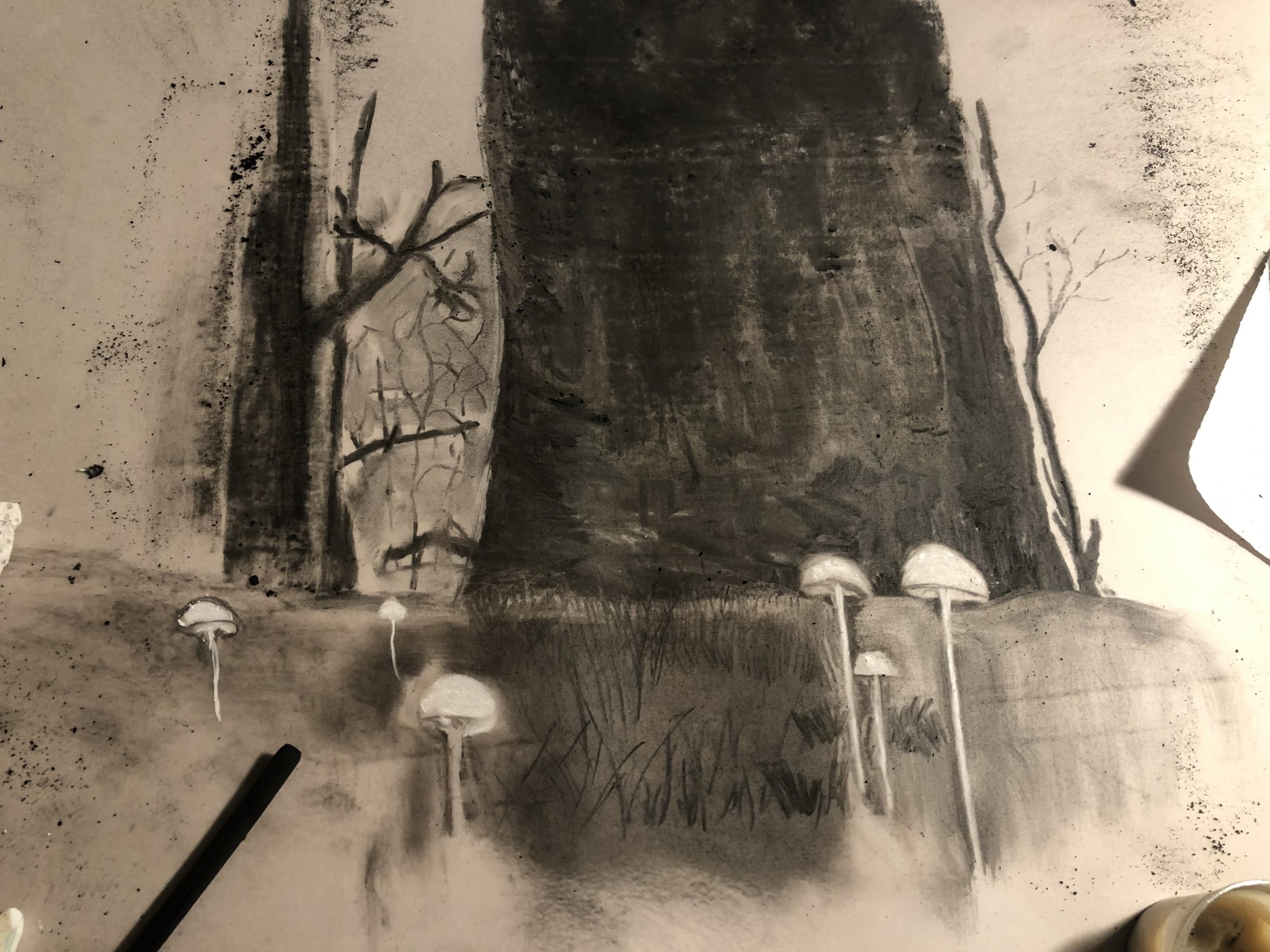
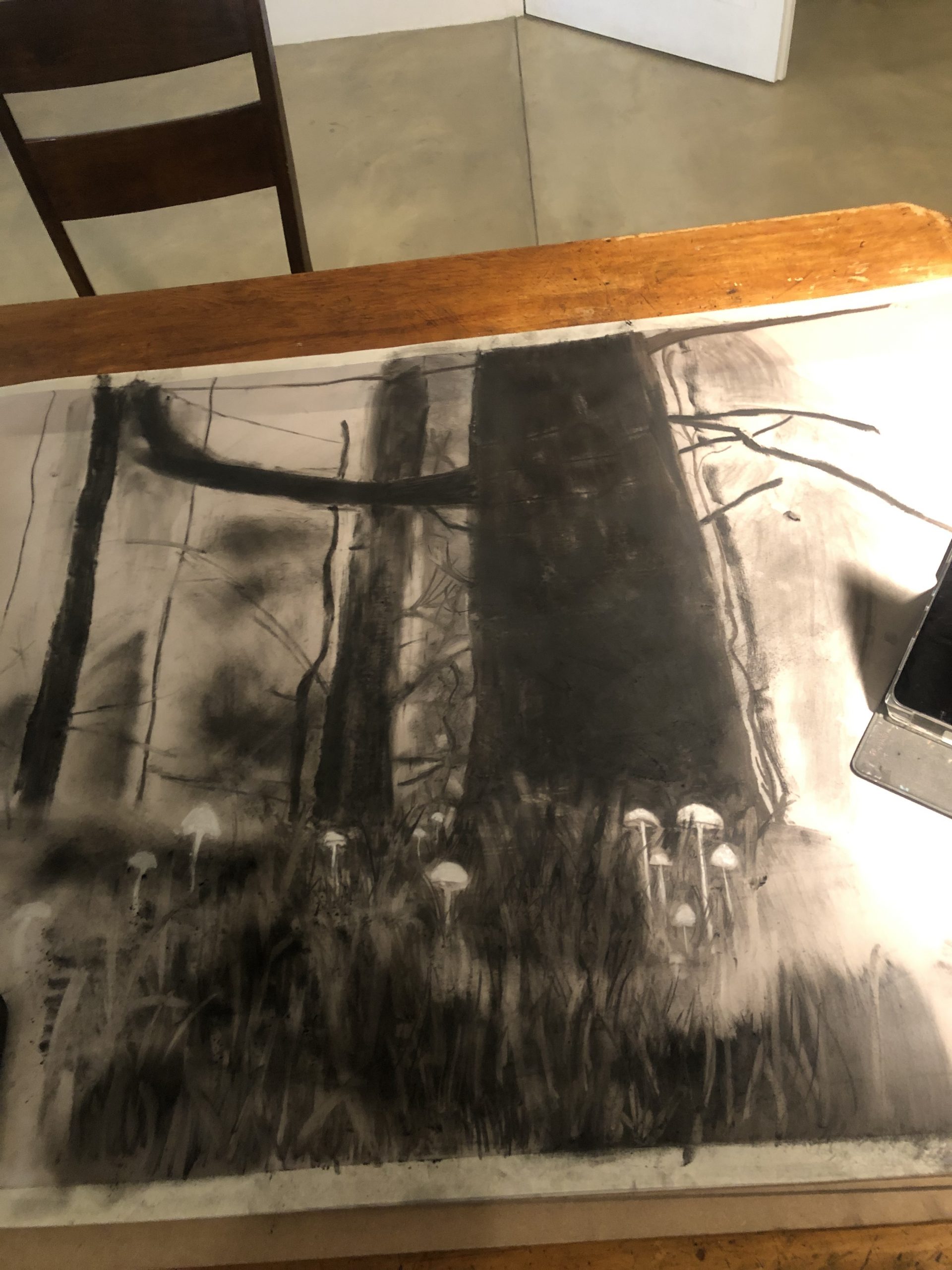
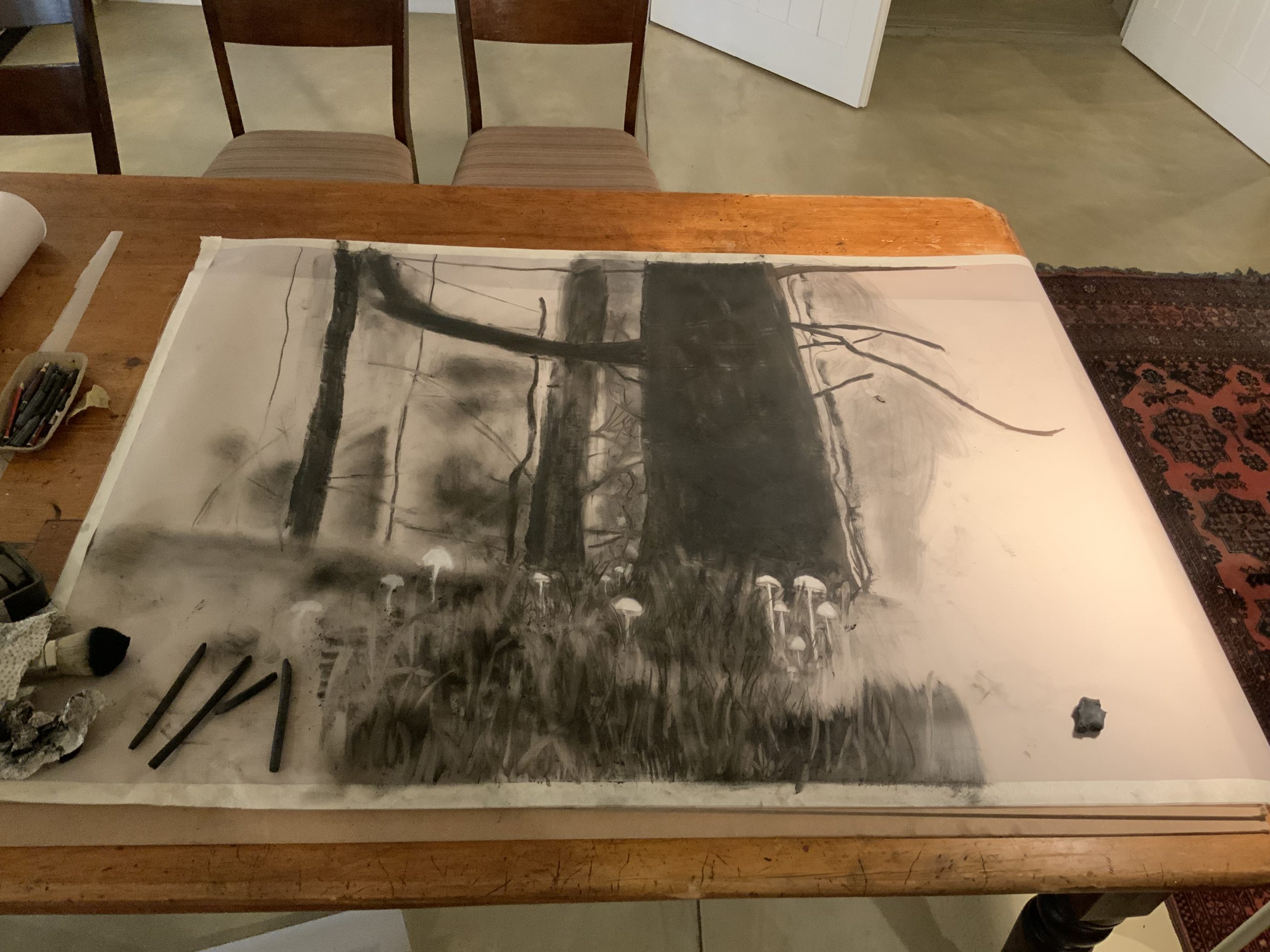
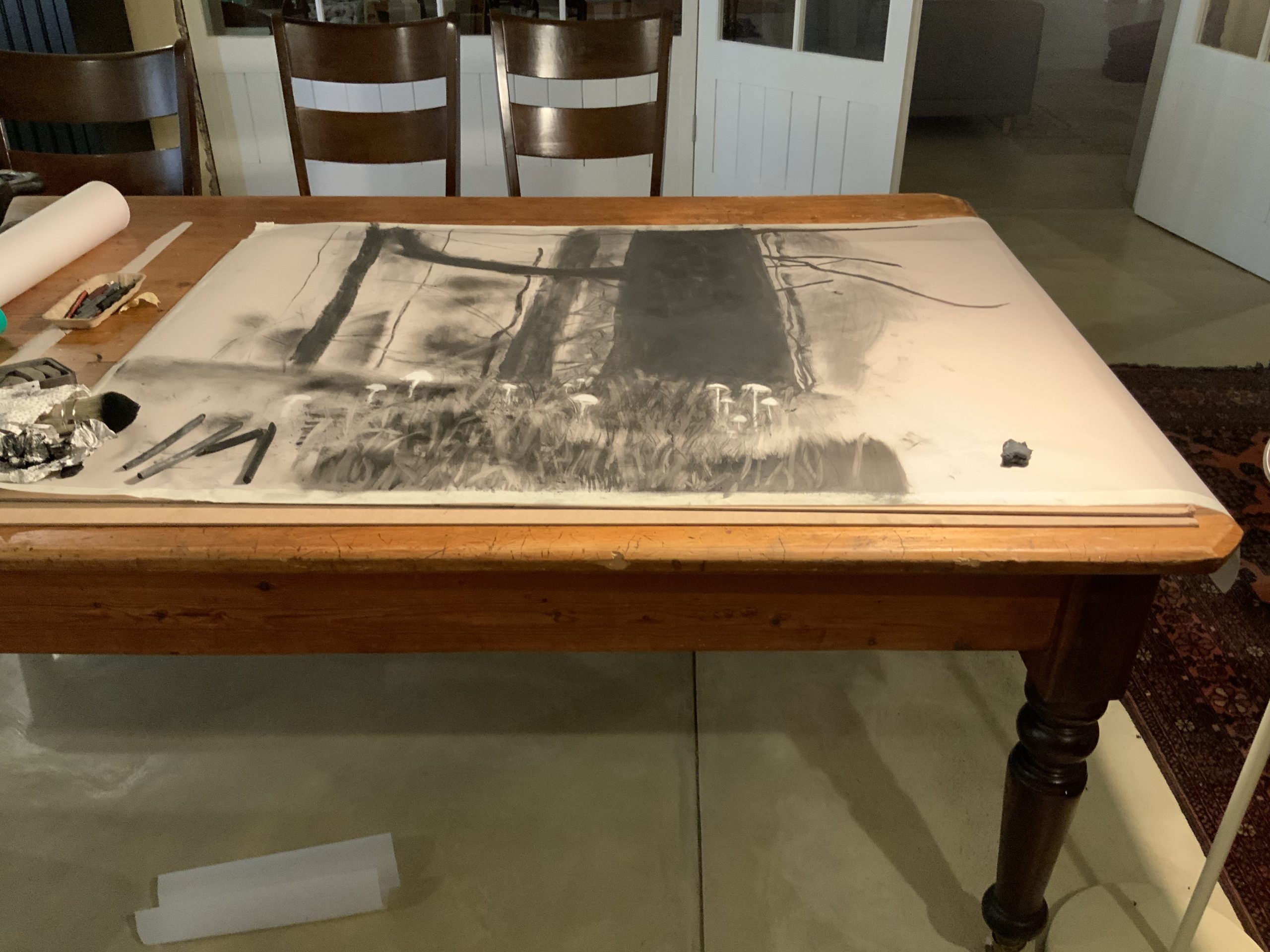
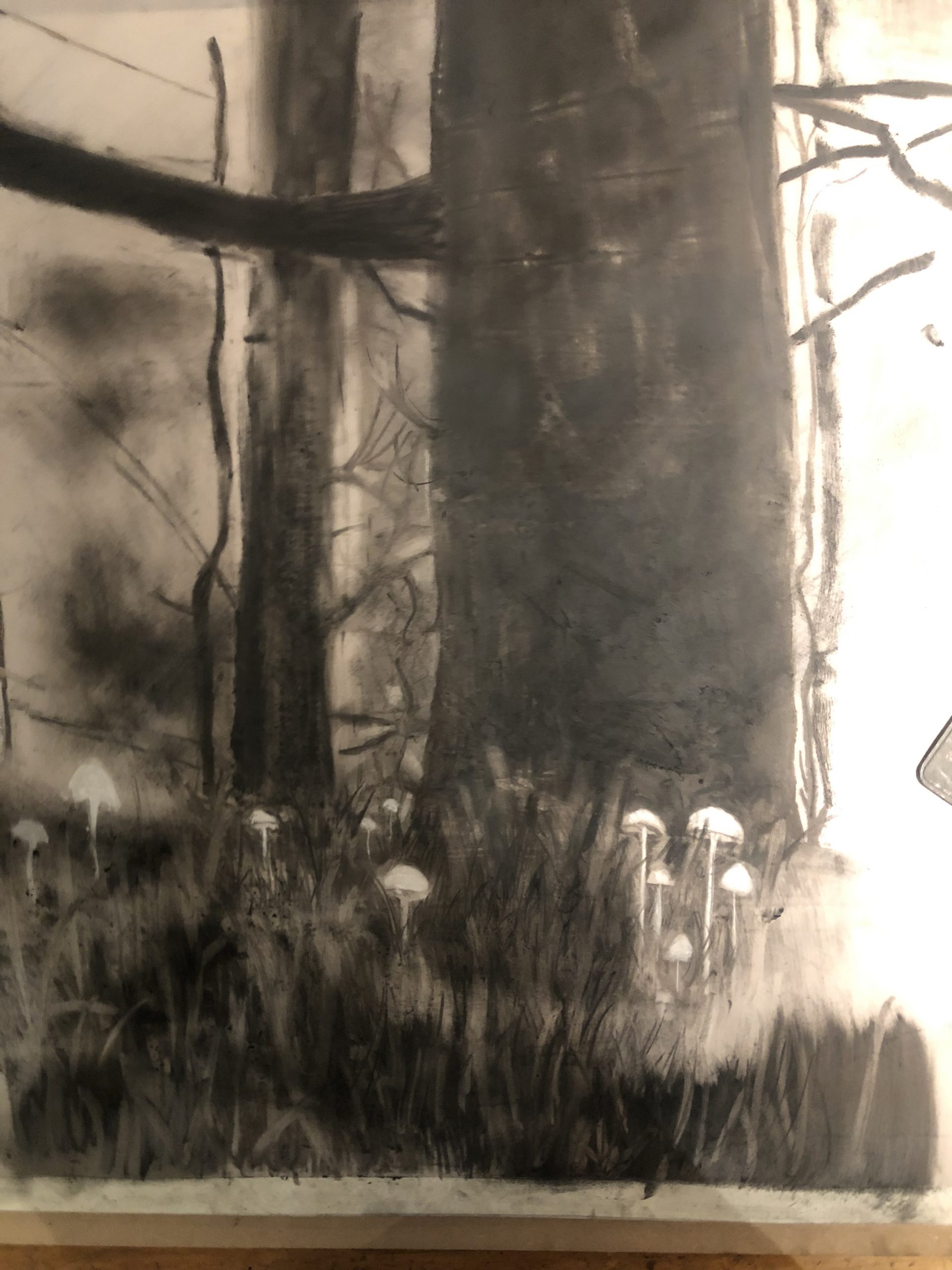
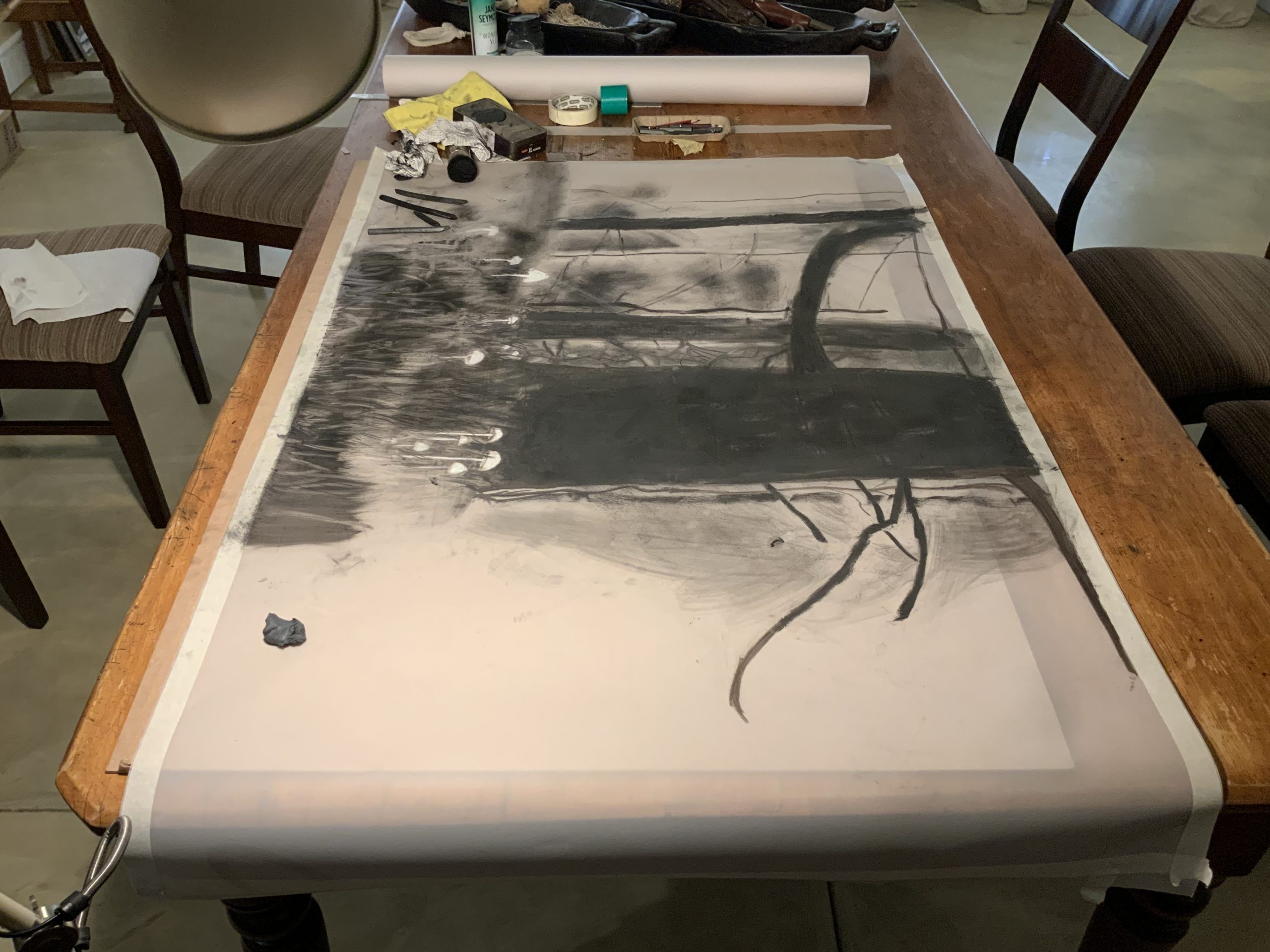
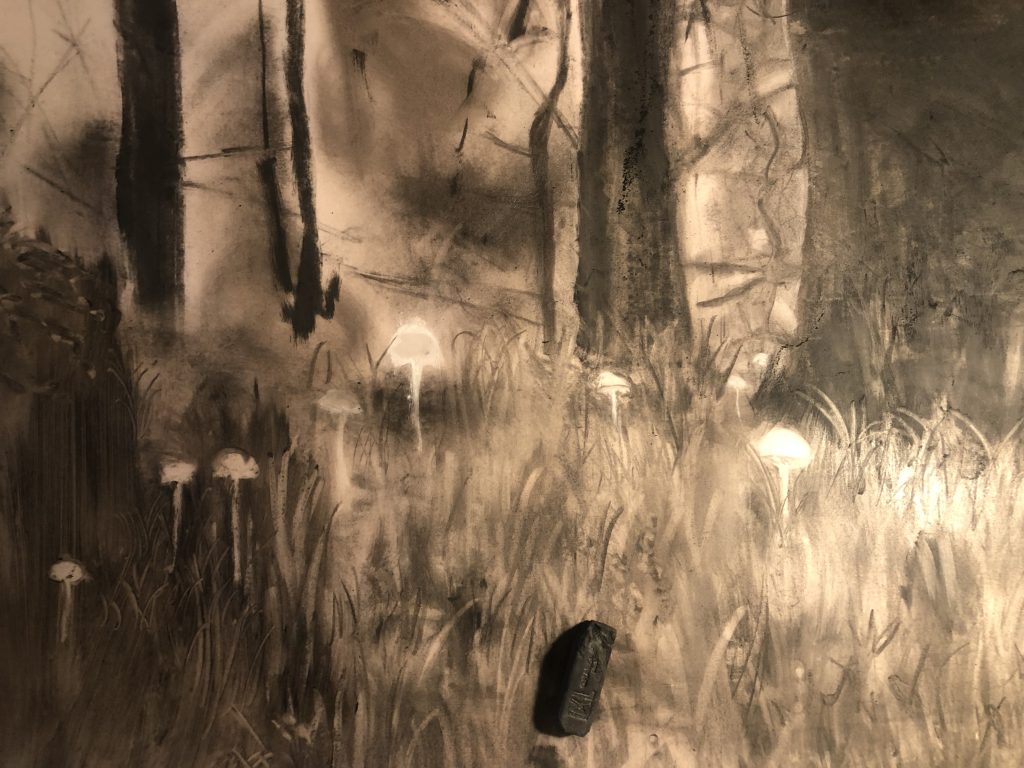
I found that doing the grasses I can use big gestural mark-making and move the material if I think is needed. I started rubbing in some wax to cover the bigger areas. I find that I can more easily erase this surface and work with a wider tonality. In terms of what I am drawing, I am focused on creating 3d mushrooms and trees in this work. I had been thinking about what drew me to this image, was it the moment of encounter, the atmosphere in the wood, the fragility of a short life? Is it about the mystery that happens anyhow; I know that even if the photographer was not there to capture that moment, the mushroom’s ‘appearance’ was predetermined by factors I do not even understand, that could be part of the enchantment…..then they are also alone, living for a short moment, a metaphor for life?
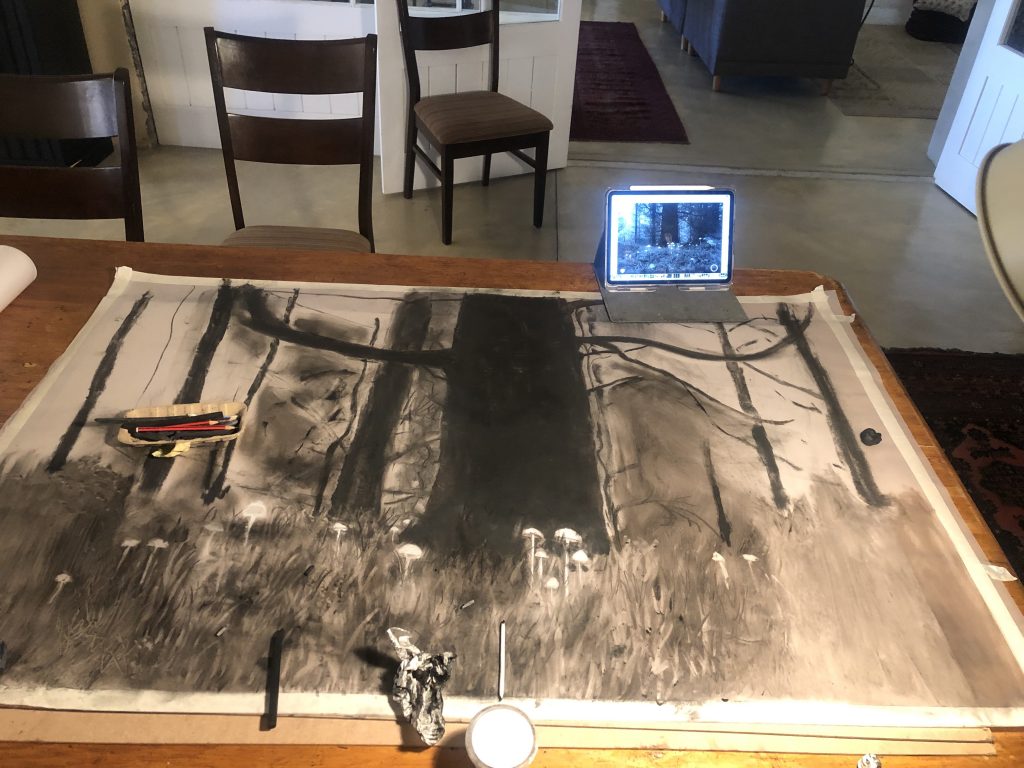
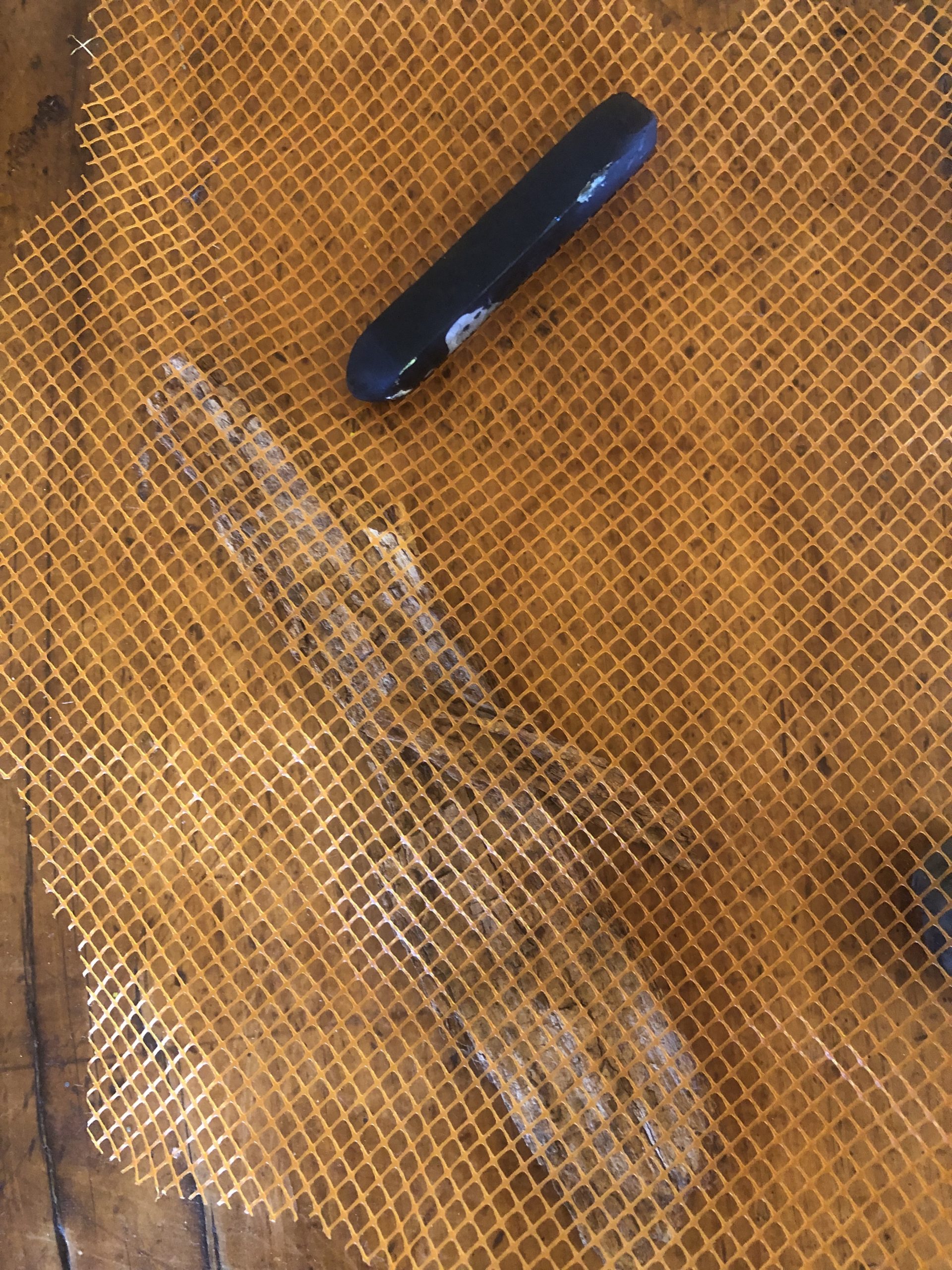
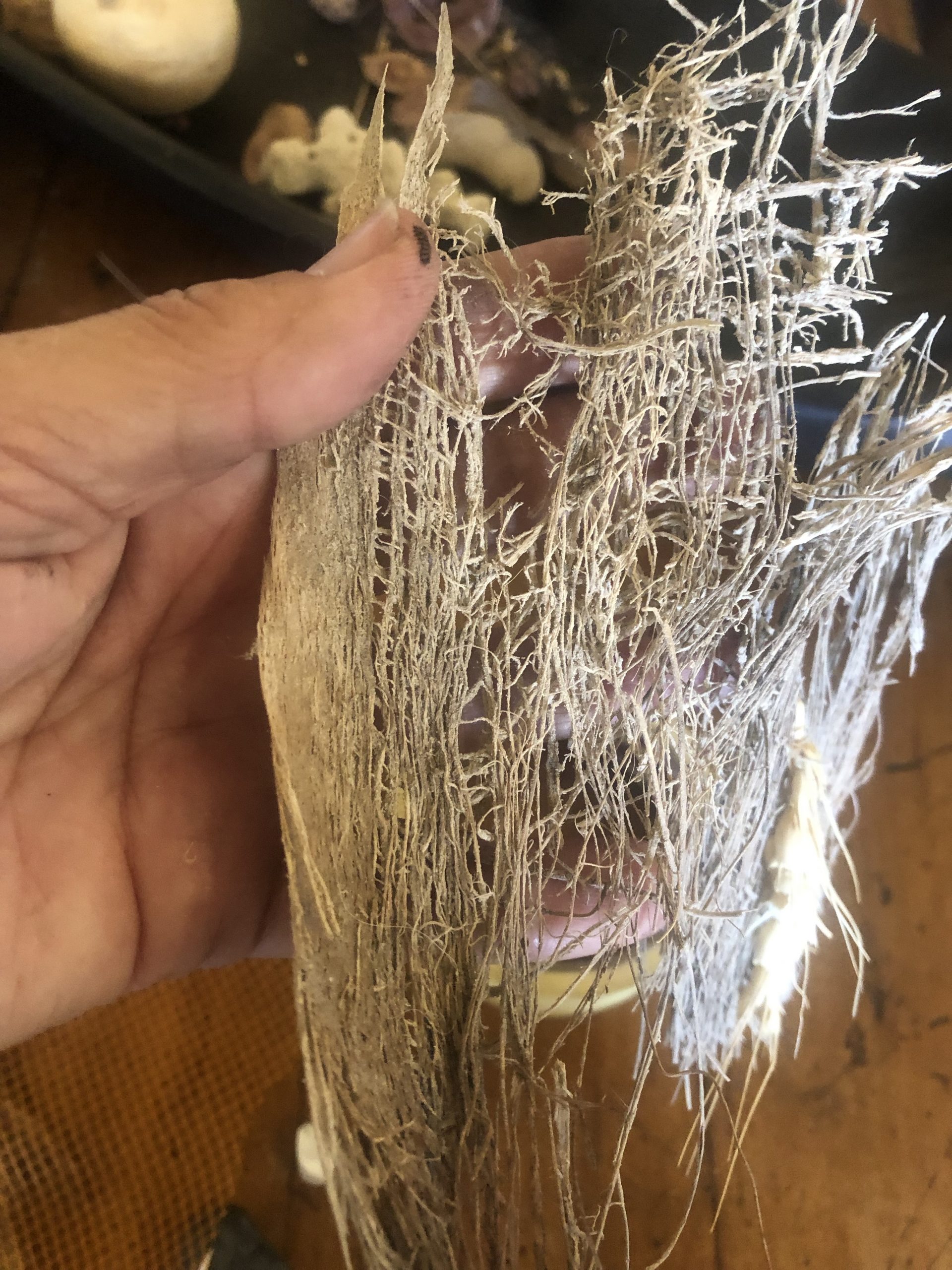
I used the above materials as textures – could place them under the drawing and by using charcoal as well as an eraser I found I could add texture to the bark of the tree. By now I realised that the big dark tree became a strong feature in the painting, and I could not really change the work. The fact that we will work digitally became a solution. Annette and I decided that it could be better to ‘crop’ the image so that the eyes of the viewer would be guided from the mushrooms to the light, and the big trunk would be less in the middle of the picture plane. In a way, we can see our work come together. We looked at cropping the work, using the view differently, and as friends and students in the group about the composition. Should I add colour to my work to connect with Annette’s work?
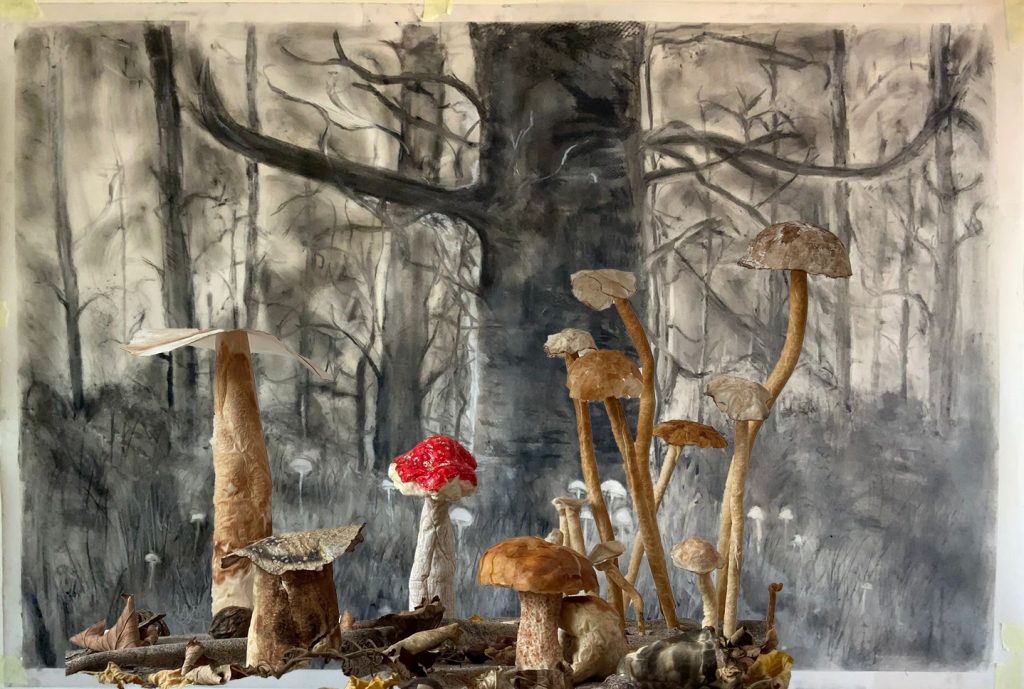
We can now look at this work as a collaboration or fusion or digital collage of drawing and mushroom sculpture. Annette can make separate sculptural installations of her work. Below is some feedback we received:
- colouring is beautiful
- the pop of red works well
- can we find a way to transition the mushrooms into the drawing
- could use some of the mushroom colours in the drawing, or reverse and add grey to the mushrooms
- consider using photoshop and placing the made mushrooms into the drawing
My tutor shared the work of artist, Emma Stibbons where one can consider if the work was in the real world, the sculptures would be placed in front of the work. How would that work? Her wall drawing is a 5m wide installation called Wild Fire. The work is made up of 6 panels put together. It is drawn in charcoal and she also includes 3D elements of salvaged burnt timbers. Looking at the scale of the work it feels like one enters the work, a great way to connect a viewer with the effect of global warming and the threat of wildfires which are becoming more frequent. I enjoy her close scrutiny of environmental concerns and it also remains me of the work of Tacita Dean I had learned about in earlier courses.

Our final decision was to use photoshop and place the mushrooms into the drawing. I think we are learning how to integrate the space between the drawing and the 3d objects. The image was cropped, which worked better as a composition. In a way, the mushrooms in the drawing become a mirroring of the 3d mushrooms in front of it. The work made me think of a work by Emma Stibbons: in her work, the artist placed real trees as 3d elements in front of the painting, very much like what Annette and I are trying in the above collaborative work. We considered that I paint a colourful mushroom into the work. I considered making a new drawing of the cropped version but then worked more on the Right Side of the drawing, by trying to create a denser/darker area ‘behind’ the prominent tree. We also decided to keep to the tonal dark colours of the charcoal and not add paint pigment onto the work. In hindsight this was a good choice as we decided to let the work decompose/deconstruct as natural as possible, outside in nature.
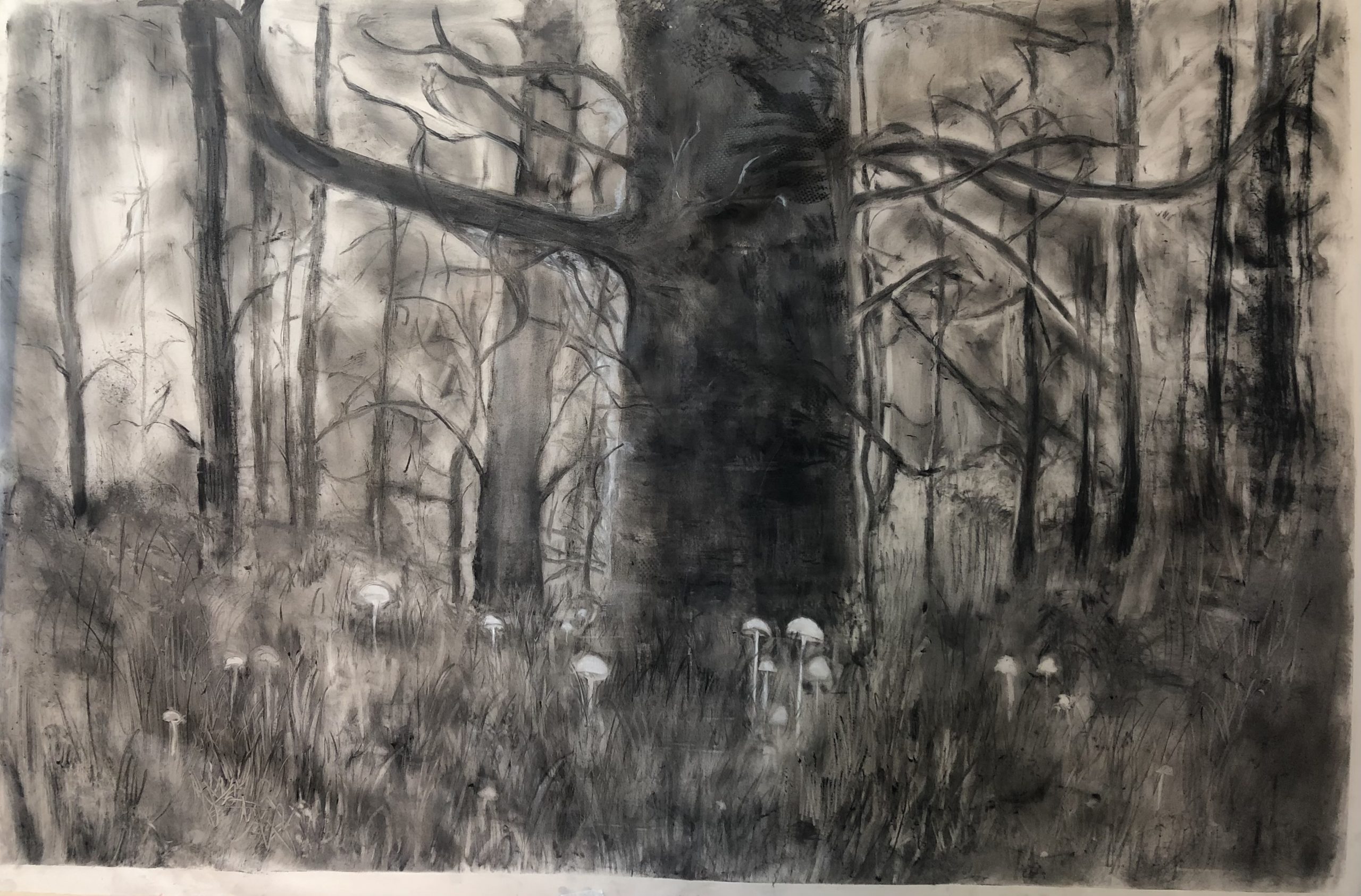
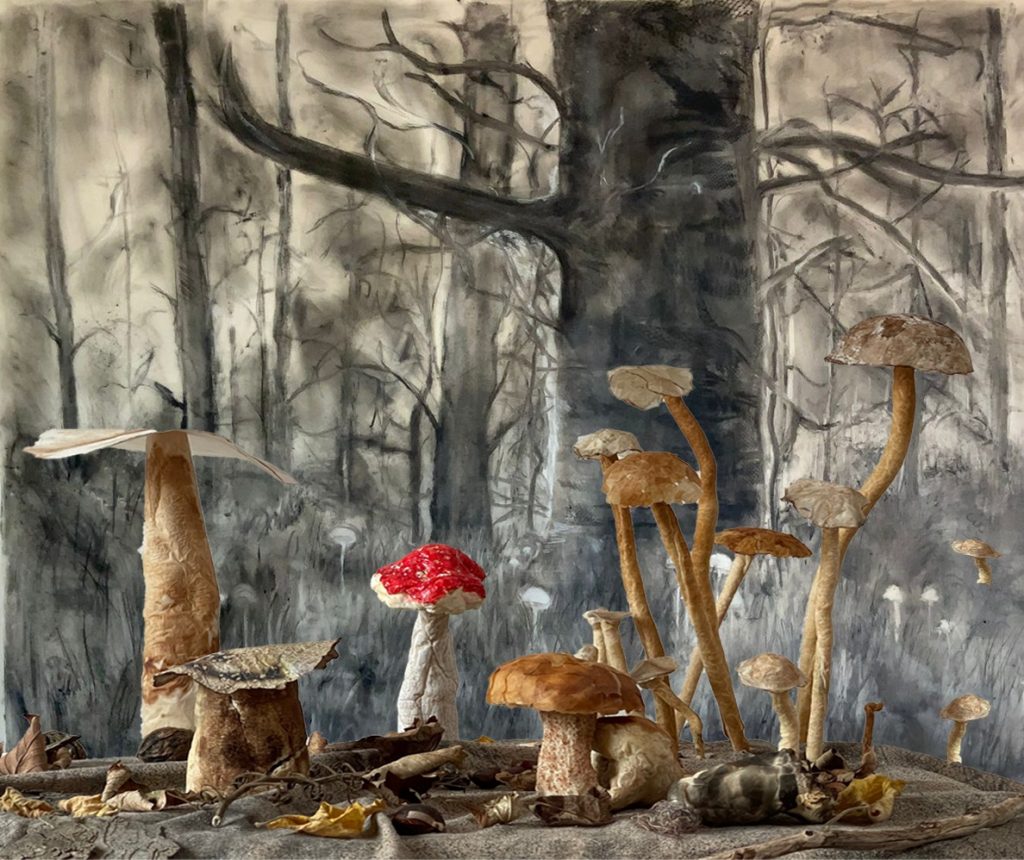
From Tsing, I learned that collaboration could be ‘multi-sited’ and have ‘friction’ at its heart. When I think of the student collaborative effort to work towards our joint online exhibition I also understand how we came with different expertise and commitment and that our knowledge gain depended on that. Sometimes the division of labour could have been seen as part of it. I do feel Annette has done the final touch to our work, by bringing it together digitally. I will do my bit when we deconstruct the work later.
Our work was placed on the Kunstmatrix site as collaborative digital work and can be accessed till the end of October 2022 on their site. The WWW also have a website on the OCA Spaces site, and the works have been placed there to aid as a more permanent space of documentation. (https://spaces.oca.ac.uk/wanderwideweb/) Annette and I discussed our intention to see this work as a collaborative experiment of working in the digital space and considered how we could physically bring it together and let the fungi take over in work. We have both been reading Sheldrake (Entangled Life) and felt we owed it to the fungi from whom we have learned so much. As I have been starting to work with real fungi as material, we decided to get the work together with me, in South Africa. An opportunity arose where I could find a way for her work to be brought to me when my daughter-in-law visited Germany and Annette could post her mushrooms to her, and she then could bring it back to South Africa. (by now I have experimented with a print of the work, which I have placed on a growing substrate, and the decomposing process was working)
The work came physically together by early September and I prepared an area in the herb garden, which is conveniently located outside my studio. The work was placed there and inoculated with spores and then covered to create an environment where mycelium would grow and hopefully mushrooms would digest and decompose the work. I documented the process by regularly taking photos and or making short videos. This is an ongoing process till total deconstruction of the work has taken place – it became a time and place-based work. Documentation can be seen on a separate blog page on my website.
List of Illustrations
Fig. 1 Stander, K. (2021) Wunderkammer cabinet [photograph] In possession of: the author: Langvlei Farm, Riebeeck West, South Africa.
Fig. 2 Stander, K (2022) Wunderkammer cabinet [photograph] In possession of: the author: Langvlei Farm, Riebeeck West, South Africa.
Bibliography